Obsidian: The Age of Judgement: 2nd Edition by Barudak
(2)bsidian (2)rigins
Original SA post
Obsidian: The Age of Judgement is a roleplaying game by Apophis Consortium published first in 1999, and this review uses the 2nd Edition from 2001. Written by Micah Skaritka, Dav Harnish, and Frank Nolan. Obsidian is a post-apocalyptic anarchist corporatist literal hell on earth secret knowledge crunchy dice-pool game. It is purchasable online here if you’d like to support the authors of this work.
Part 1: (2)bsidian (2)rigins
Obsidian: The Age of Judgement, or as its front cover and only its front cover calls it “O with a 2 inside of it”bsidian: The Age of Judgement, is a 2001 tabletop roleplaying game. The work focuses on a blend of post-apocalyptic and dystopian themes mixed in with secret truths and christian influenced spiritual warfare that don’t mix together so much as congeal. I want to note that this might be the least clearly delineated second edition of any game I’ve ever seen. Based on reviews and their surprisingly, at the time of this publication, still active Facebook page the content seems unchanged at all between publishings and the developer introduction in this book references the year of publication of 1st edition. So little has changed that even the cover art still has the artist signature noting the year as 1999, so I’m not entirely sure what, if an changes, were actually made to this “second edition” except adding a “2” inside the letter “O” on the book’s title.
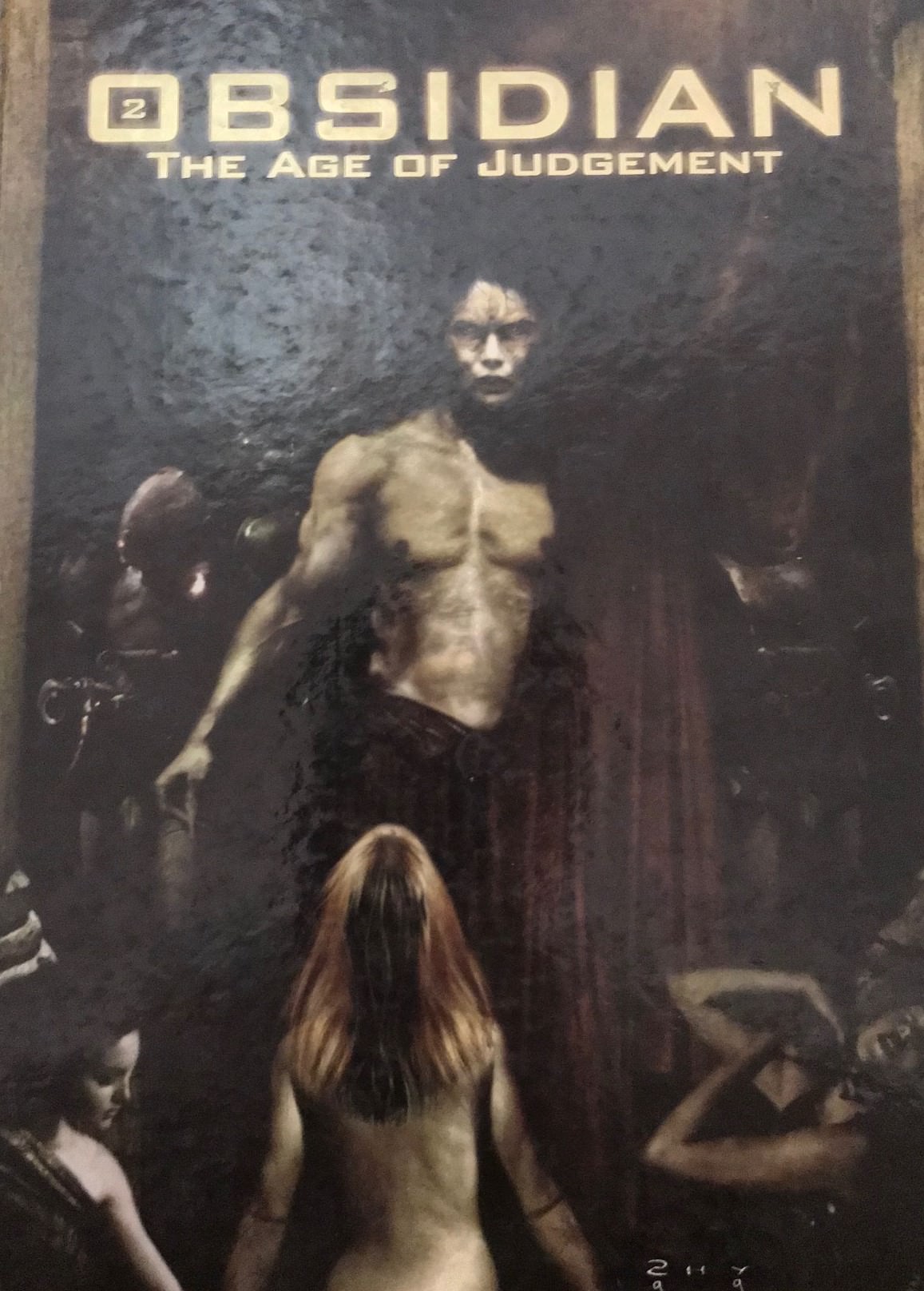
In the grim future, shirts are a crime
art by: Christopher Shy
Obsidian’s cover is unsurprisingly, mostly black, and what imagery exists on the front cover is well beyond the time honored tradition of trying to convey the feeling and tone of the game but not necessarily its rules and well into “not reflective of any aspect of the game as written.” The cover promises intriguing, dangerous, and dark power. The game proper has a surprising amount of rules for things like how to track your sick days at work. The back cover, for its part, does a better job summarizing the game than the games own story section will. It concisely informs you Obsidian, #2Bsidian, revolves around a post-apocalyptic future with demons where all humans live in one final city doing various questionable things in their decaying dystopian corporatist world to survive. Actually, don’t get attached to the one final city thing because every single additional sourcebooks is built on directly contradicting that core setting conceit.
Inside the book, our first text is labeled Necessary Disclaimer. This disclaimer is the first of many outright lies about how important the next words you’ll read in the book are, and most of them feature notes from the game reminding you to read twice and make sure you understand them. Half of this disclaimer is “this is a work of fiction” butt-covering and half is a list of bad things you’ll be able to get up to in this game as a bit of a sizzle reel to entice you. These activities include drug use, murder, and daemonic impregnation. Great start, Obsidian.
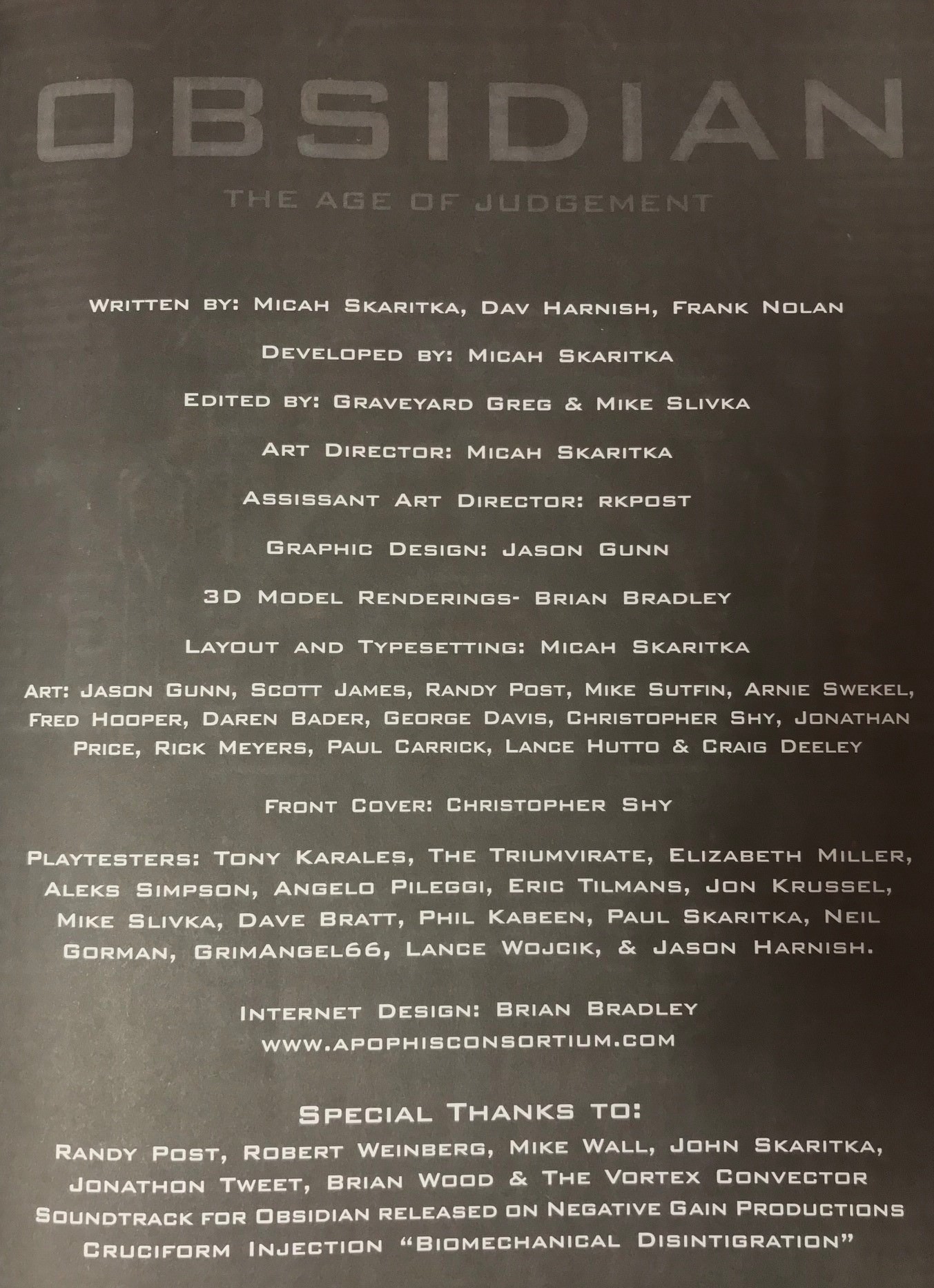
Look at how incredibly black and edgy the layout of this book is. I also wish you could embed music into words because I bet that album is the perfect match for this review
After that, it’s time for the developer introduction which clearly is completely unchanged from the 1st edition because it makes several references to the current year being 1999, not 2001. Buried under layers of the overly pretentious prose in this section is the admittance that this setting is an over-tinkered mess. By their own development timeline, Obsidian started out as a game about anarchists that morphed over the course of its more than half-a-decade development into a game where you either join or found a corporation. In another unexpected bit of transparency the developers admit that even though the entire setting is now about fighting demons from literal hell, those setting details were the very last things added. If this scattershot approach with no thematic vision for their product didn’t worry you enough, this section ends by basically all but admitting that the developers don’t have any idea the plot to their setting:
”There is much more information into the world of Obsidian than has been stated. We welcome any inquiries you might have as to in-depth theories or social structures.”
Nice try, Obsidian developers, but I’m not doing your homework for you.
Next Time: Backstory Begat Setting who Begat Fluff
Nine is Not Divisible by Four
Original SA post
Obsidian: The Age of Judgement is a roleplaying game by Apophis Consortium published first in 1999, and this review uses the 2nd Edition from 2001. Written by Micah Skaritka, Dav Harnish, and Frank Nolan. Obsidian is a post-apocalyptic anarchist corporatist literal hell on earth secret knowledge crunchy dice-pool game. It is purchasable online here if you’d like to support the authors of this work.
Part 2: Nine is Not Divisible by Four
We start the book proper then with a short story called “Maze” which in its roughly two page length commits every possible “secret truth” story cliche. A bunch of gun toting soldiers go into an abandoned research base, shoot a bunch of demons dead, rescue a guy sleeping in a pod, whereupon he wakes up and plays the “I know everything about the setting but will be patronizingly cryptic” card immediately and non-stop while portentous things are said. Then with the last survivor and him in a room, higher-ups show up to take him away, never to be seen again and the survivor is told to forget everything. Despite being narratively dull it does succinctly encapsulate one of the major themes of Obsidian; doing shitty jobs to make rent.
After “Maze” we go to the first chapter proper, “Obsidian Epoch”. This pretentiously named section includes both the history and setting sections of the book, and if you are dying to know what “Obsidian” means good luck because its a term not included in the index or glossary. As with all of these 90s secret-truth games the history section is written in an in-universe voice with annotations, but surprisingly the prose is rarely interrupted and the annotations short and pithy. Unfortunately, the text reads with all the passion and interest of a highschool history textbook from 1960 and the annotations read as direct apologia from the developers of the game.
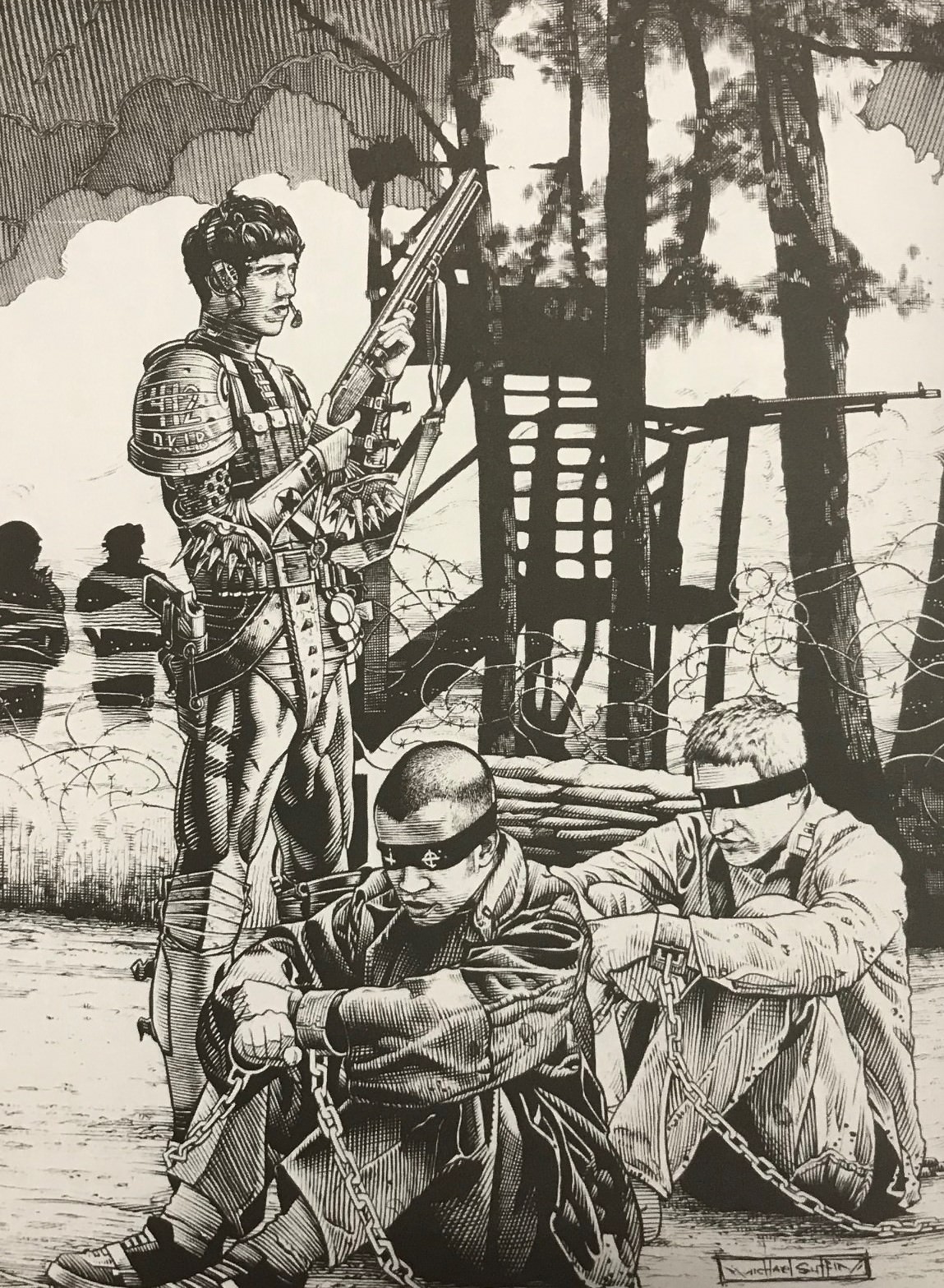
Custom blindfolds and designer sneakers for all soon to be executed prisoners
The section starts by stating that by reading the history of the Obsidian Epoch we will learn that there are secret truths about the war between hell and earth. While this is technically accurate it is being extremely misleading about the phrase “secret truths”. Instead of details you’d want to hide as a Narrator to let characters organically uncover and connect the web of intrigue you get an accounting of the years various real historical rulers came to power or died. The game then suggests that you read this section twice before going any further into the book because it is so vitally important to running and understanding the game, so I guess make sure you remember that Cyrus the Great died in 530 BCE as it’ll be on the test.
The last thing it does before dumping us into another short bit of setting narrative we still have no framework for is to tell us that Obsidian will use many languages through the book but incorrectly. It tries to claim that this is because knowledge of Latin and other languages is lost and that demons are untrustworthy so these mistakes on the authors of Obsidian’s part are totally intentional. Sorry Obsidian authors, but as someone who actually had to pass Latin, cuiusvis hominis est errare, nullius nisi insipientis in errore perseverare*.
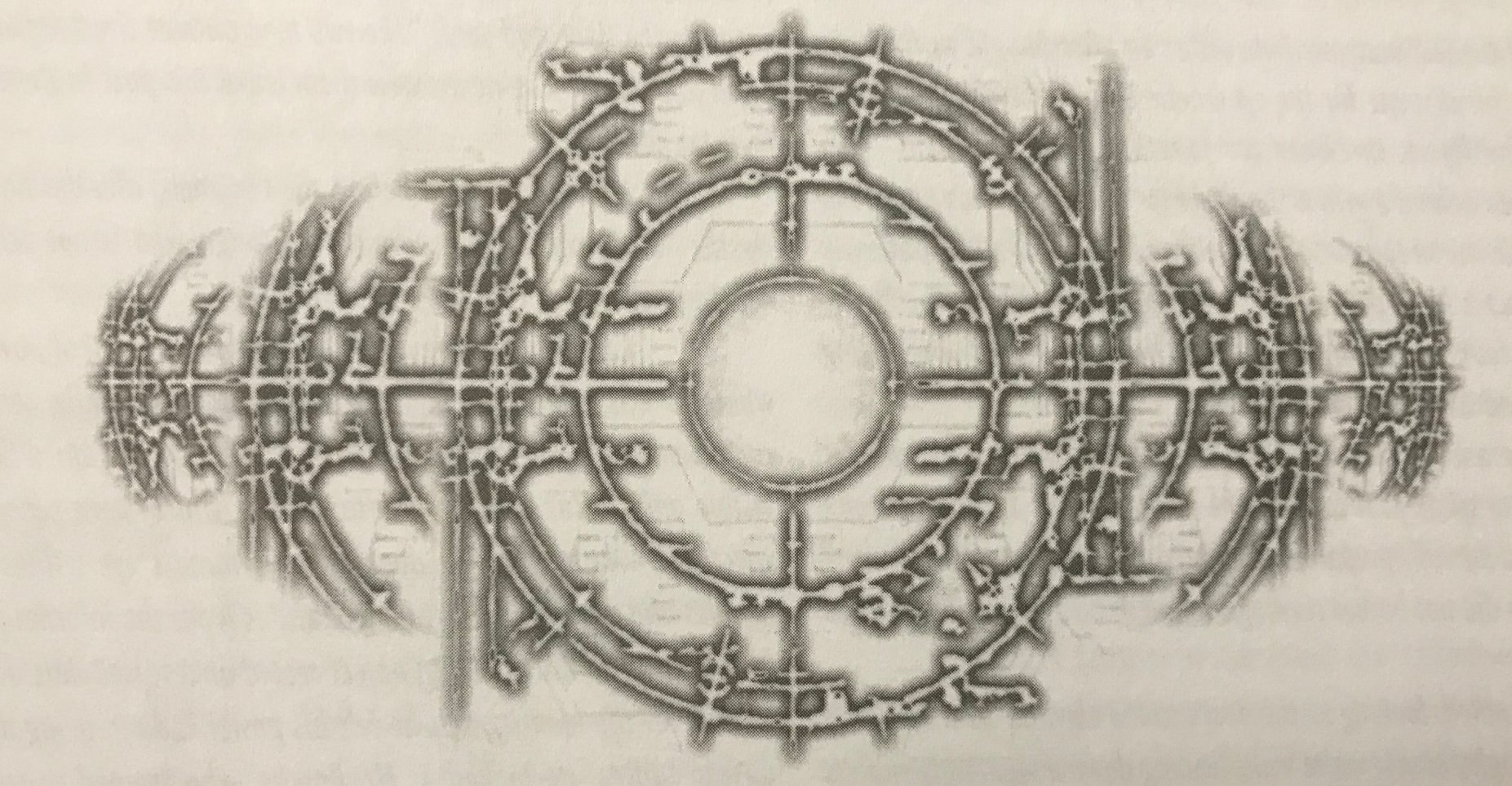
This symbol gets used to break up text at random. I have no idea what it means
The history then finally starts with the origin of the universe a staggering 12,000 years ago**, 10,000 years before the birth of the Azure Hyaline, otherwise known as Jesus Christ, at the beginning of time. Here there is a sacred land called Sheol filled with demons who aren’t bad ruled over by the boringly named Divinity of Sheol. Sheol is sustained by a reservoir of energy that all Demons feed from and maintains their undefined by implied to be idyllic existence. This reservoir of energy is the Earth, and human beings are described as parasitic organisms that thrive on Earth gobbling up this energy the demons need.
It turns out that humans doing this has has some very bad side effects for demons. You see, humans’ waste byproduct, sin, contaminates the energy supply from Earth that Demon’s feed and by eating this contaminated energy Demons go insane and turn evil. If you’re curious, the game never posits that there is anyway to reverse this process by being morally good, so enjoy roleplaying as the bacterial infection of creation that kills all other sentient life in the universe merely by existing.
Faced with the problem of humans’ sin deposits tainting the demon race, the Divinity of Sheol splits Sheol into four distinct elements called circles. This normally wouldn’t cause anyone to bat an eye, but the rest of the book talks about eight distinct circles and a bonus secret ninth circle and never, ever just four circles again. One of the many apologia annotations pops up here, in the one and only paragraph that mentions four circles, and has the in-universe author state that they have no idea why it mentions four circles here but nine moving forward but to just accept it. Why the authors of Obsidian didn’t just replace the word “four” with “nine” when they discovered this typo is also left up to the reader to ignore.
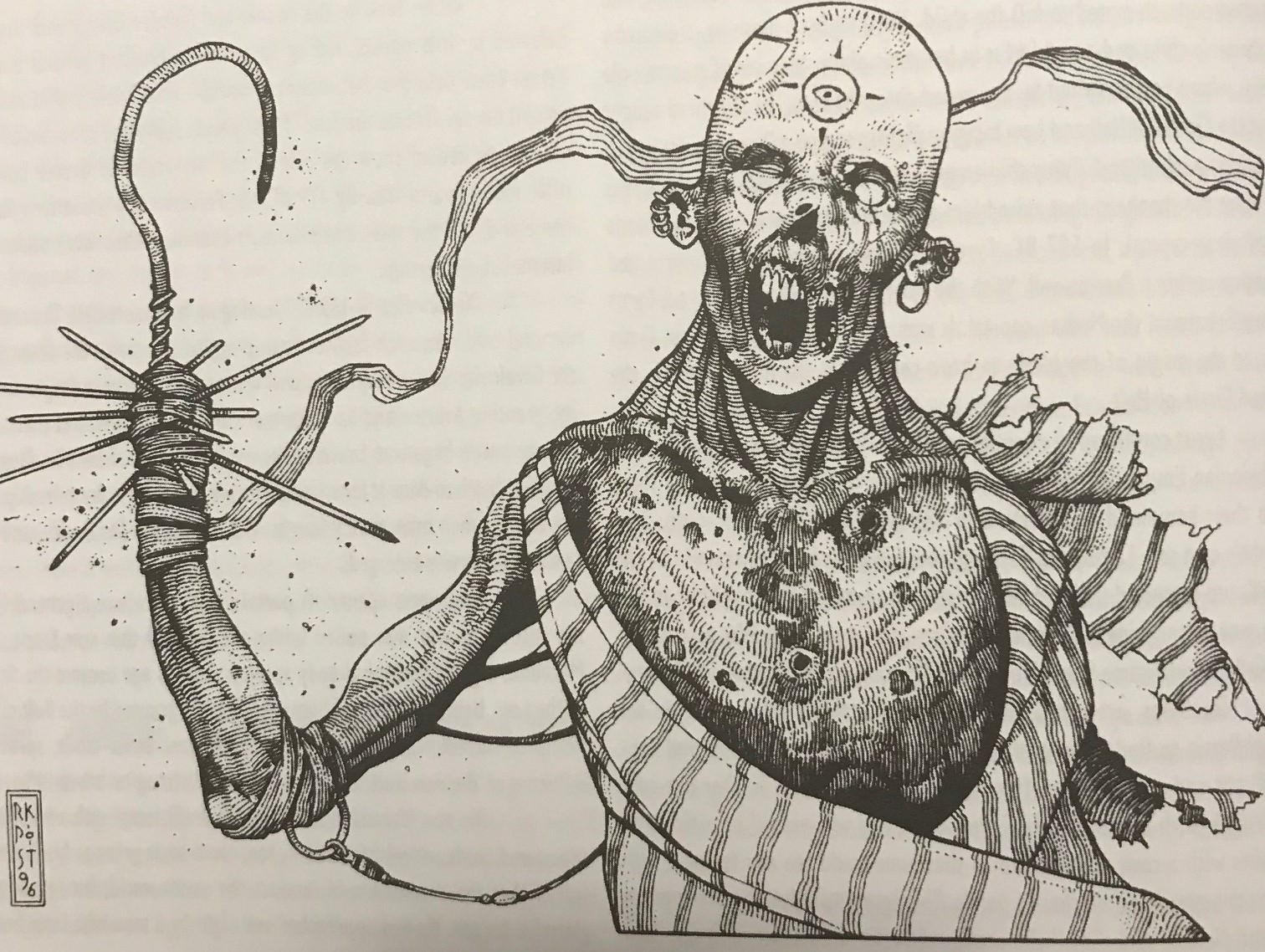
Wait is that art dated 1996? Is there another, secret edition from 1996? Is that the real conspiracy?
These
Then, as if the game wasn’t sure we had gotten that these circles fell to evil, re-introduces all of the circles but this time gives us a one paragraph story about how the circle fell to evil. Despite basically repeating information from not three paragraphs ago but now in story form, absolutely none of this matters except telling you the name of the demon which rules each realm because there is no way to travel to these realms even if they had any description. I’m not joking about that, despite all the backstory dedicated to these circles there is no actual description of any of them and they have no bearing on the gameplay or setting whatsoever.
The game then notes that only seven of the nine circles have fallen since the Azure Hyaline is protecting the eighth and nobody knows anything about the ninth but it’s the source of good caster character spells. Probably. With that we finally finish the “pre-history” section to transition into some of the most boringly written prose to ever be used to kill almost every human on the planet.
Next time: And so Cyraxes begat Astyages who begat Cyrus who begat Cambyses
*Anyone can err, but only a fool persists in his fault
**Are you legally required to be raised a Young Earth Creationist to make TTRPG based on poorly remembered christianity?
And so Cyraxes begat Astyages who begat Cyrus who begat Cambyses
Original SA post
Obsidian: The Age of Judgement is a roleplaying game by Apophis Consortium published first in 1999, and this review uses the 2nd Edition from 2001. Written by Micah Skaritka, Dav Harnish, and Frank Nolan. Obsidian is a post-apocalyptic anarchist corporatist literal hell on earth secret knowledge crunchy dice-pool game. It is purchasable online here if you’d like to support the authors of this work.
Part 3: And so Cyraxes begat Astyages who begat Cyrus who begat Cambyses
We now get into the meat and bones of the history section which I’m going to refer to as the Begat-itudes. For the next eight pages we are treated to a history of Earth that reads like a history text book yet is consistently wrong about almost every concrete detail it discusses to the point where it feels like the authors are purposefully trying to trick you. For example, the lineage of Xerxes I of Persia is included and takes up a half page of the book but skips several kings, has kings live for far longer than they historically did, and and attributes battles and conquests to different predecessors such as having Thermopylae happen under Darius the Great. Despite this complete inaccuracy, it makes everything sound like it knows what it’s doing between a droning authoritative tone and providing years for all of these things, noting for instance that Cyrus the Great was born in 574 BCE (he wasn’t) and started his rule in 557 (he didn’t). These years by the way, and the entirety of Xerxes lineage and Xerxes himself, have absolutely no bearing whatsoever on the actual setting of the game except as a way to say “history was influenced by demons” so I pity the poor sap who committed any of this fake history to memory after the game told you it would be important.
We should also take a moment to reflect on just how incredibly badly this section of the book is laid out. There is one picture in this entire section and the text is just a series of short paragraphs. There is a page long stretch where each paragraph starts with introducing the heir or inheritor of the previous paragraph's ruler, giving them a paragraph of story, then moving on to the next paragraph where the process repeats until you know the imaginary lineage of Xerxes I better than your own family. Even if the information provided here was remotely useable, actually educational, or important in-game no player is ever going to finish taking an Alt World-History 101 course when they could skip ahead and get closer to the promise of ultra-drugs.
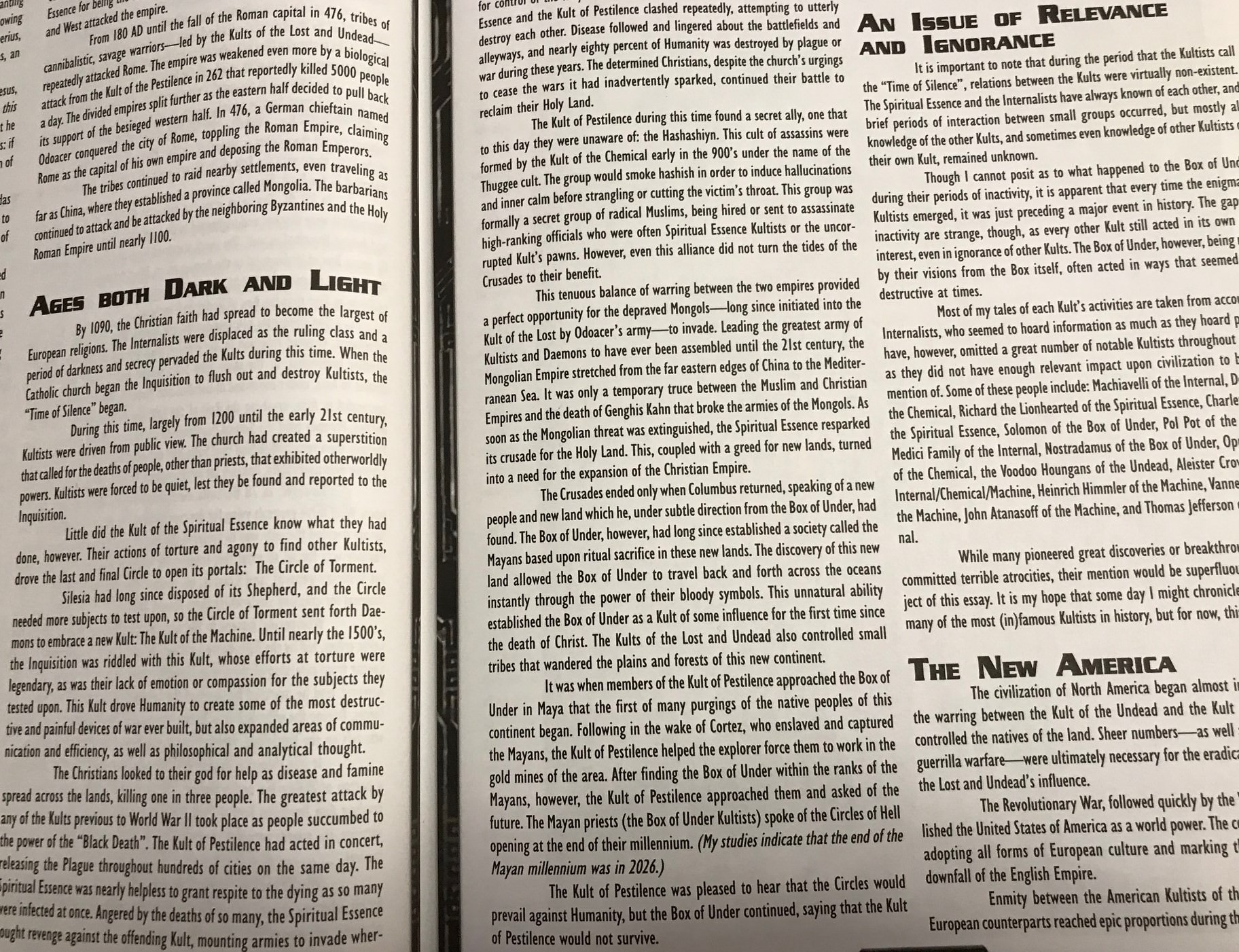
Seriously, its page after page after page of this. The secret to everlasting life could be in these pages and the authors of this book still wouldn’t find it
Awkwardly kludged in between two paragraphs in this eight page pile of incorrect history information is something that is genuinely really important so of course the book calls absolutely zero attention to it even though it’s mandatory to understanding the setting. Each circle, has humans who worship its corrupted form and are called Kultists who are in a Kult. These Kults for some irritating reason have a name that isn’t just Kult of [Circle Name], so get used to having to learn that the Kult of the Internal is the Kult for the Circle of Lust which was once called the Circle of Avarice which it is also still called whenever the writers feel like it and the proof-reader stopped caring.
With that concept now introduced, that same paragraph introduces the idea that each Kult has a unique pact blade* that Kultists use to steal other people’s souls with and then sell it to the ruler of the Circle they worship in exchange for power. The Demons like this arrangement because it gives them direct feeds to the Earth’’ reservoir and by getting enough of this energy they can send their demons over to Earth from Sheol to gather it directly to send more demons over and so on**.
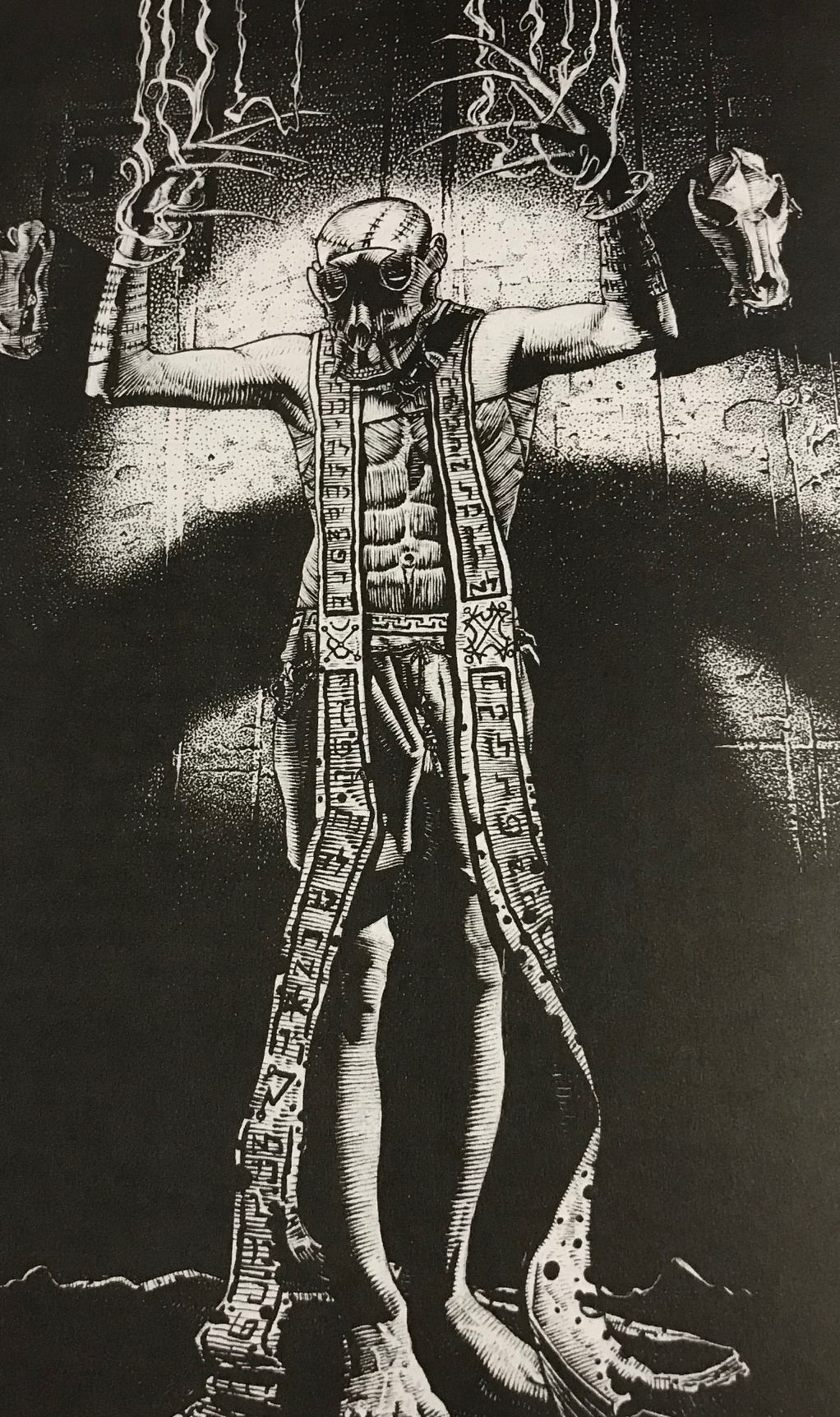
either this guy is a Kultist or he’s Jason Blum of Blumhouse Productions
I’m not going to bore you with the rest of incorrectly remembered history, especially because it’s basically as though Rudyard Kipling and Thomas Carlyle gave birth to a history professor. Instead of just recounting the noble effort of Great White Western Men of Alt-History, lets just stick to the highlights:
- The name of the Kult of the Circle of Under is “Box of Under”. This isn’t historically weird, it just makes me chuckle
- A Kult that was introduced as setting secret and implied to be working in the shadows has its entire history up through its total, 100% no take-backs destruction outlined in this section
- The Mongols are “degenerates”
- Jewish Kabbalahists are demons who stabbed the Jewish people in the back throughout history which is why the diaspora and genocides happened
- The Azure Hyaline, Jesus, was basically a total failure so despite Obsidian hyping them up and having them be referenced in the first sentence of the first chapter of this book they aren’t really relevant to anything that happens
- The word “well” is misspelled “wel” and it bugs me a lot because a basic click of spell-check would have fixed that
- Islam isn’t worth talking about and is a mere footnote in human history and not even demons or Kultists are involved in it
- The only mention of Hinduism is the Thuggee
- Hitler and Napoleon are anti-christs, a term which isn’t defined by the game because it makes no sense given this setting’s Jesus.
If you’re finishing this update and wondering how absolutely any of this ties into the game as it is played with humans oblivious to the pre-apocalypse history and hopped up on drugs to help them gun down corporate rivals in a fast-food parking lot feel free to share your head-cannon reason because the game doesn't have one.
Next Time: It Turns Out Humans are Part Rabbit
*I’m not sure if the authors were being edgy or oblivious when they went with the letter K theme here
**Seriously, remember this entire basis of why Kults exist and how they work in mind for the next update. Or don’t, I can’t really blame you.
It Turns Out Humans are Part Rabbit
Original SA post
Obsidian: The Age of Judgement is a roleplaying game by Apophis Consortium published first in 1999, and this review uses the 2nd Edition from 2001. Written by Micah Skaritka, Dav Harnish, and Frank Nolan. Obsidian is a post-apocalyptic anarchist corporatist literal hell on earth secret knowledge crunchy dice-pool game. It is purchasable online here if you’d like to support the authors of this work.
Part 4: It Turns Out Humans are Part Rabbit
Picking up where we left off, the book makes its third change in writing style when discussing the settings history, which if you’ll remember, is theoretically all written by the same single person. With no more history to blandly muddle up, we go now to the far distant future of 2020 where the apocalypse beings. Terrible things start to happen which portend the doom of the world including “mayan sacrifices”, “2000% increase in crime”, “80% of southern and central Africans die of disease”, “global sword-based serial killers”, and “Dachau is a museum”. Yes, having a museum at Dachau is evil*:
About the same time, deep in the heart of Dachau (which, horrifically enough, had been converted into a museum)...
After some more really spooky events, which again I’m not making up such as “70% of American teenagers have tried drugs” and “business invents new computer circuit layout” we get into where the story actually has relevance to the setting as players experience it. It only took us 10 pages, but by goodness we made it. On December 31st 2026 at two minutes to midnight, because all of this extremely precise time and date information is the hallmark of great writing, Portals from the Circles begin to open and insane corrupted demons pour through. Humanity is utterly helpless in the face of these demons and by 2070 95% of all humans on earth are wiped out. This probably isn’t helped by NORAD’s strategy as written in the book that can be summarized as “split all of our armies into groups of 50 soldiers who have to drag 200 civilians along with them and then send them in different directions across the ruins of the world without any plan except to avoid the demons”. The book thinks this is a clever strategy.
After some more extremely stupid decisions involving NORAD, the remaining 400 million or so humans are nuked down to exactly 513 people. 80 of them then leave to search for other survivors and die off screen, so we actually have exactly 433 humans but the book doesn’t seem to care anymore about how many people are left. Suddenly a magic person appears in front of them and 45 members of this group of 433 are turned into Mystics; mighty warriors suffused with the power to destroy demons and beat back the armies of the circles (now called Hell) and who do not age.
You don’t get to play as them**.

Sir Dee Empee Sea
These 433 humans are then joined by 200 other humans who are/were part of the Box of Under, the Kult of the Circle of Under. The game gives no reason, no story hooks, and no explanation as to why this happens and even includes a in-universe commentary saying there is no known reason for it but to just accept it as good. This addition brings us up to 633 humans who then begin building the imaginatively named city of Bastion and within its walls all human civilization will survive for the next 227 years until the game’s present date of 2299.
In the intervening years between the founding of Bastion and the game’s starting date nothing much happens except some story hooks. Humans try to build another Bastion, it gets destroyed. They try to send people there, they all vanish. They then try to build another Bastion in another place and it gets destroyed. At the second place only half of everyone they send vanishes. No explanations are given because it’s spooky. The last plot hook is that one of the 45 mystics turns out to be evil, agrees to be exiled, and is never heard from again but because of his evil the Mystics set up a government with laws, but the book presents it as spooky and evil that they remain involved in government affairs after doing this. Yes, humans would have a lot of issues with their government if they found out it was influenced behind the scenes by the immortal, divinely blessed, battle-hardened saviors of the human race.
With the history out of the way, and the actual, somewhat useable in game setting details coming up, let’s take a moment to drink a couple of things in:
Xerxes the I’s lineage takes up more paragraphs than the entirety of story devoted to “45 super beings save the last of humanity from extinction and rule undying for 230 years which leads to the present state of the setting where you, the player characters, come in.”
You might be wondering why I kept highlighting the number of humans in detail. It’s both because the book does it and also because the official population for the city of Bastion in the year 2299 is 60 million. With a starting population of 633 humans assuredly producing a genetic bottleneck and having a population that has to mathematically triples every generation Obsidian goes for some unintentionally coherent world-building by having absolutely no stat or ability related to being more physically attractive than anyone else.
The game expects a lot of players, if not all of them, to want to be in a Kult or devote the game around rooting out Kults in human society. Even if you did play a human stupid or evil enough to want to sell out to the demons who lust for the genocide of the human race and almost succeeded, their isn’t really a reason Demon’s should want to make deals with the humans either. In the history section Kultists helped them bridge to Earth, but now that they have massive armies on Earth and direct access to its energies they don’t really need the Kultists anymore. Rather than come up with any sensible reason for this mechanic to still be in the game and the focal point of it, Obsidian will kindly ask you to ignore all of this and just assume the whole “secret cult” thing still works and makes sense. I'm not joking, there is a note that says demons form pacts with any human that wants to for no known reason.
Micah Skaritka, one of the authors of this game, was lead designer on Gat Outta Hell, among several other things.
Next Time: The City Clerk Can Provide You with the Paperwork to Your Assassination
*I’m starting to worry about this book’s authors at this point between this and the Kabbalahists
**Are you really surprised at this point?
The City Clerk Can Provide You with the Paperwork to Your Assassination
Original SA post
Obsidian: The Age of Judgement is a roleplaying game by Apophis Consortium published first in 1999, and this review uses the 2nd Edition from 2001. Written by Micah Skaritka, Dav Harnish, and Frank Nolan. Obsidian is a post-apocalyptic anarchist corporatist literal hell on earth secret knowledge crunchy dice-pool game. It is purchasable online here if you’d like to support the authors of this work.
Part 5: The City Clerk Can Provide You with the Paperwork to Your Assassination
The 60 million people who inhabit the Bastion, now referred to and for the rest of this book as The Zone, live inside the structure which is 22 miles in diameter and 3 miles high. Absolutely bristling with guns and militaristic construction and design to prevent the roving hoardes of endless demons from getting inside, the Zone is further divided into Sectors. These, unsurprisingly, follow your usual sci-fi distopia of being a sliding scale from the upper levels of strictly controlled corporate paradise to middle levels of wild, low-oversight dens of crime to the basement with horrific slave labor death mines.
Before we go further, as its done several times the book insists we really read this section and take it all in. Quote for this section below:
“To fully understand and appreciate the game of Obsidian it is necessary to read the following. It is essential for the Narrator to have a comprehensive outlook on the Zone’s makeup inside and out”
The seven paragraphs from this sentence is a description of how children’s education works within the Zone, down to including the amount of time children spend learning, the curricula, and not only how much school costs but how the government subsidizes this when necessary. This entire setting section, if you can’t tell, is extremely unfocused. In addition to some bits of genuinely useful setting details it also contains an incredibly detailed multi-paragraph description of how the government manages prostitution, how the government creates citizen’s ID numbers, and exactly how many gigabytes fit on a standard memory disk*.
In this extremely cliched dystopian future of proper nouns, the government of The Zone is called The Unity, and maintains its order with its law-enforcement arm The Law. Who or what makes up the Unity and how do they operate? Not a single sentence. What are the laws that The Law enforces? Why bother telling you in this section when we can tell you that the maximum fine that can be levied is 56 million credits and the government gives families of individuals sentenced to hard labor 30 credits a day in compensation. Since we have no idea how much a credit is worth, lets cheat a little and jump ahead to note that an iPad equivalent device is 900 credits.
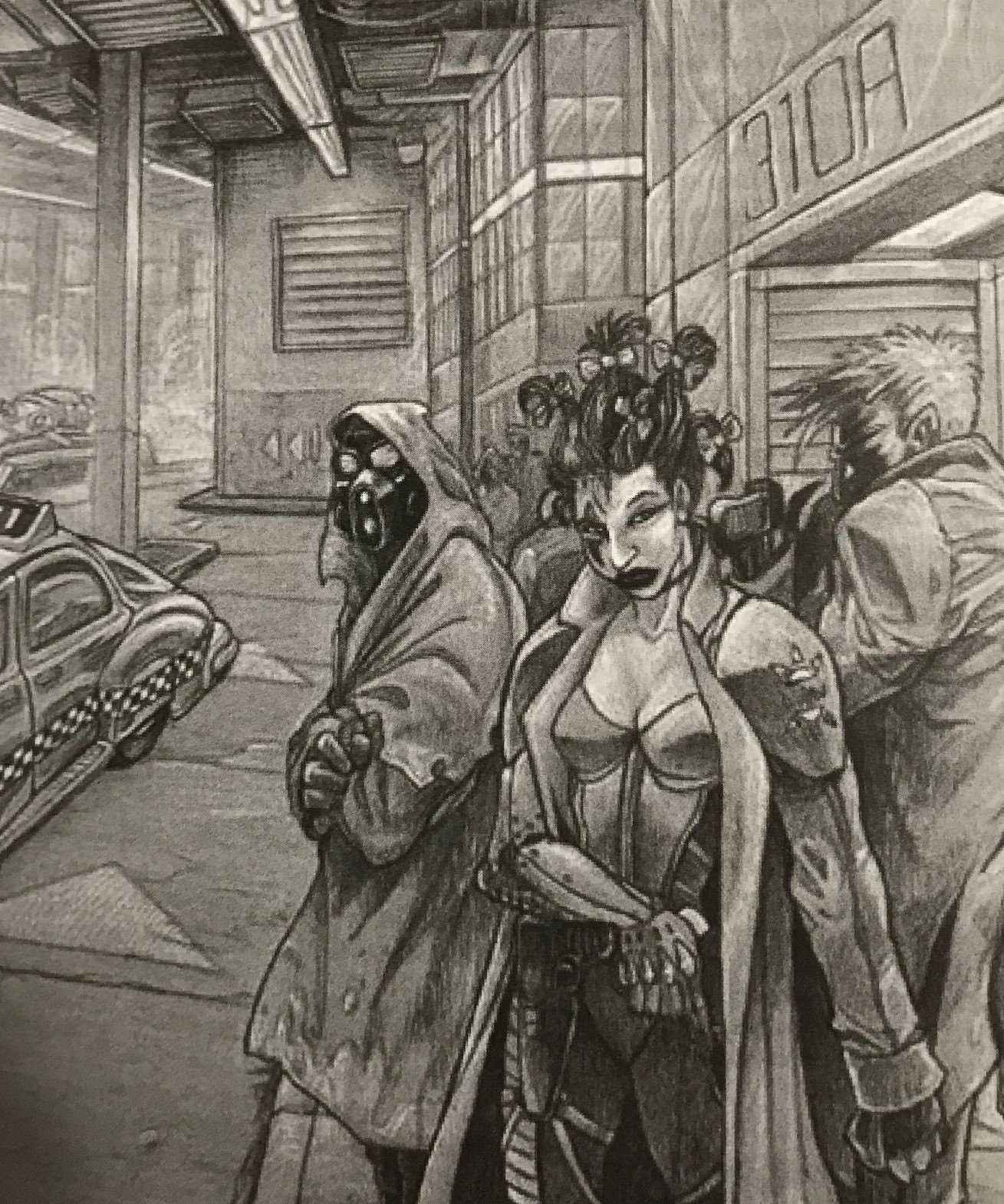
One of the many victims of the Demon armies were ride-share businesses
Mushed randomly throughout this section are random tid-bits like you can get cyber eyes that can see magical spectrums, you can replace you limbs with cybernetic ones, and powered airflight is an impossible dream due to technological limitations in a society with hover-cars. Also mashed in randomly are notes on what are crimes which consist of theft, making viruses and releasing them on the populace but just making them isn’t, being a kultist, and shirking the copious amounts of paperwork the Unity makes you fill out. We’ll discuss murder in a minute.
Unfortunately for people who don’t like forms in triplicate, cops in Obsidian are nearly three meter tall cyborg killing machines raised from birth and jacked up on drugs, patriotism, and good old fashioned abusive upbringings to enforce the legal system as they see fit. Fortunately for our paperwork dodger, there is only roughly 1 cop for every 6,000 citizens with most in the upper levels so not a lot of policing actually seems to happen other than randomly spraying bullets into crowds on the lower levels. The cops still somehow catch enough people for a mandatory daily 4-hour long broadcast just listing the names of everyone condemned to death or slave labor, and yes, that TV show is mandatory on all networks.
Now let’s talk about murder and the best thing in the game, The Assassin’s Law. Within the Zone you can pay a yearly 20,000 credit fee to allow you to contract out legal murders on anyone you want. While the Law theoretically can deny it for whatever reason they see fit, the game notes that they only do that automatically for magical people or people who have multiple government gold-stars for good behavior which are very rare. With a 4-hour long broadcast of criminals that are condemned to death, the Law mostly seems to take an everyone is probably guilty anyway approach to this and there are presumably countless contracts out at any time. For only 1,000 credits a year anyone can legally certified as an assassin and take these contracts. The government, for their part, once they approve a contract lets the person who the hit has been called in on know that a hit has been placed on them, and if the intended target goes downtown to the Central Core they can request a copy of the contract for a 10 credit paper-work filling fee. Yes, that’s right, the game has an entire rules system for requesting the paperwork to your murder.
What happens next takes The Assassin’s Law from dumb to setting and tone destroying. You see, the Law understands that people who have been told they’re going to be murdered tend to make it difficult to shoot them in the face and accidents can happen and bystanders can die. Each contract you take, therefore, comes with one free accidental death of a person who isn’t your target. There isn't any note about the quality of the people you accidentally kill, just the quantity, so as long as you only use up your one freebie per contract you won't get into trouble. If you have read this paragraph and not immediately grimaced at the conversation between players on how many people they are going to “accidentally” murder while taking the hundreds of contracts available at any time, you’re probably the person at the table whose noting that contracts don’t have any clause on how long you take to fulfil them so you can theoretically take on all the contracts, murder a few thousand people and just tell the Law you’ll get around to killing your targets eventually.
Lastly, it’s from way later in the book but I want to pull it up here, the minimum cost of a murder is 1,000 credits. If you buy a six-pack of assassinations, an actual item in the game, it only runs you 2,000 credits. That’s right, there is a Costco of assassinations in Obsidian.
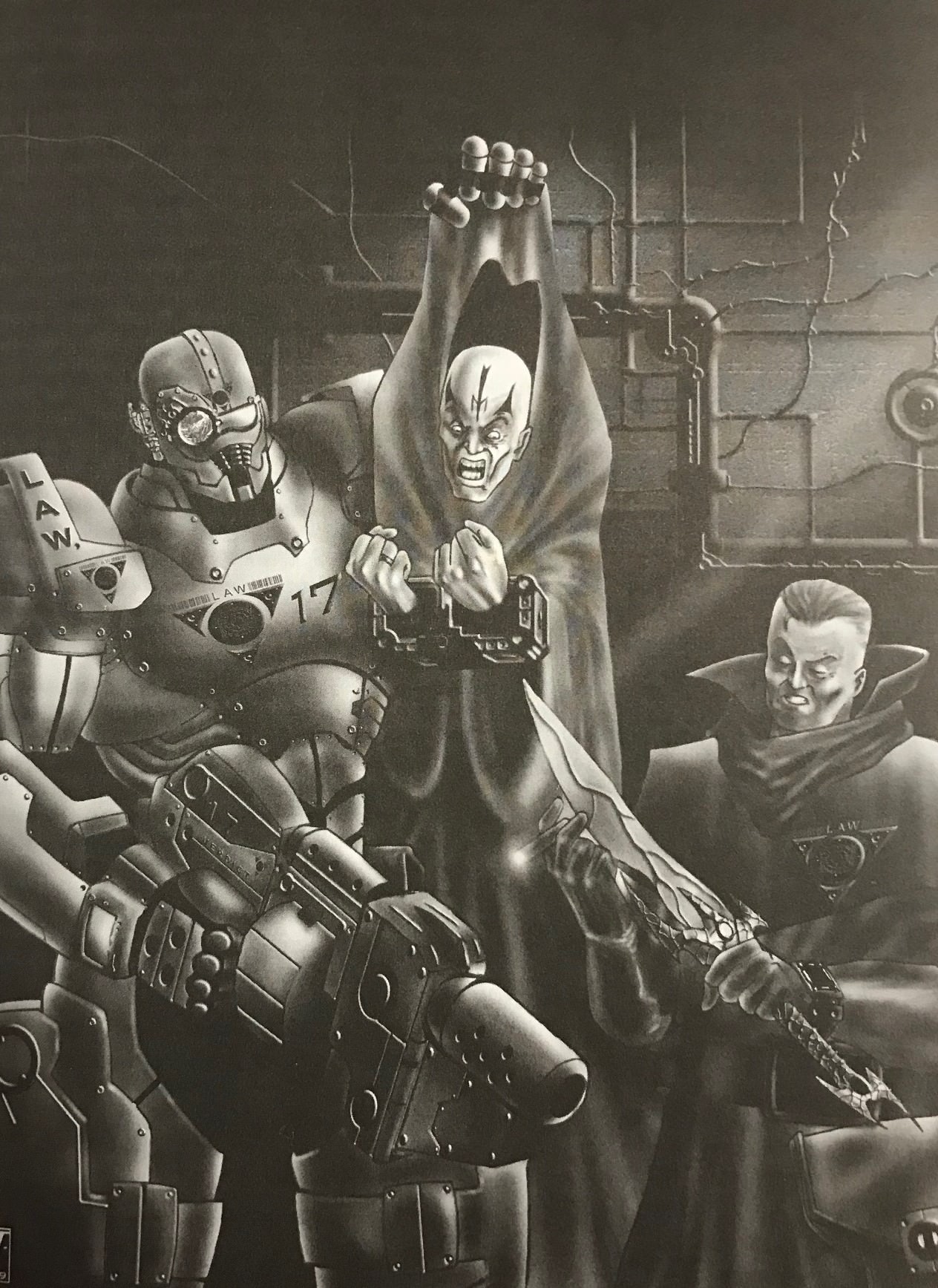
I would have gotten away with it too if it weren’t for you meddling orphaned cyber-commando kids!
If your game doesn’t immediately descend into a wild, black-comedy bloodshed with players taking out contracts they have no intention of fulfilling so they can legally blow away the rude bartender character you’ve created, there are some more details on the areas surrounding the Zone. They take up less space than the description of the Unity’s center for disease control and it’s history so, surprise, they’re all completely inhospitable and completely underdeveloped. One is a land of lava and demons, another is a land of robot demons, another of poison and demons, and you’ve probably gotten the theme at this point.
Despite telling you in no uncertain terms that these areas are hellacious, demon filled nightmares no sane individuals would ever go and that a campaign adventure should be entirely in the Zone, it then immediately suggests that you could run a campaign where the players venture into these zones to hunt demons for their delicious meat. Thats right, humans in Obsidian aren’t content with just contaminating the Demon’s food supply and driving them insane, they’re also literally into eating them. Obsidian then notes that demon meat, unsurprisingly, is chock-full of deadly diseases and about a hundred years ago half a million humans died due to demon diseases** so why anyone keeps buying them is a mystery.
This section then gently comes to a halt repeating plot hooks from earlier in the lore section and then just sort of ending on this repeated information. There is no segue here or link to the next section which kicks off character creation, and reading this section doesn’t really give you any insight on what kind of character you can even create other than “person who kills people legally for money and sometimes because they got their order wrong at the drive-thru”. With that pile of useless information, historical lies, overly detailed clerical processes, and non-descriptions of the setting's main antagonists we close out the setting section.
Next Time: Who Needs to Know What +2 Visionary Ritual Points Means
*In the far future of 2299 that number is 12
**This is possibly one of the least thought out sections in any TTRPG. It invalidates a plot point that it introduces sentences before, it ignores the fact that half a million people would be a staggeringly huge loss during a time when the human population would be lucky to break a million people, and is blamed on a group that the history section said noted without equivocation was dead and gone permanently for nearly a thousand years by this point.
Who Needs to Know What +2 Visionary Ritual Points Means
Original SA post
Obsidian: The Age of Judgement is a roleplaying game by Apophis Consortium published first in 1999, and this review uses the 2nd Edition from 2001. Written by Micah Skaritka, Dav Harnish, and Frank Nolan. Obsidian is a post-apocalyptic anarchist corporatist literal hell on earth secret knowledge crunchy dice-pool game. It is purchasable online here if you’d like to support the authors of this work.
Part 6: Who Needs to Know What +2 Visionary Ritual Points Means
With Chapter 1 behind us we can jump into Chapter 2, called “Elements of the Story.” This title is, as almost everything in Obsidian is, extremely misleading as only 2 of the 20 pages of this chapter focus on “The Story” as the game keeps calling any campaign in their setting. The remaining pages are character creation rules that for some reason aren’t in the next chapter, which is the chapter theoretically all about character creation rules. This is going to be a really bad layout idea as you’ll see in a moment.
Before we even get to jump into any of that though, the game has another fluff piece it wants us to read. This page and a half long story introduces setting information that has never come up before like Candles of Transcendence* but honestly mostly exists to brutally torture a woman. Seriously, this story is half “rich guy who is in cahoots with demon talk about their upcoming job” and half the interspersed description of a bound, naked woman in the back of the room getting tortured and pleading for help while this guy does his boring pre-planning with the demon before she gets murdered at the end for no reason because none of what happens to her has any established purpose in the setting section we just read. Oh, and somehow in this future last city of mankind nobody seems to notice or care that some people appear to be animated skeletons even though 100% of animated skeletons in this universe are incahoots with the armies that plan to kill all humans.
After that wonderful bit of narrative, the game does what every RPG does, clumsily try to introduce how to roleplay good. Firstly, though, it confirms that we aren’t evil by roleplaying or making a pact with the devil which is frankly unexpected for this game which takes itself so seriously. The game’s actual suggestions for how to run a campaign start good with lots of nods to “read your players’ character sheets” and “talk with them before starting the game to determine the kind of story they want” and then run headlong into the idea that the Story Master/Game Master/Dungeon Master (here called The Narrator) is basically writing a story for the players to play through and the players are on rails. The book doesn’t do much to mesh these two ideas together, but from the suggestions you can tell the authors expect you to tweak your story as appropriate for what the players want to do but it is never written out that way.
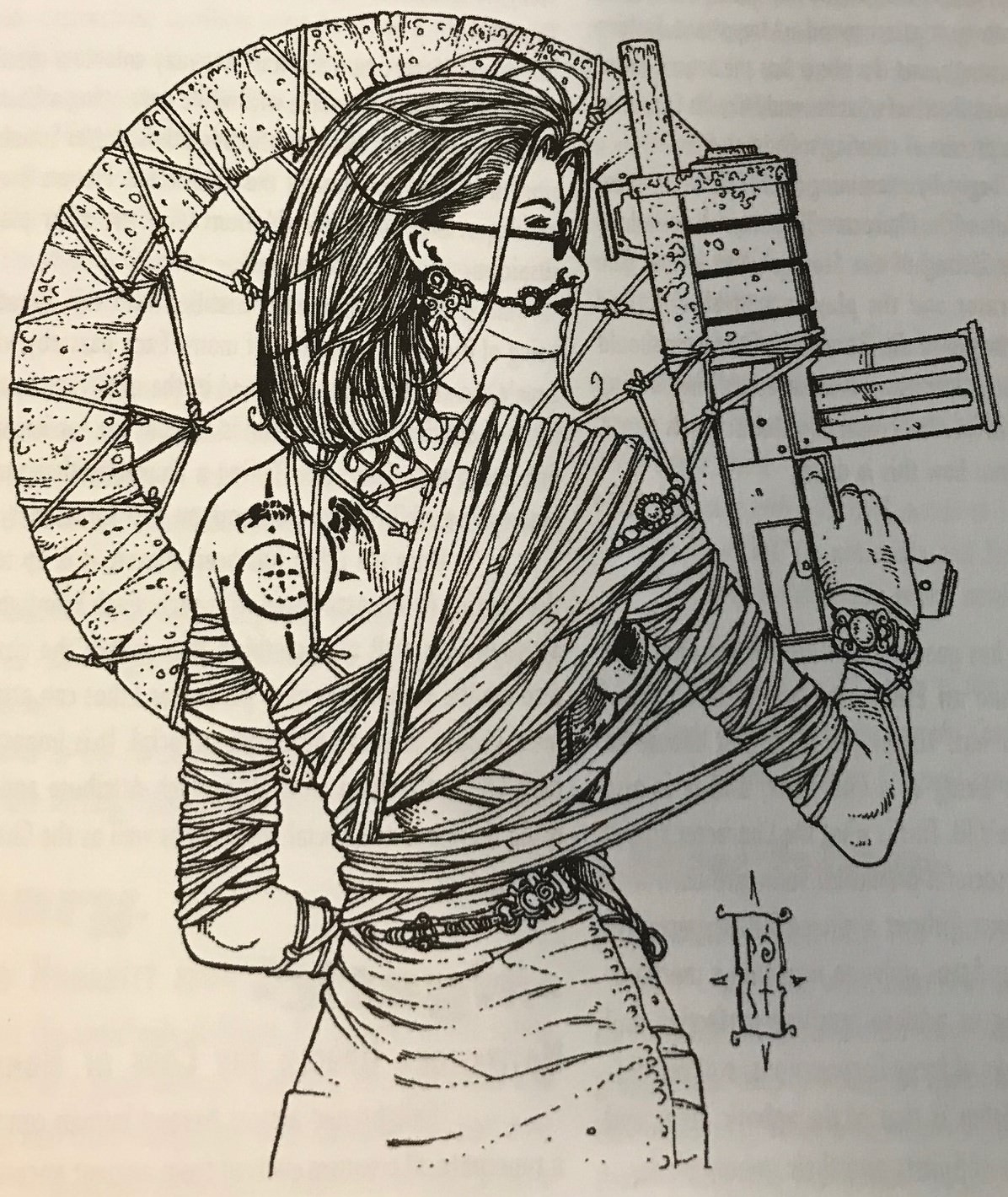
I bet she knows that Nebuchadnezzar once went by the name Esarhaddon before Cyraxes son Astyages took his lands in 570 BC
Before we move onto the character creation, I have to call out two things in this section. The first is the authors wrote the following sentence about how to come up with story hooks,”[...]the Narrator needs to come up with a plot that the Characters need to resolve. This should be easy, considering nearly every sentence within this book contains an idea that could be exploited”. We’re not particularly far into the book at this point so if you take this at face value it means your campaign mostly be about people trying to pass a history exam. The second is the example Story and its hooks that the book provides to give you an idea of how this should all come together is entirely about murdering hobos hobos. It starts with a dying hobo escaping from a hobo massacre leading to finding a group of murdered hobos with each new step in the story involving more and more dead hobos until it finally culminates in this:
”Maybe the key has nothing to do with Society, but the characters keep stumbling among the massacres of bums[...]
The section then ends with a list of Story ideas and basically every single one is some variation on “Corporation wants [x], and hire you to do it” with suggestions that possibly the corporation betray you once you do [x] because they’re evil. The best one is the one that runs literally counter to their advice from earlier and requires you to have a mixed party of good people and evil ones where one player works to sabotage the good players efforts and that certainly will be a fun campaign to run, won’t it, you Chaotic-Neutral alignment assholes reading this?
With that wrapped up, we get hurled into character creation, and I mean hurled. Theres no real transition, just two intro paragraphs outlining the process, one of which offhand mentions that players may also play NPCs which makes no sense and doesn’t come up ever again, and then it is time to start building your character. The process is listed as follows; Design Character Concept, Choose One Ethos, Choose Primary and Secondary Socials, Four Character Rolls, Spend 20 Generation Points, Assign Motiviations.
Did you read that? Good, now just go ahead and throw “Design Character Concept”, “Assign Motivations”, and most of the “Four Character Rolls” right out the window because your Ethos and Socials basically define your character mechanically and in fluff so don’t waste your time with any of that. In the case of Motivations this is extremely literal, each of the “Ethos” you select has a bolded headline saying what that Ethos’s motivation is.
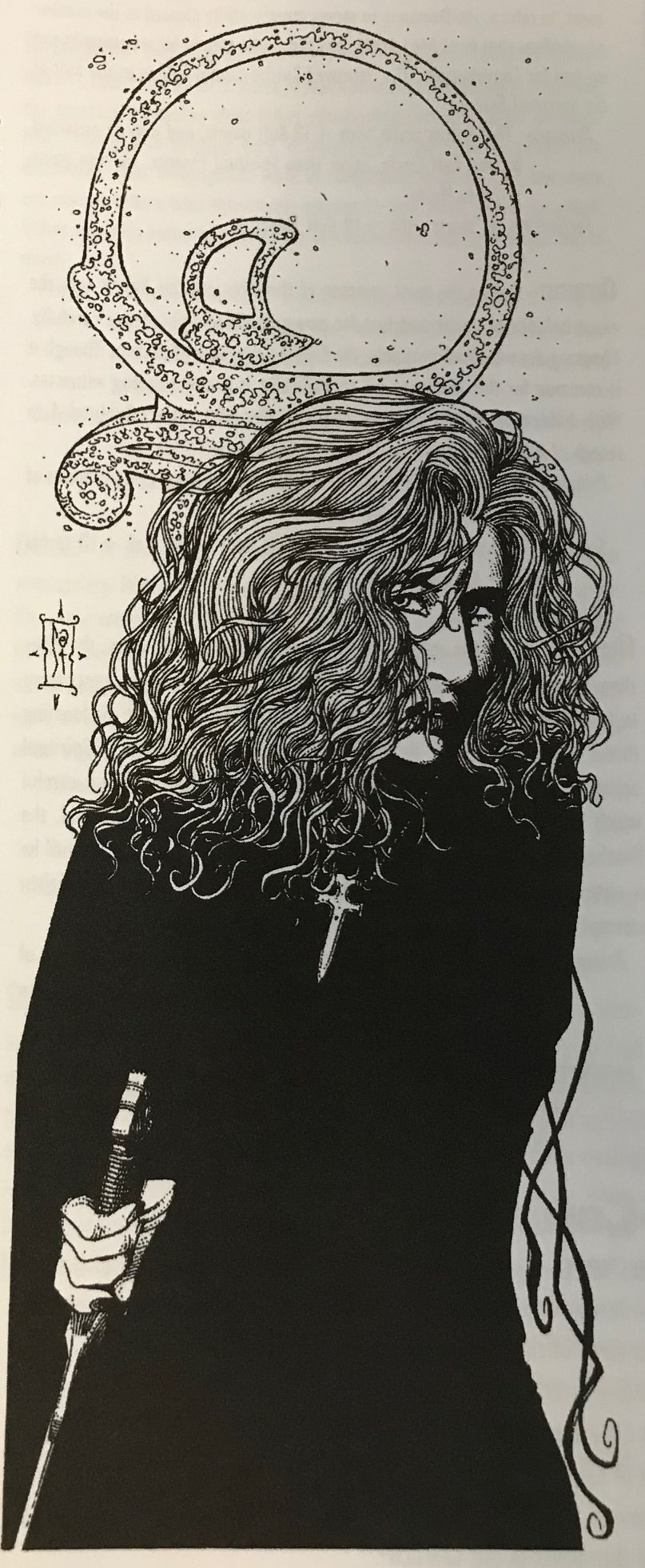
Casting magic requires a surprising amount of stabbing in Obsidian
So what are Ethos and Socials? They’re basically the same thing with Ethos being a little more “how does your character ideologically view the world” and Socials being “what is your character’s job” but you’ll notice thats a fluff-only difference. What they actually are is packages of skills and stat buffs that you apply to your character, and since what random chance controls has almost no bearing on your character can do, this is really where you build your character. Further invalidating any concepts you may have had, what Ethos you select also determines what Socials you’re allowed to choose from, so you know what, there are basically only 6 characters in the game despite it being a theoretical template and point-buy system.
You may notice that we are barely started with this system and to build a character we already have a mess of character templates, random rolls, and point buy to deal with. Good thing it gets even more confusing because at this point we have absolutely no frame of reference for what absolutely any of the stuff we are choosing even means because all of that information is in the next chapter. Ethos and Socials include benefits like, “They start with a +2D Bonus to the Mind Attribute” and “+2 Visionary Ritual Points” which are absolutely not self-explanatory, Obsidian. The worst to even try to parse is one of the the packages for casters which results in getting the following block of stats “Kultists start with 1D Call, access to 1 Kult, and 20 Kult Points to spend on Call, Convokations, and Spiritual Solidarty. They also start with a Kult blade and a number of Spirit Points equal to their Call Rating”. I get a 1D Call? Perfect, my character can finally let his mom know he's ok.
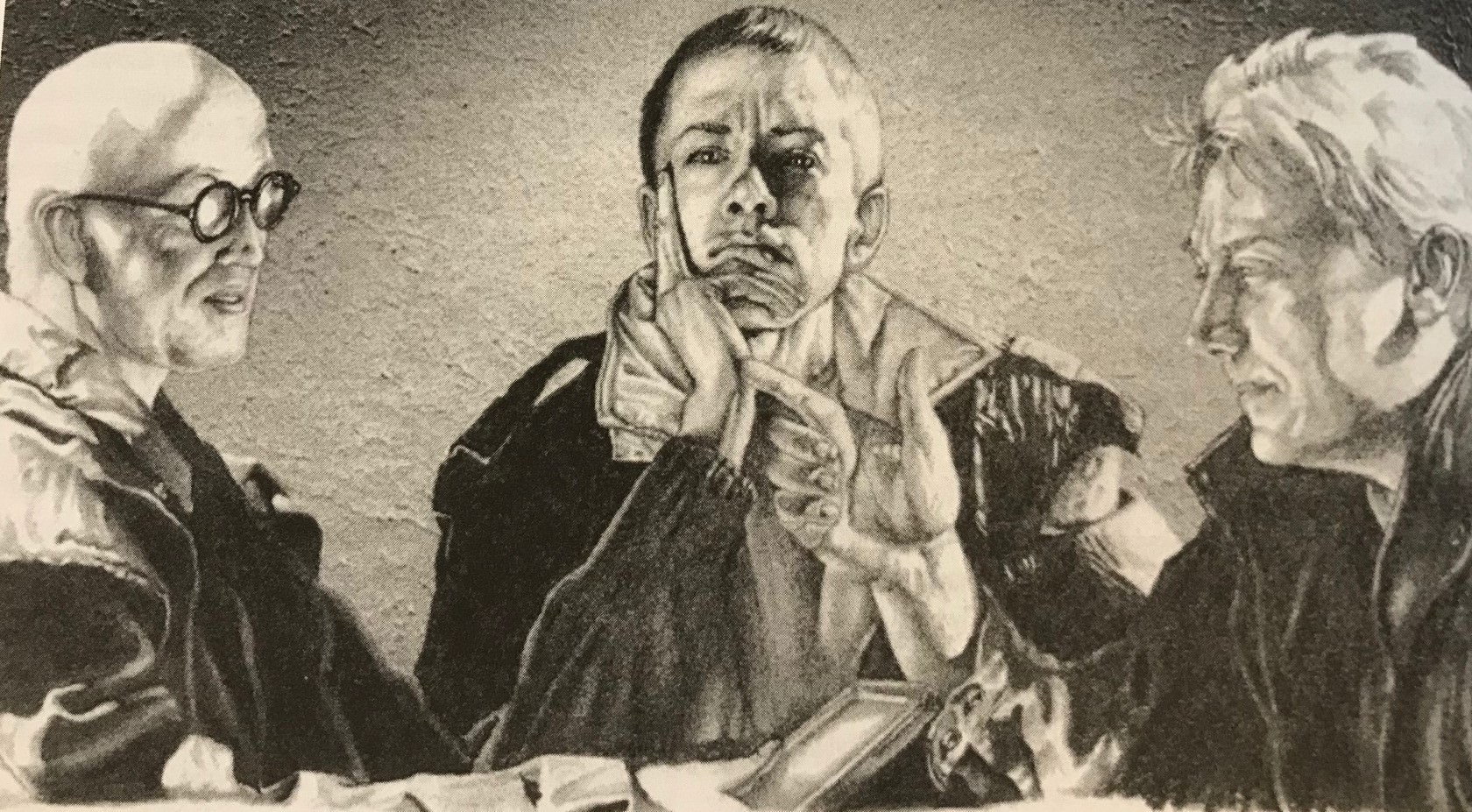
A young Marshall Mathers dreams of an aged version of himself arguing with James Spader
These packages also aren’t particularly balanced, either, with the assumption that you’ll take some of these purely on the fluff description not the mechanics. There is no reason, for instance to select “Enigmatic” as your secondary Social as all it does is make you pay twice as much to open your first bank bank account. If instead you chose “Scavanger” as your secondary you’d get a stat boost and enough money to buy a gun that reliably kill just about any on-foot foe in the game you shoot at in a single turn. Further compounding this, Socials are basically non-choices unless you plan to make a bad character. There is only one Social per major Stat and certain starting classes get special Socials designed just for them that only they have access to which provide tailored benefits. The system basically just points you at the optimal Social choices for your Ethos and sort of shrugs its shoulders at you if you want to pick outside of that.
We’ll get into the rest of the the character creation rules next time, but for now give me your edgiest 90s occult corporate raiders and I’ll build a few characters** and then possibly get them addicted to drugs or chopped up into cyborgs later.
Next Time: Experience Points as Luck Tokens, Random Rolls, and You
*This is defined 45 pages later in the middle of a single paragraph describing the mechanics for a system that is never referenced until that moment and has no fluff around it until that page.
**These characters except probably will not be built optimally because that seems boring
Experience Points as Luck Tokens, Random Rolls, and You
Original SA post
Obsidian: The Age of Judgement is a roleplaying game by Apophis Consortium published first in 1999, and this review uses the 2nd Edition from 2001. Written by Micah Skaritka, Dav Harnish, and Frank Nolan. Obsidian is a post-apocalyptic anarchist corporatist literal hell on earth secret knowledge crunchy dice-pool game. It is purchasable online here if you’d like to support the authors of this work.
Part 7: Experience Points as Luck Tokens, Random Rolls, and You
With our Ethos and Socials picked out, aka our character class and skill buffs, we move from a template system to a random roll system for the portion of character creation called “Character Rolls.” These are four random rolls, two are 4d6 and two are 1d6, that determine a few more things about our character. These things are our ability to resist lethal damage, non-lethal damage, our starting money, and our starting Spirit points. You’d think that with template classes and a point buy system we’d not need random rolling for this odd collection of stats but you’d be wrong and you’d better make these rolls in the presence of your Narrator as the book notes.
I’m going to skip ahead slightly in the book rules wise to dive into these in a little more detail because we don’t really have any idea what these stats mean at this point since the game wont define them till next chapter and also these stats are completely broken and poorly thought out.
Things Wrong With the Random Rolled Stats
- The two HP pools aren’t remotely equal; nearly everything in the game deals lethal damage which bypasses the non-lethal pool entirely and wearing heavy armor of any kind negates all non-lethal damage entirely.
- The only way to ever increase your HP is by spending points to increase your strength score, which caps out at a measly +2d6. If you don’t boost it at character creation the amount of points required to boost those stats is close to an entire campaigns worth, so if you rolled badly there is no real way to recover.
- You may note this means a starting character and an endgame character have about the same HP. If you guessed the guns increase linearly in power pretty quickly and that this might be a real issue just wait until we get to the section on how damage in combat works
- Starting cash is 1d6 x 1000 starting credits. This may not seem like a big deal but 6,000 is enough to buy a suit of mechanized, self-recirculating power armor and a gun that shoots for 4d6+3 damage, or just go all out and buy a gun that does 8d10 damage while 1,000 barely covers a starter pistol.
- This starting cash divide is extra silly when you remember that several of the socials you could have picked give you several thousand in cash, so why weren’t those the ways you got more starting money instead of rolling? If you picked one of those and rolled well congrats on getting both the power armor and the full auto death-cannon.
- We’re not done with the money thing either; the cost of a four door sedan is out of a starting characters price range even with maximimum money rolls and background. A motorcycle costs more than a suit of power armor.
- To be fair, the sedan does have better defense than all but the most expensive suit of power armor
- Spirit Points are not explained until much later in the book but they’re meaningless unless your characters decide to heavily invest in a half-baked subsystem that is all the fun of Shadowrun hacking for the rest of the group and insanely unbelievably lethal for anyone who participates in it or you just need to get resurrected
- You can just buy spirit points with xp later so if you roll poorly or well here it really doesnt matter
In addition to those randomly rolled stats you get 20 “Humanity Points”. You’d think these would be used to power occult rituals or be burned up by becoming just as vile as what you hunt but the game actually doesn’t tell you what they do here. It’ll be another 45 pages before they explain that the only way I’ve found so far to lose them* is by willingly getting cybernetically enhanced and another nearly hundred and thirty pages before they explain what the penalties for losing them are. Maybe all of those rules could have gone together in a single section called character creation? Just a thought.
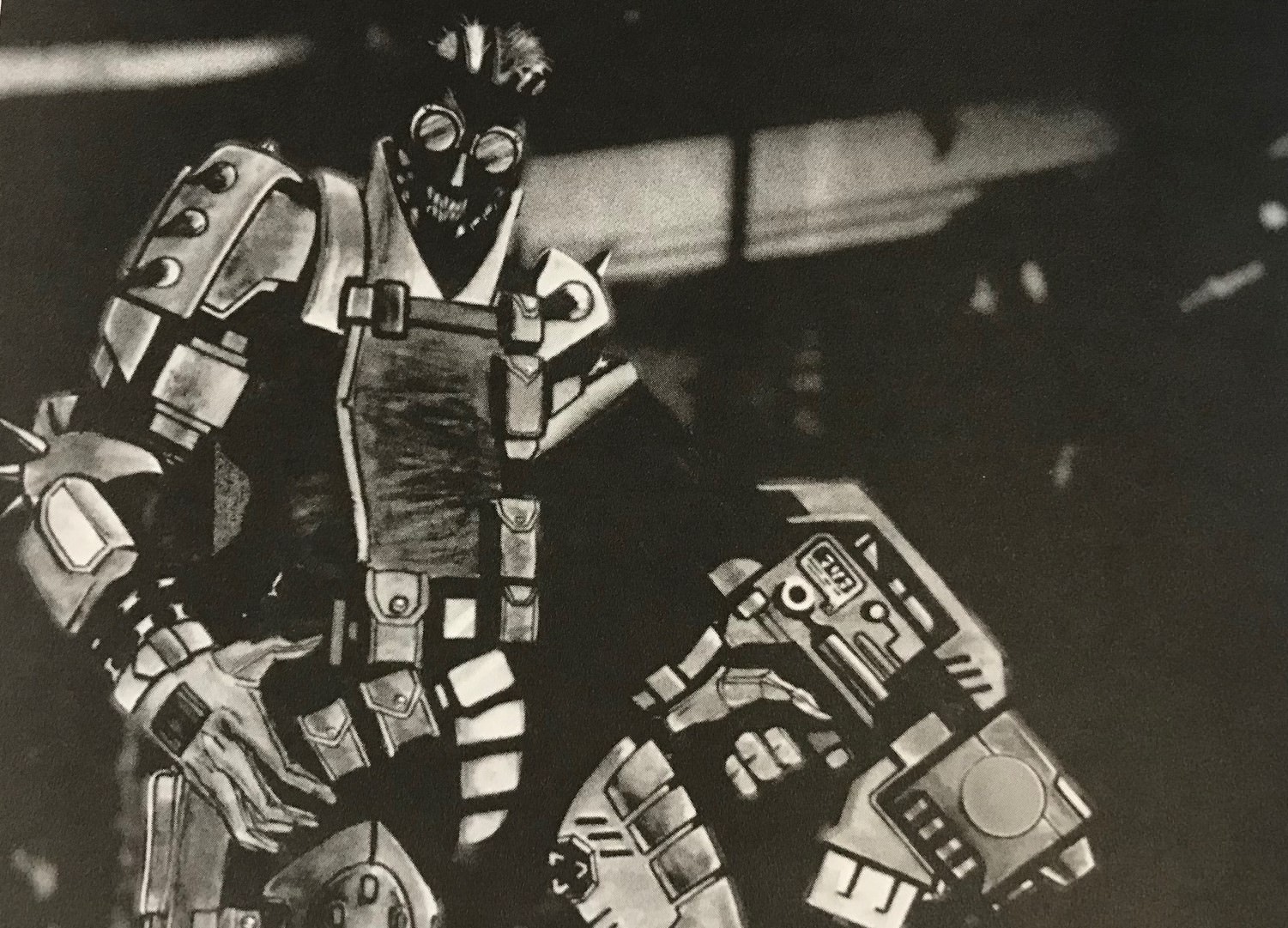
Surely this man is a good guy
With four random rolls and a not rolled at all stat behind us we move onto the point buy part of the character creation process. Each character starts with 20 Generation Points to spend on character development. The book then immediately messes everything up by consistently referring to something called “Starting Points” to the point where I was trying to figure out how you get Starting Points for several pages until I realized they’re supposed to be the same thing.
The important thing about Generation Points is that unlike the Experience Points (XP) we’ll get later they’re way, way, way more useful. It costs a flat 2 Generation Points to raise a skill one level while it costs 2*Current Skill Level XP to raise a skill one level. You cap out at receiving 5 XP per session, so going from Level 5 to 6 through XP costs 2 sessions worth of max rewards.
More importantly, this is the only time you can directly raise attributes at a cost of 6 Generation Points per level raised. This might sound quite steep, but XP can’t do that directly at all. To raise attributes after the character creation process you have to raise every single skill controlled by that attribute to the same level to raise it to that level. There are, for example, 7 skills under the “Knowledge” attribute, so if you don’t boost that at character creation it could be dozens of sessions before that thing ever increases even one point.
None of the information about how many skills per attribute, what skills go with what attributes, or what attributes or skills even do is in this chapter so have fun point buying without any of that information.
If this option paralysis introduced wasn’t bad enough, if you selected a “Mystic” as your Ethos or have 5 Mind or more, you can now blow your Generation points on more spells. Good luck weighing more spells now versus stat boosts, first time player.
With our character now theoretically done, its time to talk about how we improve them with XP. Somewhat sensibly, characters receive XP just by playing the story, with some points like “Survive a Chapter” and “Play upon an Active Motivation” granting what should be free points. Whats unfortunate is the rules state that unless something extraordinary happens, players should only ever receive a maximum of 5 XP a session. This can work fine early on, but as seen the costs of everything skyrockets quickly in Obsidian so sooner or later every session will be people banking XP.
Well they would if there weren’t a pile of very stupid rules the game introduces. The first is suggesting that “The most active player” get a bonus XP versus everyone else which sounds fun for everyone at the table to fight over. Second, the narrator is told they can take away XP if they feel players act against their character or fail to uphold their characters motivations. Third, XP can be used as “Luck Points” which allow you to either re-roll a failed roll or roll an extra die on any check.
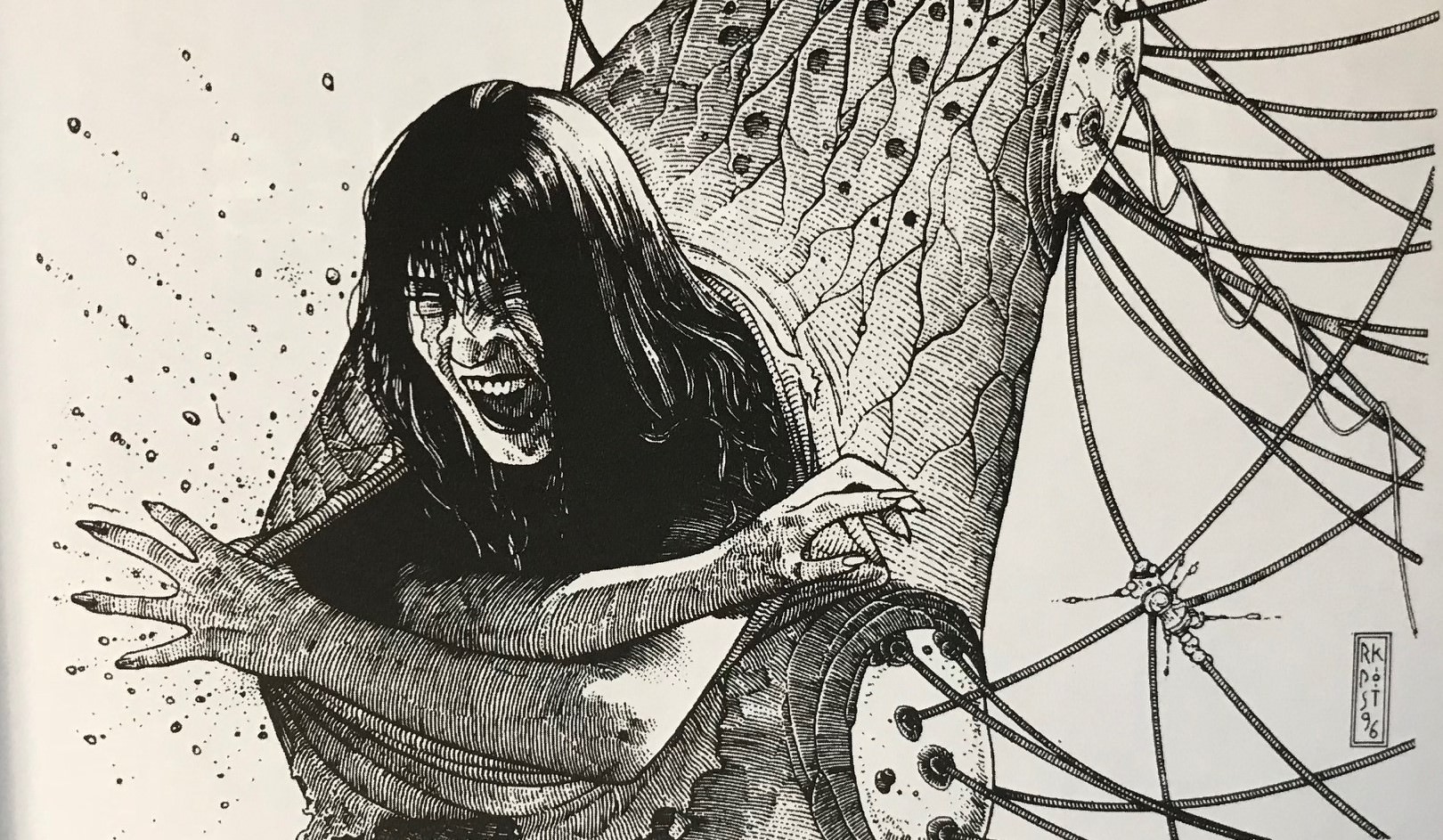
Electro-Tree-Birth is the future of music
Then things go completely off the goddamn rails. Tucked away in this section on XP uses is an explanation that at the start of each play session the Narrator is supposed to randomly choose one character to have an “Ominous Fate” and another to be the bearer of “Destiny”. The narrator is encouraged to spend the entire session making things harder for the Ominous Fate player by having guns jamming in combat, be targeted by enemy attacks over other players, and falling while running away. The character with Destiny, conversely should be given extra benefits like bonus info, easier rolls, etc. What’s important to Obsidian though, is players should never feel sure if they have the Ominous Fate or Destiny because that information is hidden from them.
If that werent dumb enough, it now gets down-right mean. Before a session starts you can spend 1 XP to cancel the chance of receiving the Ominous Fate. You aren’t told if you would have received it or not; you’re blowing your XP simply to pre-emptively make sure you don’t. This means basically every session starts with every player spending 1 XP to avoid having the narrator make your character be bad for an entire play session. I genuinely think this may be the single worst XP on non-progression use I’ve ever seen in a game so congratulations Obsidian.
Next Time: Being Able to Lift a Car Doesn’t Mean You’re Strong
*Would it surprise you to know the index in this book doesn’t work, and almost every entry has page numbers that don’t actually talk about that subject so I can’t be sure if the rule doesn’t exist or if they just have the wrong page number?
Being Able to Lift a Car Doesn’t Mean You’re Strong
Original SA post
Obsidian: The Age of Judgement is a roleplaying game by Apophis Consortium published first in 1999, and this review uses the 2nd Edition from 2001. Written by Micah Skaritka, Dav Harnish, and Frank Nolan. Obsidian is a post-apocalyptic anarchist corporatist literal hell on earth secret knowledge crunchy dice-pool game. It is purchasable online here if you’d like to support the authors of this work.
Part 8: Being Able to Lift a Car Doesn’t Mean You’re Strong
Chapter 3 of the book, titled Regulations, is a bit of a grab-bag chapter. It contains all the rules for Attributes and Skills, how combat works, Skill Checks, spirit walking, driving a car, how scary Demons are, installing cybernetics, and ebola. This is exactly as well thought out as it sounds.
Regulations starts with how skill checks work in Obsidian, which is relatively straight forward. First are static skill checks which are split into 8 tiers of difficulty from Effortless to Hopeless, with the number required to beat increasing in increments of 3 from 3 to 24. Players simply roll their dice against the check, and if they match or beat it, they succeed. Something great that I can’t stress enough is that the game notes what level skill checks are beneath what level skill ranks; a difficulty 15 check (Difficult) is considered an automatic success for character with 6 ranks in a skill. Further, due to player skills increasing in D6 increments, players will have a gentle compounding increasing chances of success for each rank in a skill they go up by as each additional D6 is a +3.5 not a +3.
The other type of skill check is the opposed roll which works exactly as you would expect. Both individuals roll their respective skills, higher one wins. The game has surprisingly few instances where this comes up but if you guessed that the grapple rules rely heavily on this give yourself a pat on the back, but only if you can beat my roll of 14. One unfortunate game-damaging situation opposing rolls comes up is between the “Notice” and “Stealth” skills. These interact through an opposed roll, so if the Narrator asks you to roll Notice, players implicitly now know something is out there stealthing, somewhat undercutting the point.
So with that out of the way, it’s time for Skills and Attributes those funny things that came up constantly when we were selecting our Ethos and Socials. There are six main Attributes, under which Obsidian’s 32 different skills are sorted. The Attributes are Dexterity, Strength, Mechanical, Knowledge, Perception, and Mind. Each Attribute has 5 skills associated with it except Knowledge because “Data” and “Technology” needed to be separate skills as did “Occult” and “Mystical Lore”. Mechanical Attribute is an even weirder grab bag of skills under it because one of its five skills, Cybernetics, is nearly useless unless you also have the skill Medical from Knowledge which is also near useless without Cybernetics so why are these separate skills.
Regardless, something strange is about to happen with this Attributes and Skills. By default, each Skill and Attribute starts at Rank 2 (or 2D in game terms for meaning you roll 2d6 if checking it) and are modified by the Ethos and Social templates characters took during character creation. What’s odd though, is that Skills aren’t derived from Attributes, rather its the other way around. Attributes automatically increase if all the associated Skills are of a higher level than the Attribute. Basically, if every Skill is 3D under a single Attribute, that Attribute becomes 3D as well even if it higher your 2D attribute becomes 3D as well. It doesn’t do anything the other way though; having an Attribute higher than its associate Skills does absolutely nothing.This results in a system where a character could have enough Lift Skill to carry around a tank mounted autocannon as their personal firearm but have the Strength Attribute so low they take a penalty to their total HP. Conversely, a character could know so much general information that they are according to the book, and we quote, “This character is a genius, they definitely have a solid grasp on society and reality” yet be unable to access a computer or tell you what a crime is.

Is this a) A crime a) An Opposed Skill Check c) Both a and b d) Neither a nor b
Now that we all know what the Skills and Attributes actually are and how skill checks are resolved, it is time for the combat rules. Combat is split into turns and rounds; within each round every character gets a number of turns to spend equal to their Dexterity Attribute rank. Most actions characters can take cost one turn with a few taking two, and once a character performs an action on their turn, whether or not it takes one or two turns to actually perform, the next character in the initiative order goes and so on until every character has exhausted all of their turns for that round. If there were two characters one with 3 turns a round and one with 4 and they each spent one point per turn they’d go through the initiative order three times and then the second character would get to spend their final 4th turn unopposed before a new round started and their turns refreshed.
Things that cost 1 turn include dodging, which increases the difficulty of the to-hit skill check against you by one difficulty level for each point of dexterity, jumping in the initiative order to first, and shooting your gun. You may note that this means a character with high dexterity is not only going more often in combat, as long as they have more dexterity than their opponent they can extremely easily just dodge every turn their opponent tries to attack and then once their opponent is helpless to react shoot at them unopposed or just go before their opponents and do what they want to first.
Movement also costs one action and is, as written, terrible. The only thing distance matters for is the difficulty check of a firearms attack which increases every 20 feet you are further away from the enemy. The Move skill, however, is a dice-based random roll skill so at default you move randomly 2-12 feet during your movement phase which is not only awkward to be unable to plan if you’ll even go as far as you want, by default you’ll need at minimum two turns spent on just moving and good rolling to even get 20 feet closer or further from your opponent which is what influences firearm accuracy. Why even bother with this skill when for the same cost you could improve how good you are at shooting people from farther away and thus skip any need to move at all in the first place?
Dealing damage, and how damage works, is when combat starts an rapid, rocket like ascent to being insanely lethal. When you hit an opponent with your gun or melee weapon you roll against a hit location table using a d20 to determine where the damage goes. Each body part has an HP total that typically is a fractional amount of what your total HP is. Your left arm for example has an HP of ½ your max HP. When you take damage you count it against both the part being hit and your total HP, so if your max HP was 12 and you take 6 damage to your left arm not only does your left arm get blown clean off and be useless and give you an ongoing 1 HP damage a round, your total health also drops to 6. This means that you can, with random enough distribution of damage, die without losing any limbs, but losing a limb accelerates your demise like gasoline accelerates a fire.
Things that are bad news for our characters hoping to survive a gunfight get another boost when we find out that losing all the health in your Head, Left Torso, Right Torso, or Abdomen is instant death, even if we have total HP left over. Your head has 1/3rd your max HP and 10% of the time you hit an enemy the damage will go to their head. The absolute worst gun in the game deals 1d10 damage per shot.
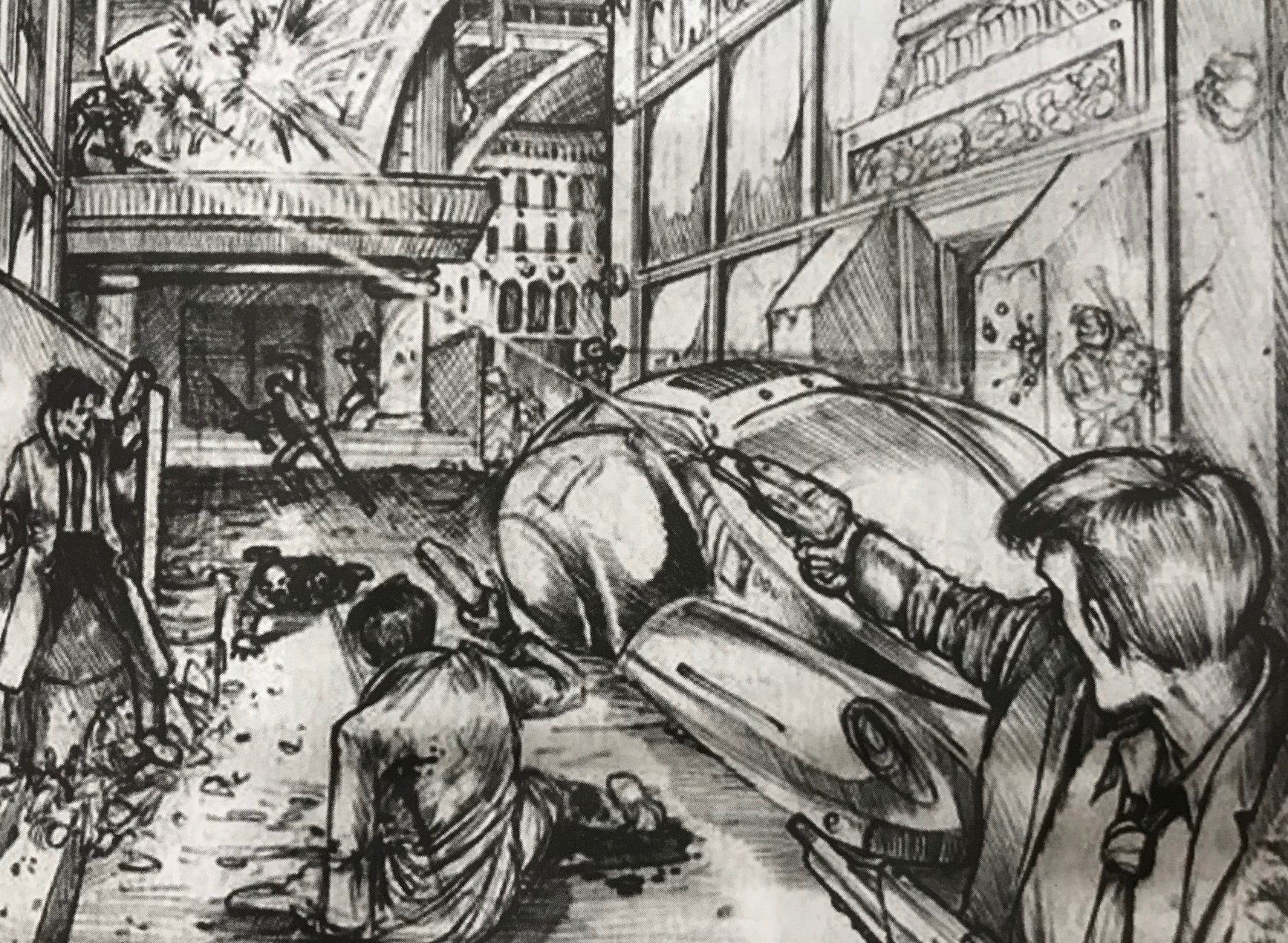
A business lunch goes horribly wrong
Well maybe melee will help balance this out? Oh you gentle soul, melee is a trap that only makes it easier to kill any character attempting to use it. The most powerful melee weapon in the game deals 1d10 damage. All melee attacks must be done at point blank range so you have to spend your random distance move actions to close the gap and then succeed at a minimum difficulty 6 skill check to hit. Melee attacks do not interrupt other characters attacks or make it harder for the character you’re attacking to shoot you. In fact, the difficulty for shooting someone at melee range is 3, one rank easier than using the melee attack. That’s right, the melee warriors reward for several turns of being shot at while rushing towards their gun weilding opponents is to make it even easier to shoot them.
So if being a melee combatant doesn’t help us, what about armor? Well there is a decent chunk of it in the game and it can have decent resistance values. If you don’t buy power armor, and there is absolutely no reason not to unless you just like having worse gear for the same price, certain parts of your body won’t be covered or have lower defensive values. If you do buy power armor you can get up to 24 armor which is a flat reduction, stopping that piddly 1d10 gun in its tracks.
Except for three very important things. First, the range of damage that guns deal is absurd. The weakest gun, as mentioned, is 1d10 damage. The strongest single shot deals 8d10, and the cost of this weapon is completely within the price range of a starting character. If you’ve noticed, 8d10 is by far more than enough to regularly deal 32 points of damage per shot, thus instantly killing anyone in the nicest suit of armor in the game if they score a headshot, congratulations. You are now officially smarter than 3 developers who worked on this system for 5 years and get a gold star.
The second important thing is burst and full auto. These are inherent properties of the guns, and once you get past the very cheapest and worst guns in the game every single one of them has one of these features. Burst means when you shoot the gun it uses up more ammo in the clip, but each time you hit an opponent it deals its damage twice, each shot location being rolled randomly so they may not hit the same part. Full auto uses the entire clip in the gun but deals a number of hits to random body parts equal to the total clip divided by 5, which means the gun can hit for between 3 and 11 times depending on the clip it takes. If two hits end up on the same location, their damage is stacked together, then armor is subtracted. This means that with only 8 hit locations total even a weak gun shooting 11 times has pretty good odds to deal enough damage to bypass armor with enough damage to blow off a limb. Guess what, thats not enough for the designers of Obsidian and shooting in burst or full auto makes you 2 ranks of Firearms more accurate when shooting and has no offsetting penalty other than ammo usage.
The third and final thing is that there are standard combat moves you can make as part of your shooting action that reduce the number of random targets you need to roll between. For making the shot one rank more difficult you can reduce the number of hit locations to six or in exchange for making the shot 3 ranks more difficult you can make it so every single hit lands exclusively on your opponent's head.
Somehow, shooting people is only the second best way to kill people in this game.
Next Time: What is the Latin for “Omae Wa Mou Shindeiru”?
What is the Latin for “Omae Wa Mou Shindeiru”?
Original SA post
Obsidian: The Age of Judgement is a roleplaying game by Apophis Consortium published first in 1999, and this review uses the 2nd Edition from 2001. Written by Micah Skaritka, Dav Harnish, and Frank Nolan. Obsidian is a post-apocalyptic anarchist corporatist literal hell on earth secret knowledge crunchy dice-pool game. It is purchasable online here if you’d like to support the authors of this work.
Part 9: What is the Latin for “Omae Wa Mou Shindeiru”?
We left off last time just having wrapped up the combat rules, so let’s go even further with how poorly conceived they are even for just a starting character. We’ll start by building a character who exploits the gunplay system to its maximum and then we’ll build a character who is game-destroyingly broken from a combat perspective yet doesn’t interact with a single mechanic from the combat chapter.
With no further delay, we introduce you to the first of our examples; Lazarus Manusmortem
We start by selecting Lazarus’ Ethos, and looking over the options note that two of them give bonuses to Knowledge stat and none give bonuses directly to Dexterity, the stat that controls how often he goes in combat. Therefore we have to pick the Ethos “Corporate” which instead of making him tied to the occult aspects of this game makes him a valued asset of a corporation and committed to advancing in their ranks.
For that he gets a +1 rank to two different Attributes of his choice so we’ll take +1 to Dexterity and +1 to Perception. The perception is just for flavor, at rank 3 perception lets him “spot a credbase across the room” which sounds good for our little corporate climber. Also as part of his Corporate package he gets a major contact, so he selects an arms dealer, which lets him legally buy weapons of any class, and he gets 15 corporation points which we’ll assign later as they’re a whole nother subsystem covered in another chapter.
Next, Lazarus needs a primary and secondary Social. As a primary, he takes Executive, which gives him another major contact where he selects a cyber-implanter this time, another 10 corporation points, 3 weeks pay from his corporation (this will eventually be 1,800 credits), and +2 ranks to the Manipulation Skill. As a secondary, he takes Contractor which gives him +1 rank to Dexterity, an Assassin’s License and 1,500 more credits. Our Corporate climber is now Lazarus Manusmortem, Senior Vice President of External Human Relations who is RIP9000 and SixSixSixSigma certified.
We then roll for SVP Lazarus’ stats, getting 16 Lethal HP, 10 Non-Lethal HP, 5,000 more credits, and 3 Spirit.
After that it is time to spend Lazarus’ 20 generation points, which go to raising Dexterity to maximum rank of 5, pushing the Firearms skill to its max rank at character creation of 6, and the remaining points to raise the Lift skill to rank 4.
With that all done, it is time to spend those 25 corporation points. 16 points are spent to give Lazarus the perfect resume to get hired by a Level 4 corporation that is a Cybernetics Designer, 4 points are spent to get Lazarus a well deserved promotion, one point to get a 50% discount on all of the company’s products, and the last 4 points to get 2 months pay in advance for 6,400 credits.
The corporation, being level 4, then has 45 points to spend improving itself. For this combat example, we only need to spend four points to give everyone in our corporation free guns up to Class 3. Everything else is unecessary, but presumably we spend it in the way that gets Lazarus the finest techno-mahogany credits can buy. Thanks to giving everyone in the corporation free guns, Lazarus doesn’t even have to pay for the gun “Riot Control 13” which his Assassin’s License and arms dealer contact make him legal and registered to use.
With our pay advances and savings and rolled cash, Lazarus has 12,900 credits to spend. He doesn’t want to just stay a human, and with 20 humanity points he can spend 4 of them without an repercussions on cybernetics. Luckily, the company Lazarus works for makes them and he gets to buy them at 50% discount due to the point we spent earlier. Lazarus is itching to get the most out of the free gun he got, so he elects for the extremely experimental BioBoosters at max rank of 3 spending 8,000 credits. Lazarus knows the item lets him treat his Dexterity Attribute as if it was three ranks higher, but due to the poorly written instruction manual he’s not sure if it makes all his skills under Dexterity 3 ranks higher or just gives him +9 to any roll using those skills. He decides it must be the latter as the former is just too ridiculous.
Feeling newly invincible, Lazarus decides that armor is for chumps and spends all of the rest of his money on nearly 50 magazines of Class 3 ammo with tracer rounds.
Lazarus Manusmortem is now best summarized as the following:
8 Dexterity
6 Firearms
1 Riot Control 13 Gun
Bullets
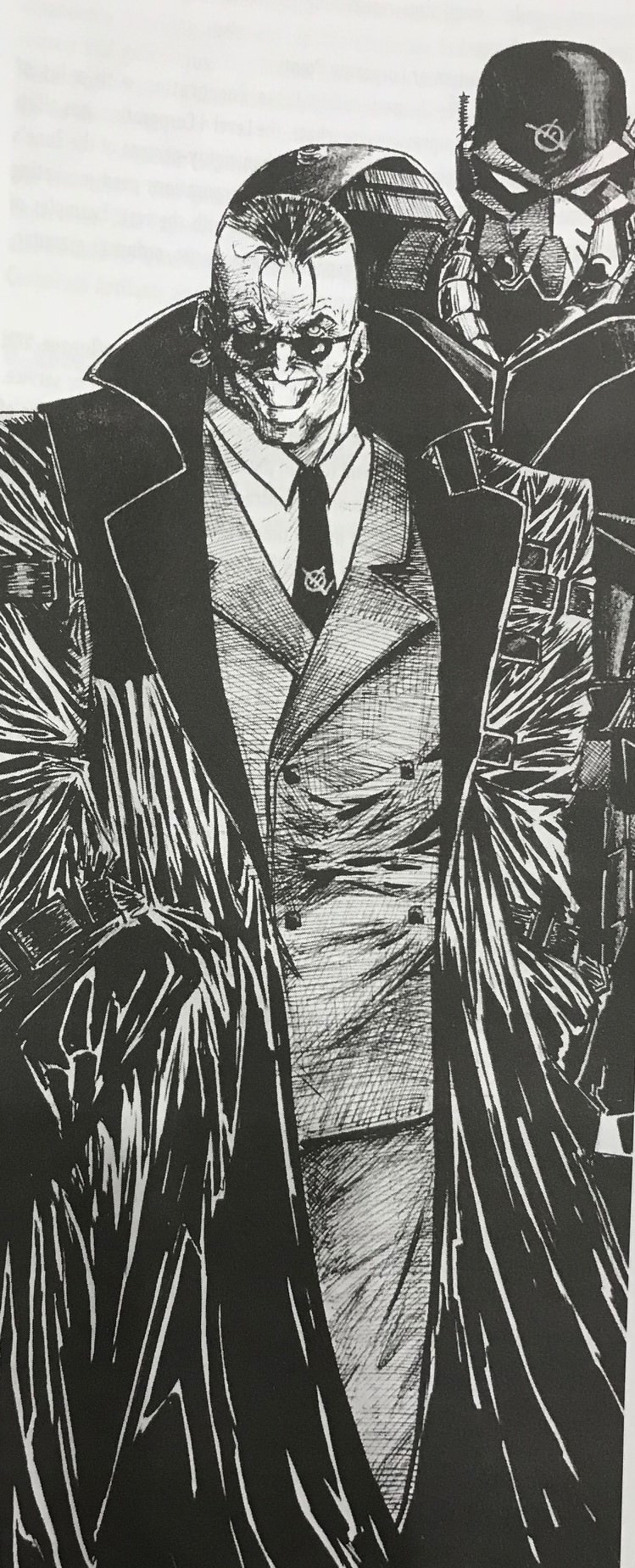
Lazarus and his personal assistant
Now let’s get our SVP into combat with someone, and since Lazarus is climbing the ranks and a real go-getter, he picks a max-health enemy corporation rival wearing the highest value combat armor riding inside a tank. The opposing target has 64 Armor over the entire body (24 personal + 40 tank) with 36 Lethal Health (they invested in Strength to get that bonus health).
Combat begins and Lazarus loses the initiative roll, but before Lazarus’s opponent can go as Lazurus Dexterit is higher, Lazarus spends 1 turn to ignore intiative order and go first. He uses this turn to then spend a turn aiming for a +2 ranks to hit. He then does this 2 more times while his foe can only helplessly stare on, for a total of +6 ranks to aim. Then on his last boosted to go first action to fire full auto for another +2 to aim and thanks to using tracer rounds he gets a final +1 to aim so he decides to shoot aiming at their head which is -3 ranks to aim and his gun has a -1 penalty to aim. The opponent, luckily, was already traveling at 60 miles per hour which reduces Lazarus’ aim by another 3 ranks.
The max range for Lazarus’s gun is 700 ft, so let’s assume he’s standing exactly 700 ft away from the target. All ranges of over 120 ft are considered an impossible check. The opponent has wisely managed to lower Lazarus’ accuracy by 7 ranks beyond that, but unfortunately, Lazarus has a +9 ranks to Firearms at this point, so instead of looking at an impossible check, he’s looking at a skill check that is merely “Difficult”. As you may recall, based on your ranks in an associated skill you may not even have to do the check, which thanks to Lazarus’ 6 Firearms skill rank, means he automatically succeeds at all Difficult checks with no need to roll.
With a hit on the opponent’s head, we now roll Lazarus’ damage. Full auto uses every bullet in the clip, but for every five bullets one additional point of damage is dealt. The Riot Control 13 has a special property, it carries two clips of ammunition that it fires if used full auto, doubling the ammo consumed but also doubling the damage. The number of bullets though, is all that matters for calculating the number of hits the full auto mode will deal. This means Lazarus’ attack consists 14 hits of 6d10 damage. Remember, every hit that lands in the same place stacks damage before armor is subtracted at the end. The head’s maximum health is actually only 1/3rd the total lethal HP, so we only need to deal 13 points of damage after armor.
On average, Lazarus Manusmortem does 398 damage to the opponents head, after reducing the damage from armor.
But what if the other character is actually a teeny-tiny mouse, they’re dodging around inside the tank, going its max speed of 200 miles an hour, and was in the middle of moving around inside the tank between cover and Lazarus has decided he’s ok with having to roll for the difficulty? Well unfortunately for the person he’s shooting at, every reduction to aiming doesn’t actually add any number directly to the skill check, it simply makes it one more rank difficult. The game is actually weirdly explicit about this, probably a mistake caused by using natural language here, but it has a very very bad outcome. There is no rank more difficult than “Hopeless”, so the maximum difficulty for shooting at someone as a skill check is 24. Lazarus has 6d6 to roll when he uses the firearm skill, and his bio boosters give him an additional flat +9 to the roll so, on average, Lazarus rolls a 30 for this check.
There is basically no opponent Lazarus can’t simply turn order jump in front of and instantly shoot to death, and can do this to four opponents a round.
Lazarus can’t beat the next character we create no matter how hard he tries
Let’s introduce you to Lilith Kapital.
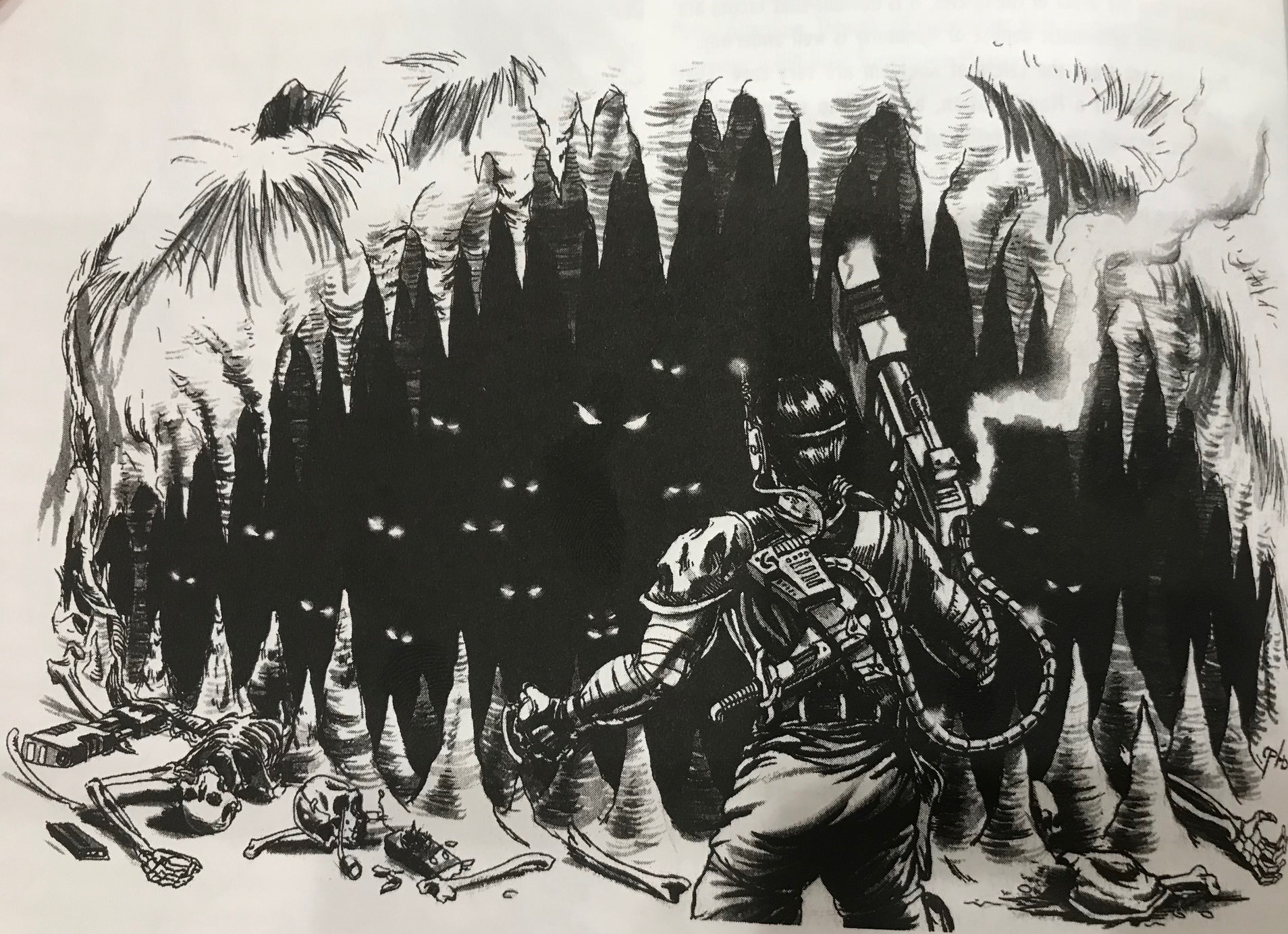
It’s already too late, you know that somewhere, somehow, she exists
Lilith actually chose the same Ethos and Socials as Lazarus, but she’s not even going to worry about herself and is going to devote herself entirely to her corporate career. She’s going to use her generation points to boost her corporation, Lilith Kapital, LLC of which she is the only member, which gives giving her 20 more points for a total of 45 corporation points to start with. She’ll spend 24 of these to join a Class 6 corporation, something on par with the Government of the Zone, and 16 points to schmooze the right people to get herself promoted to the highest level you can buy your way into, Rank 4. She doesn’t need the five leftover points and presumably donates them to a charity that prepares children for a career by crushing their hopes and dreams.
The corporation she joins, being Class 6, has 90 points to spend improving itself. The company she works for spends all of these points buying the corporation feature “Fear and Respect” 9 times. This skill makes it so that members of the corporation get two terror points per rank in the corporation per purchase of this feature + the class of the level of the corporation. Lillith is rank 4 position in a corporation, meaning each purchase of this skill is worth 8 terror points to her, for a total rating of 78 after including the corporation level of 6. For comparison sake, the highest terror rating by any monster in the book is 25.
Anyone who is in range of any sensory stimuli of her, or attempts to interact with her mechanically like by combat, or as the book states are simply aware that Lilith exists at all must make a Restraint Skill check with the difficulty score equal to her Terror Rating. A starting character can have up to a Restraint rank of 6, for a maximum possible roll of 36 compared to Lilith’s terror rating of 78.
Anyone who fails a terror rating induced restraint skill check by 24 or more immediately dies from the fear.
Upon completing character creation everyone who ever knew Lilith dies immediately, anyone who sees or hears her dies, anybody who tries to lay a trap for the thing that killed everyone else dies because their trap had to interact with her, and presumably everyone else left alive dies because after realizing that something is killing everyone else the idea that something could do that is, itself, Lilith which triggers a terror rating check.
Maybe players should stick to the overpowered firearms if they’re going to play Obsidian.
Next Time: A Monthly Crate of Random Rules
A Monthly Crate of Random Rules
Original SA post
Obsidian: The Age of Judgement is a roleplaying game by Apophis Consortium published first in 1999, and this review uses the 2nd Edition from 2001. Written by Micah Skaritka, Dav Harnish, and Frank Nolan. Obsidian is a post-apocalyptic anarchist corporatist literal hell on earth secret knowledge crunchy dice-pool game. It is purchasable online here if you’d like to support the authors of this work.
Part 10: A Monthly Crate of Random Rules
The rest of Chapter 3, which so far has been finishing character creation and combat rules, is a complete grab bag of content with no real rhyme or placement to it. Normally in a game you’d put all the mini-systems into a single chapter but not Obsidian, oh no. We’ll figure out how disease work here, in another chapter find drugs, and in another how to set up our corporation. A particularly glaring example here in this chapter is that the rules on radiation don’t note how you can cure it, which is buried in another chapter in item descriptions.
The first thing we learn now is rules for driving and equipping weapons to vehicles. Everything is done in “Marks” which are just 10 mile per hour increments making the term Mark so redundant that the books own authors regularly just refer to speeds in MPH. Weapon mounting implies a massively more complicated combat system than the one we just read about including features like partial cover, weapon’s degree of swivel, and turning radius of vehicles.
The last thing I want to call out is a complete failure of natural language ”When an object collides with a vehicle, the amount of damage (which negates soft armor) that occurs to the vehicle is 1d8/Mark of speed.[...]The passengers receive an amount of damage equal to half the vehicles damage[...]” You know what is an “object” in the game? A cell-phone. Hit that indestructible juggernaut of an object going 60 in your armored battle tank and kiss your characters goodby when all of you take 6d8 damage.
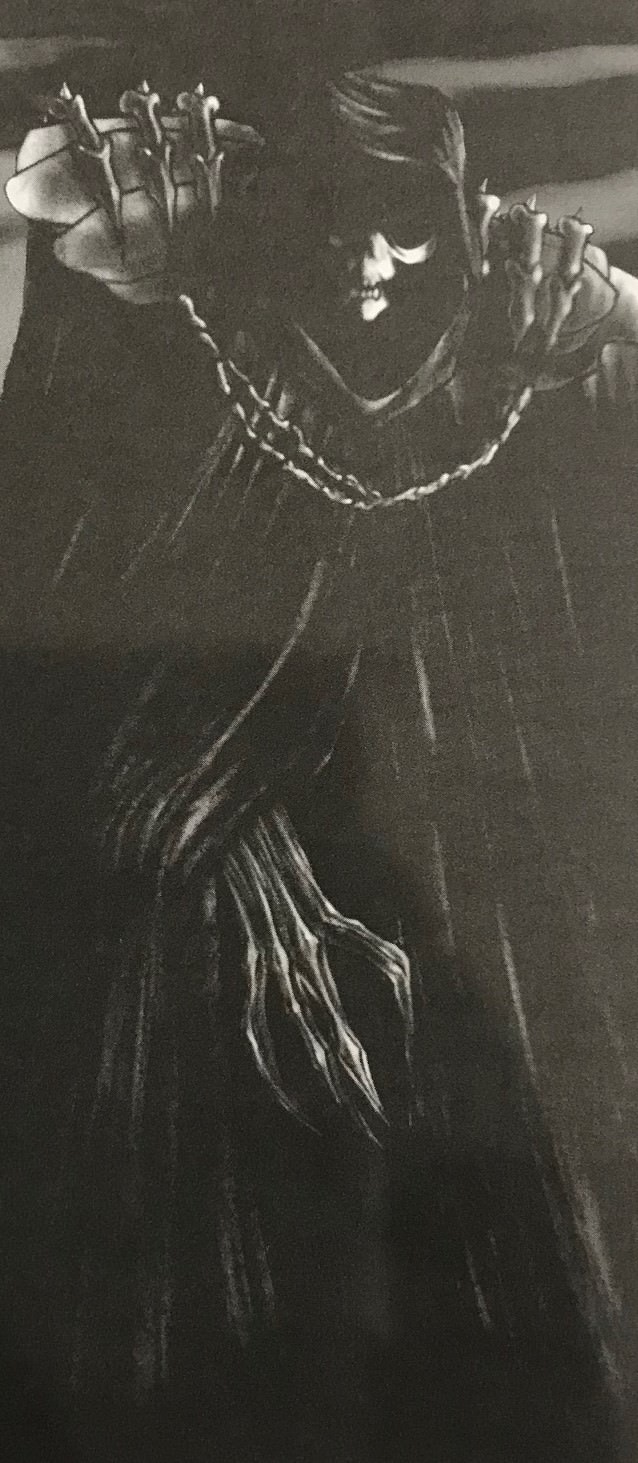
Does this look infected?
Next is radiation which we can’t cure until many pages later than now and comes in six tiers. Well, really five tiers because the people writing this book apparently don’t know how to process sequential events. Once you’re dosed with radiation, any subsequent dose of smaller or equal size bumps you up to the next size. Tier 5 radiation says everyone around you gets a Tier 3 dose which in turn says everyone around you gets a Tier 1 dose, which pushes the Tier 5 person to Tier 6 (instant death) and then pushes all the Tier 3s to the next tier which causes them to all redose each other until they hit Tier 6 and die as well.
After that it is three straight pages of diseases, including how they’re contracted, how difficult they are to cure, and what they’re effects are. Basically all of them are some variation of “re-roll your character” or “fuck you” ranging from “you die in horrible agony in an hour” to “your character goes blind, there is no cure, and even if you install cyber-eyes you have permanent visual hallucinations”
I’d like to pause to reflect on the name for one of the diseases - Ebola Extreme
After that is “Forms of the Spirit”. Do you vaguely remember how we had to roll Spirit points at character creation? This is one of their two uses and boy is it both useless and sure to grind your game session to a halt. Suddenly, despite there being literally 28 pages of story and setting detail we’re told that there is now an entire realm of spirits where people do spirit battle. This has never, ever come up before and the name of this dimension is TERRADAENIME and is written exactly like that with the bold and all caps.
TERRADAENIME in addition to sounding like “Earths Big Anime” is where your spirit is free to wander around if you cut it loose or if you die. This section just haphazardly notes that Heaven is real since your soul goes there after going to TERRADAENIME so what in the blue-blazes are the 8 circles and Sheol and all that junk? This sort of derails the entire setting and then Obsidian further notes that the Hells need souls from this dimension to cross over their followers even though the current setting exists because they already did that.
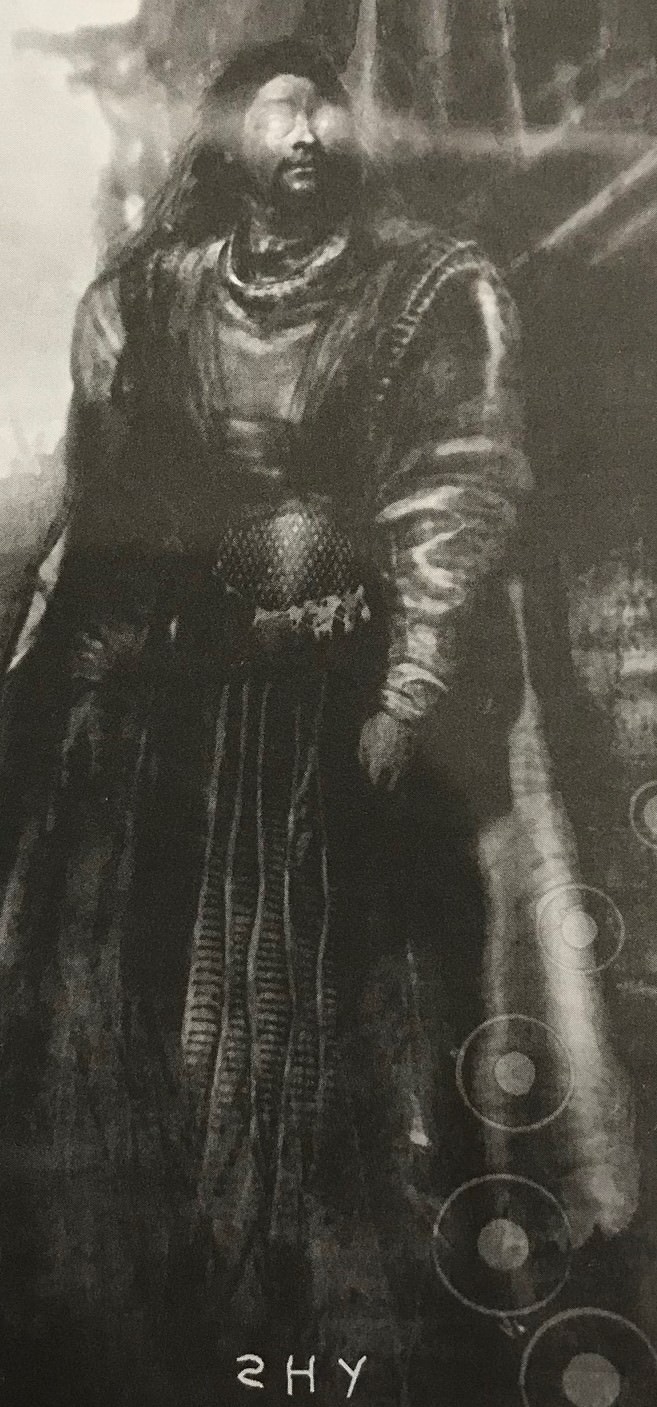
TERRADAENIME
Ok, fine, so what do we get for interacting with TERRADAENIME? Not a whole lot as it turns out. First, to even go to it you either need to die or specialize your character to specifically interacting with it, which means unless you had a total party wipe to something most of your table will be sitting around twiddling their thumbs while one person does stuff there. You can travel freely through walls and see… nothing really the game notes everything is blurry and distorted. You can also talk to other wandering spirits here but you need 4 ranks or more in specific skills to even be able to talk to them and interpreting it can require, other, different skills.
Even better, despite being allowed to, rather easily, build a character intended to do this at character creation the game explicitly notes that your characters shouldn’t know this exists at all unless they have again, high ranks in another different skill. That’s right, you can build a character to do exactly one thing in the game and then be told you can’t do it all due to game fiat of your character not knowing that they can, despite having the skills to do so. It gets even worse, because Spirit is a random roll at chargen so even if you build a character explicitly to do this one game mechanic, you could be terrible at it since you rolled poorly.
Oh I lied, no this is the worse part, if you die in spirit form you die forever. Every hour in spirit form takes one point of spirit, going to 0 kills you. Corporations have technology to scan for and spot Spirits to prevent corporate espionage this way. Spirit combat is crazy deadly only for player characters*. Your spirit glows brilliant and bright while in TERRADAENIME and all demons and evil spirits can see it from everywhere else in the world and target you.
With Spirit score being a total disappointment we move onto that Humanity score from character creation. This system isn’t anywhere near as terrible, but there isn’t much reason to ever interact with it. The only thing that lowers your humanity rating are cybernetic parts, and you don’t have any penalties as long as you stay about 15 humanity, which is more than enough to install most useful cybernetics. This is really good because the first penalty you take is a 1 rank loss to mind and a 1 point loss in Spirit which unless you invested in the Mind Attribute is instant death for 1/3rd of all characters at character creation due to Spirit loss.
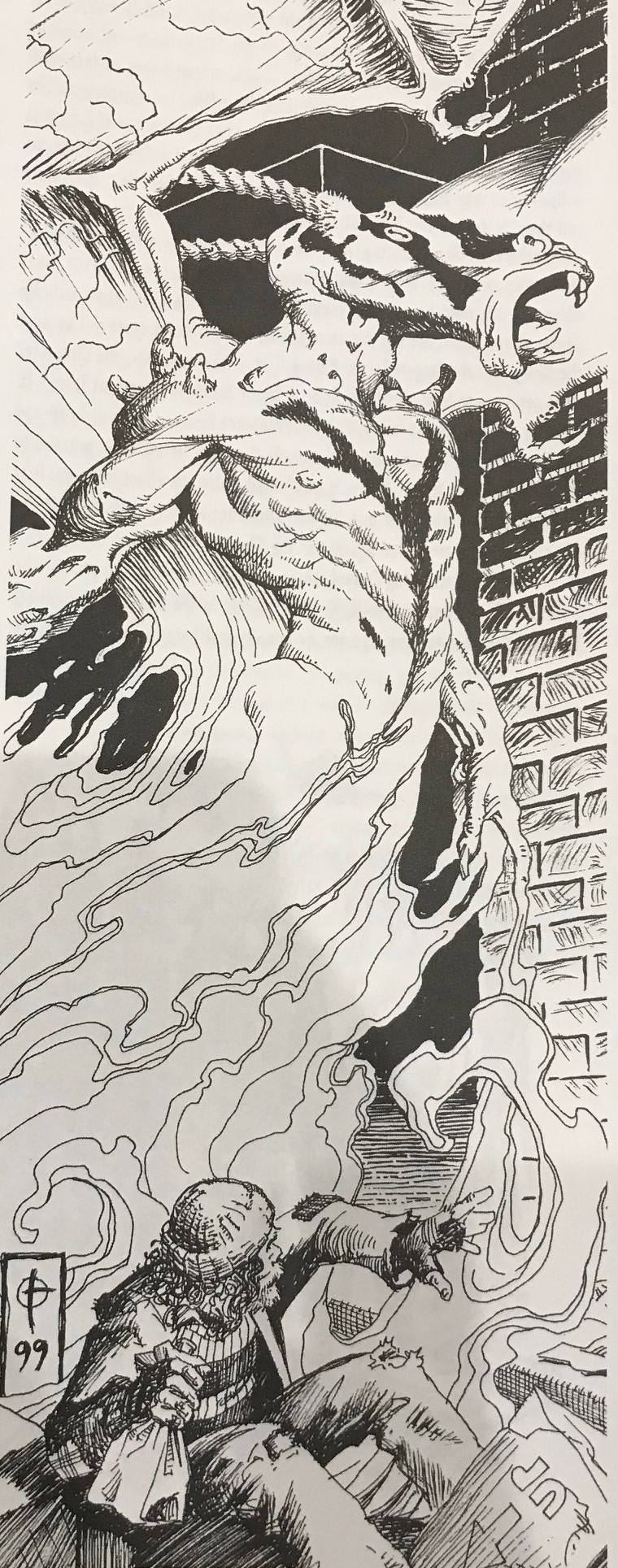
There are no brick buildings in this setting, so where is this?
Abruptly we shift over to the Portals of Hell, which is mostly just flavor and justification for how demons summon more demons to Earth to provide specific, ambient, boss chamber locations. Every portal has to have a guardian or it collapses, every portal can only be initially opened by a different special type of demon. Portals require constant maintenance so you need a set location to have it in. The rules for this are extremely specific and detailed, you could run an entire campaign playing Demon Portal Actuary and balancing your spirits and sacrifices checkbook.
After that it’s Terror Ratings, which we already covered with Lilith Kapital although I found out if your humanity is low enough you become flat out immune to them. Good thing for Lilith the only people who can survive to that depth of humanity score don’t exist as written in the game since it requires a PC specifically geared up to do it without dying due to Spirit loss and, even if they survive to that level, they explicitly can’t form memories and are in constant catatonic fugue devoid of human thought processes so she can just wait for them to starve or forget to breathe.
If you thought this chapter was surely done by now, look at how wrong you are. Instead it closes out with four paragraphs, each on how to install different parts into cars, buildings, and people and the general rules for that. Why this isn’t in the section about those items which is two chapters away from here is probably because Obsidian really wants you to enjoy the time you spend flipping pages in a book desperately looking for the information you need.
Next Time: Spell is not a Synonym for Inhabitant
*Your spirit score is both your health and your damage output. You can’t get spirit armor, but enemies can. You may note this means if you get hit once by an enemy you enter into a near-immediate death spiral where you can’t even harm your remaining foes and have permanently lost character points and that’s for a max score character
Spell is not a Synonym for Inhabitant
Original SA post
Obsidian: The Age of Judgement is a roleplaying game by Apophis Consortium published first in 1999, and this review uses the 2nd Edition from 2001. Written by Micah Skaritka, Dav Harnish, and Frank Nolan. Obsidian is a post-apocalyptic anarchist corporatist literal hell on earth secret knowledge crunchy dice-pool game. It is purchasable online here if you’d like to support the authors of this work.
Part 11: Spell is not a Synonym for Inhabitant
The next chapter is titled “Inhabitants” and despite being 59 pages long there are maybe two pages which could, at best, be charitably described as being about the actual Inhabitants of anything. Instead, this is the Magic section of the book, outlining the magic system for good guys, bad guys, and how sick-leave works for Corporations. PTO is a kind of magic, right? And magic comes from the root Latin inhabitamagicus, right?
Before we get into any of that, we meet up with the same awful characters in the story that kicked off the previous chapter doing almost the exact same thing but with a different client. No really, the same guy gets hired to destroy the same object and brings along the same friends to help him and has the same sweaty reaction to how evil his client is but the only changes are the client is a different person and there is no woman getting nonchalantly murdered in the background. Oh, and since we just finished the section explaining how the mcguffin in this story works mechanically we can safely say that everyone in this story are idiots because that isn’t what the item actually does in game.
Moving onto the magic, oh wait, no time for more fluff! The game re-tells the story from earlier in the book of how humans got magic in this setting except the details are almost all changed except the number of humans who receive the gift so I envy all of you reading this who already forgot that any of that happened. We do get another hilarious setting detail which is that despite the game earlier mentioning that the Zone/Bastion/Last Human City blows up and destroys any demons that get close, they just sort of built the city around some demons so the whole thing is riddled with them. Despite this massive city being built with demons inside of it, the average human somehow doesn’t know that demons are inside the city even though that would be like, I dunno, the absolute single most important thing for them to be aware of at literally all times.
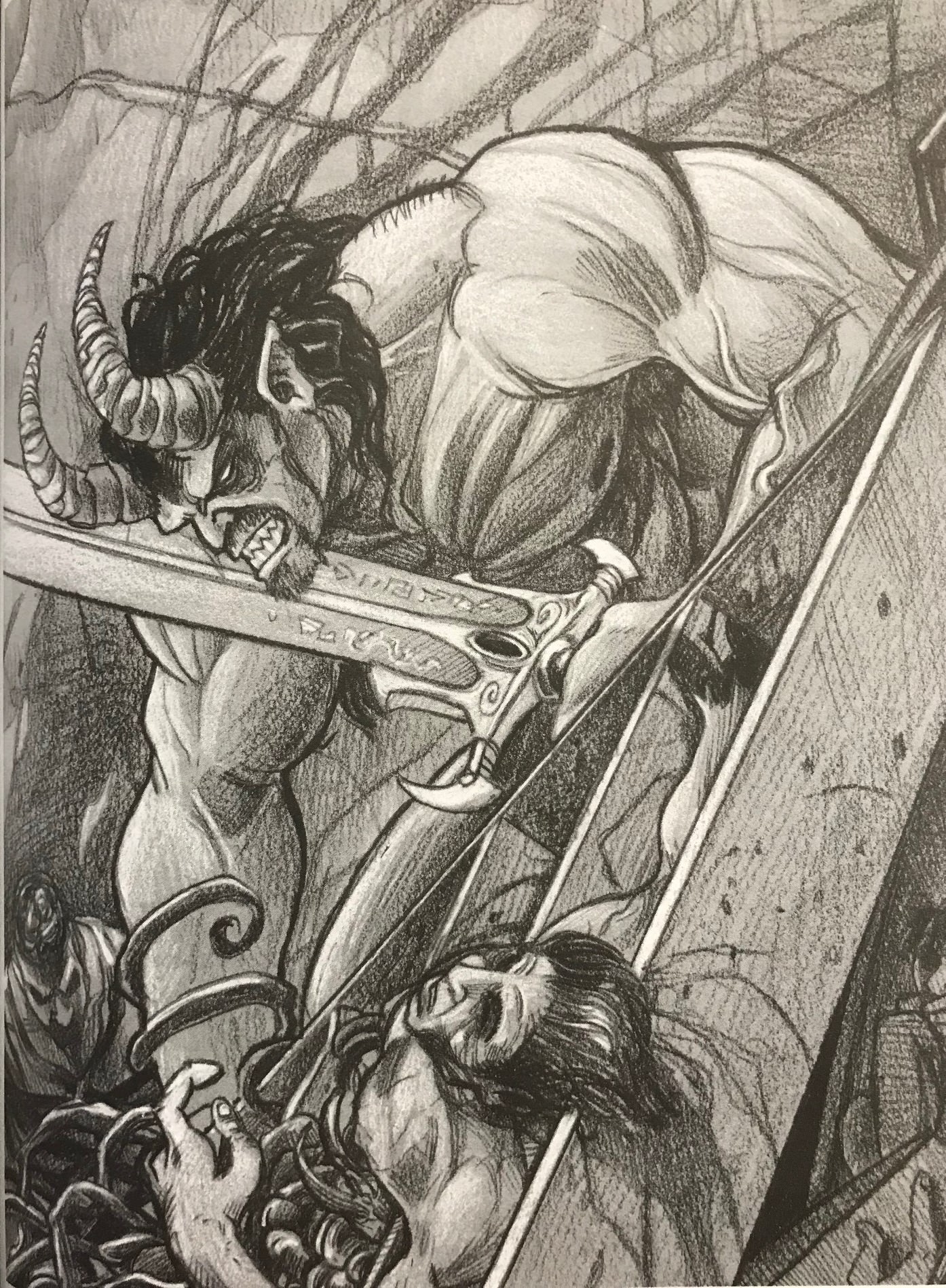
I don’t see why people are scared of demon’s when they cut off their own heads a lot
Anyway, good spell casters*, called Mystics, have three different spell schools Alter, Vision, and True Mystics. There are actually only two spell schools for Mystics because True Mystics cast from either of the other ones and have no spells of their own. Mystic magic is fairly intuitive; you have no MP or casts per day, everything just recharges over the course of a different amount of turns. Schools are further split into “rituals” which contain groups of spells of different strengths and recharge rates which you must buy sequentially. All in all its decently well thought out even if, as you may surmise, there is absolutely no balancing done between the Rituals, spells within a ritual, or making sure that skills have enough mechanical foundation to not feel merely as fluff.
It’s also hurt somewhat by having spells have checks that need to be made against them to actually function. The checks are for the most part extremely easy for a caster to nearly always succeed at and a non-caster to regularly fail. It seems an elegant way to prevent non-casters from stepping on casters toes, but remember a caster gets special points to invest into spells that a non-caster doesn’t at character creation so all this does is introduce a trap character design.
This is a minor complaint but it bugs me in terms of layout, as your Mind stat increases, the rate at which you refresh spells increases and they included a chart to show this. The chart goes from 1 to 6 Mind, but then in the notes explaining how the chart works explains what happens if you have 7 Mind. Why not just include that into the chart? What happens if I hit 8 Mind, do I not get any more benefits? Even more irritating, unless you built a trap character at character creation its not possible to have less than 4 Mind as a spellcaster, so why even show the refresh rates at Mind 1-3?
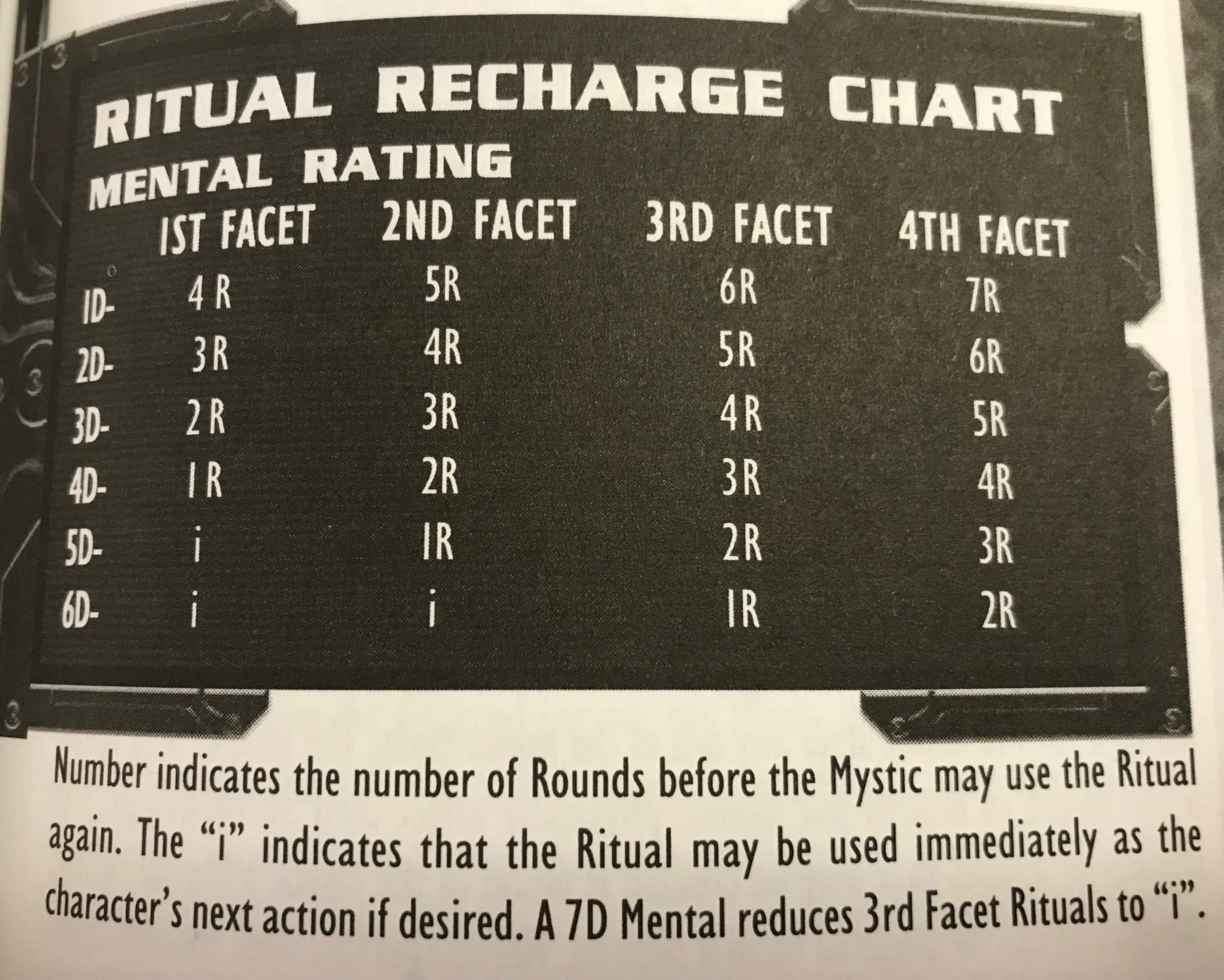
The chart in question, flaunting its crimes
Natural Language is Terrible for RPGs Segue: One cap-stone spell is written like it should make you immune to Terror Ratings. What the mechanical description says, however, is you don’t have to roll against Terror Ratings which, as written, just means you automatically fail them**.
With the Mystics wrapped up, lets finally take a look at how being a
In order to cast a Kultist spell, you have to have a certain number of spirit points on hand. Not your spirit points, though, the spirit points of a spirit that is housed in your Kultist Blade. How do you get a spirit in there? Well you have two options. The first is to find a recently deceased person and use your Call rating as a check to see if you can trick them into getting into your blade which results in getting less than that Spirit’s max spirit points since its been decaying a little bit and its a higher difficulty roll for the same reasoning. The other option is to kill someone with your spirit blade and while your knife is in them do the Call rating check to see if you can trick their spirit into your blade.
For the record: Tricking a spirit into your knife is easier when you are the person who literally just stabbed them to death
With the spirit in your blade and it’s spirit points at your call, you can now cast spells from the Kult you belong to and the spells you bought while in its service. Each spell has an amount of spirit points it requires to cast and once used those spirit points are lost forever. As a benefit, Kultist magic has no skill check to cast so it can never fail. Lets now go over why this system is terrible.
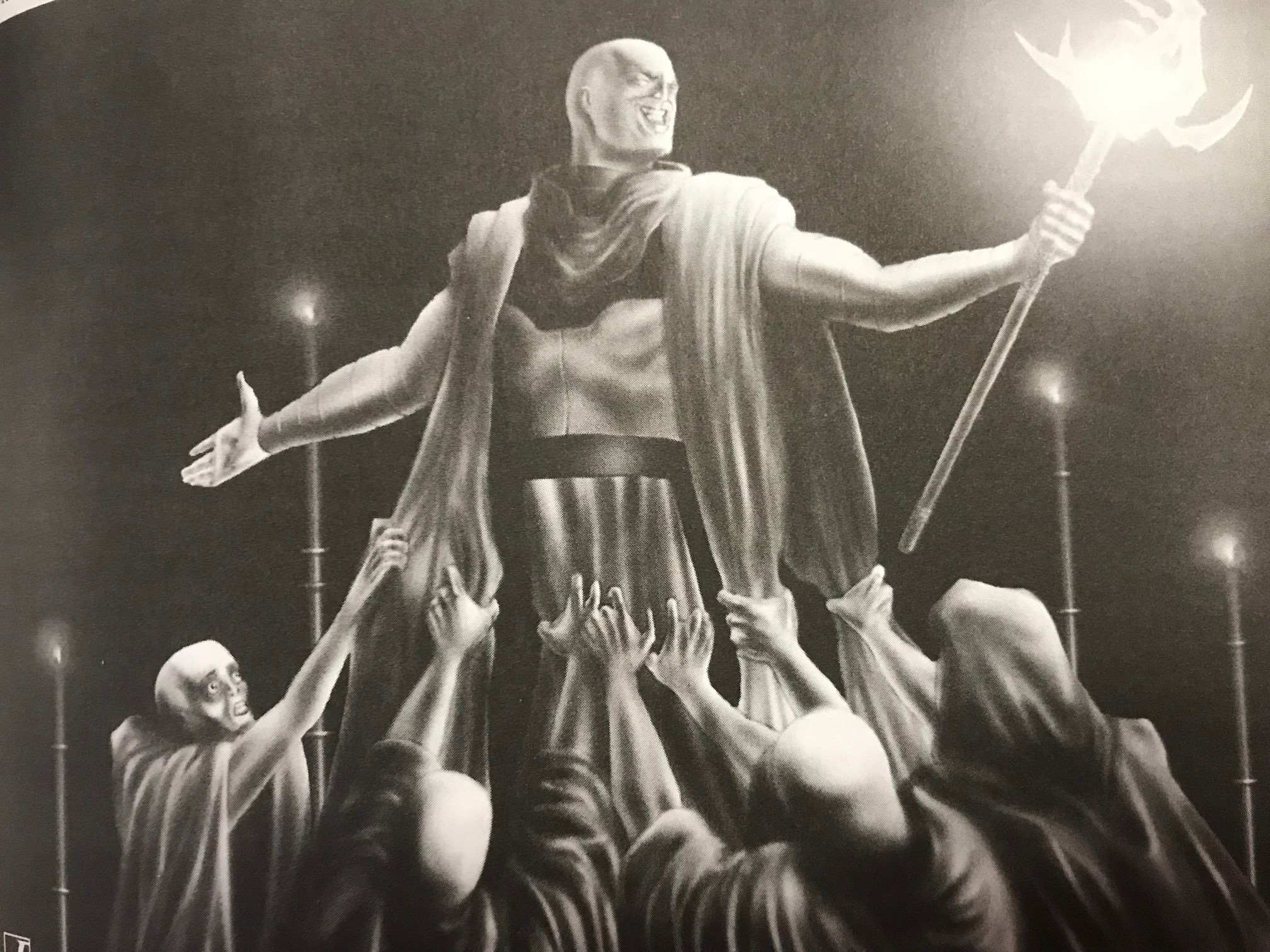
Save or Die? No, my friends, there is no save
Everything Wrong with Kultist Magic
- Kultists hog the limelight in combat and makes themselves massive, easy to kill targets due to needing to secure the finishing blow with absolutely dreadful melee weapons
- Kultists get random amounts of their casting resources even when successfully playing their mini-game and it’s perfectly possible to get a 0 point Spirit so the whole thing was a waste of time
- Kultists can’t share Spirits in the party, if you have two Kultists they’re competing for the exact same random resources
- Kultists ability to contribute is entirely determined by a roll whose only way to boost is Narrator fiat
- The Kultist, however, could just spend the entire game sitting to the side rolling their dice over and over and over and over again until they get lucky and scoop up a six spirit point spirit, thus bypassing all the above stuff at the cost of “playing the game”
- Kultists gain the ability to get more spells not on XP but on fully spending spirits they capture creating even more perverse incentives for the Kultist player
- Kultist magic is balanced around the assumption that grinding spirits and spending spirits is too laborious for a player to do so it is bonkers broken.
- NPC Kultists use all the same rules and spells as players
- One spell is the target is teleported away to a pocket dimension and instantly dies, no saves
- One spell lets you instantly jump to any backup body you’ve made, anywhere on the planet at any time at no risk
- One spell immediately reduces the targeted Kultists caster stats to the minimum and they lose all of their spells
- One spell lets you create a 100% loyal clone of yourself that can do everything you can, such as gathering spirits, but with 1 less point in each major stat. You may create an infinite number of these clones at the same power level.
- One spell is called Terror Whore
Thats the magic section down, so next time lets figure out how to build our own corporation and staff it and what pay schedules we need to follow.
Next Time: Refer to Form 103-2
*”Good” here includes making liberal use of memory-erasing, will-controlling, panopticon magics in addition to using magic to put people into solitary isolation in their own homes.
**It also notes you’ll still flee from fights where the odds are bleak, so wouldn’t a fight where all your friends explode due to failed terror ratings still trigger this?
Refer to Form 103-2
Original SA post
Obsidian: The Age of Judgement is a roleplaying game by Apophis Consortium published first in 1999, and this review uses the 2nd Edition from 2001. Written by Micah Skaritka, Dav Harnish, and Frank Nolan. Obsidian is a post-apocalyptic anarchist corporatist literal hell on earth secret knowledge crunchy dice-pool game. It is purchasable online here if you’d like to support the authors of this work.
Part 11: Refer to Form 103-2
The rest of the “Inhabitants” chapter is about how to build, manage, be a member of, and operate corporations in a zone. If you thought that Obsidian might have put the sections on the schools of magic in the same chapter as corporate governance as a commentary on the similarities between them and their blending nature between magic and human society in the setting you thought wrong.
Corporations are divvied up into 6 tiers of size, from the smallest which are “extortionist gangs” and “prostitution rings” to the largest which are equivalent to the government of the setting which sort of begs some questions the game doesn’t bother to address. If you haven’t gotten your fill of the number six at this point in the game, you’ll be thrilled to know that every corporation only has six possible employment ranks in it. At the bottom and top levels they use religious titles of authority like Archbishop, but in the middle the whole thing gets muddled with titles like “Circuits” and whatever the designers “Neobellum” translated to.

Subtlety is dead and we have killed it
Each of these positions have very specific, rigidly defined pay-scales, authority, and ability to control their employees under them based on the rank and size of the corporation. How is this enforced in our techno-corporate dystopia? More pressingly the game made 30 credits sound like a huge sum of money but the absolute lowest “drug runner” can not make less than 300 credits a week with their housing costing 250 credits a month. The richest person in the game only makes 100 times the poorest person in this game so I’m not sure Obsidian is totally aware its dystopic corporate hellscape is actually pretty fair.
As a member of a corporation you have certain, irrevocable rights regardless of your level in the business. By being a good employee, and good here is simply “follow your direct supervisors orders” or “be put into harms way by your corporation”, you earn points you can spend in your corporation. These points can be spent on things like getting an entire months pay in advance, taking an immediate pay bonus, getting some sick days, getting a raise, access to your companies entire network of specialist employees, or free rent amongst a huge list of things you can do. The only really dumb one is getting the ability to generate free points for yourself as anyone else in the corporation can spend the same points to cancel out yours so it’s entirely whether you Narrator wants to be a jerk about letting you keep the reward.
After that its a detailing of exactly how many members of every rank a corporation has to have and then a list of things corporations can buy when you are developing them. By buying these things, you also increase the number of employees a corporation can have, and they stack up really quickly so even a tier 2 player corporation will have well over 300 employees. There aren’t any rules for how to generate these points after character creation even though that seems to be the entire point of this section to have characters build their own business from the ground up as a long-term roleplaying thing so ask your
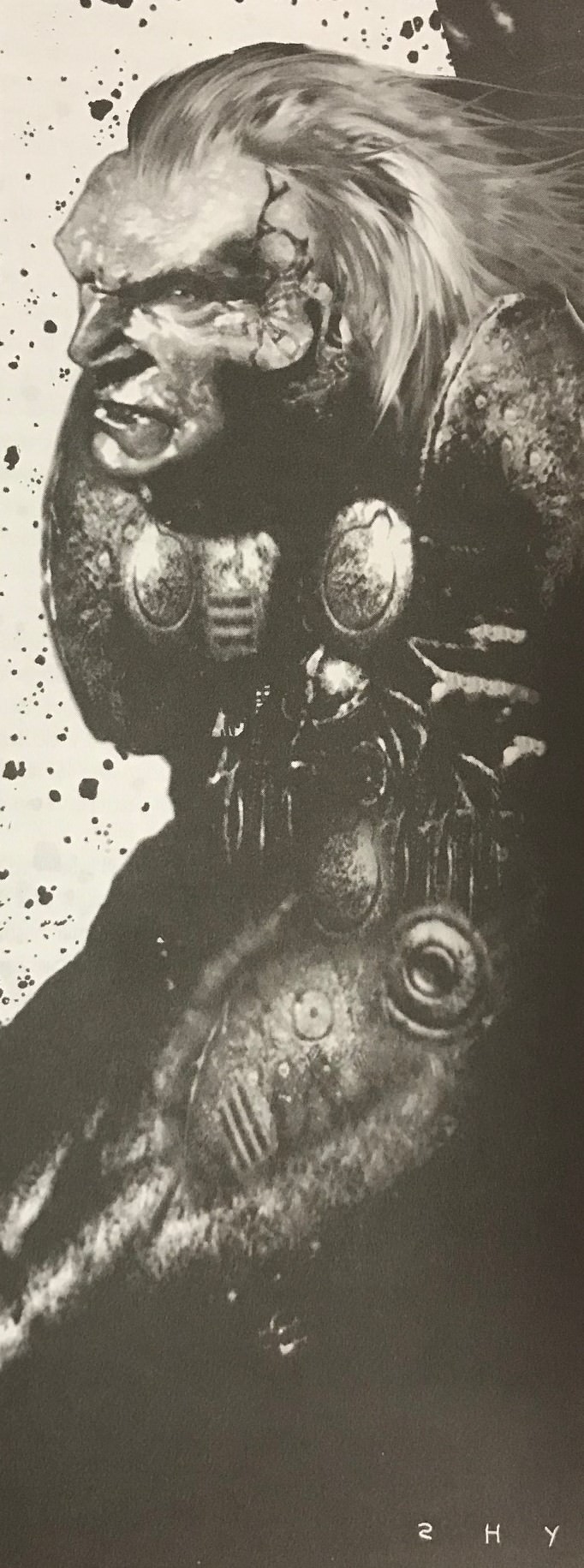
I’m not sure you’d want to “contact” him. Get it? Get it? Philistines
After that it is the list of what you can buy and it varies from the bad like a Warehouse which has no mechanical rules whatsoever to the offensive like Slave Labor to the previously mentioned weaponized business acumen that causes everybody else to die because wording mechanics in natural language is never, ever a good idea. If none of that sounds your cup of tea a starting character who makes no investments into any additional corporate points is perfectly able to buy corporate traits like “Employment Benefits” and “On Base Living” so they never pay rent, get free medical care, and automatic ongoing raises. Obsidian’s apocalypse may have killed almost the entire human race but it solved the housing crisis and unleashed powerful labor laws.
In addition to things, corporations can have contacts although some character templates also grant these. These contacts basically function as little more than keys to access some upgrade. One contact gives you the ability to buy legal heavy weaponry, another access to higher tier spells, another body modification, and you get the picture. The least well explained one is the Veilis which, in addition to letting you change your identity, for only 25% of your new weekly salary can get you a high-paying job with no oversight so theres no in game reason you couldn’t just take an infinite number of these to get infinitely wealthy*.
I kind of want to pause and go over how odd this whole section is in this game. Everything sandwiching this content is entirely focused on your standard murder-hobo style game, with players entirely able to earn enough money from contracts and killing to pay for everything in the book and advance their character. Outside this section there are minimal rules for how things like the police, purchasing large expensive things, or even the economy actually works. It’s not even stated that all players need to be in the same corporation, so not only is there an entire subsystem about how to do your job and get paid, every player may be doing this without other players requiring multiple individual story sessions to do things like request sick days. This entire thing is an irritating mix of half-baked and missing key rules and way, way too specific and it doesn’t really mesh with anything else in the game leaving it a weird bolted on appendage.
With that, join us next time for a big pile of random items and a 6-pack of murder
Next Time: You Can Steal A Murder
*In roleplaying though it be hilarious to have dozens of corporations collapse overnight because nearly every single job in them is being filled by one player who isn’t showing up to the meetings
You Can Steal A Murder
Original SA post
Obsidian: The Age of Judgement is a roleplaying game by Apophis Consortium published first in 1999, and this review uses the 2nd Edition from 2001. Written by Micah Skaritka, Dav Harnish, and Frank Nolan. Obsidian is a post-apocalyptic anarchist corporatist literal hell on earth secret knowledge crunchy dice-pool game. It is purchasable online here if you’d like to support the authors of this work.
Part 11: You Can Steal A Murder
Chapter 5, “Tools of Common”, is despite the name a grab bag chapter of basically everything you can spend money on in the game. Nestled in its pages are drugs, guns, body modifications, and what your monthly rent is. It makes this chapter difficult to flip through for reference and, as is almost always the case with things like this, important rules are buried in item descriptions and nowhere else in the book.
Before we start cataloging all the various sundries Obsidian has to offer, we have yet more story fluff. This time a cultist attacks a corporation officer, probably related to the heist that was plotted twice earlier in the book, and gets killed but not before doing something spooky to the computer. I think at this point Obsidian editors are just messing with people still reading these fluff sections by purposefully putting a story focusing entirely on combat and magical spells is in the section that’s about items and not the section about combat and magical spells.
The first thing we’re introduced to is the cost of basic necessities in Obsidian and what that entails. Basically, unless you’re rich you only own one cheap garment, live in a one bedroom, and eat gruel every day. This is supposed to show how depressing the world is but there is no student debt, the government controls the prices of housing so a one bedroom is less than 25% the poorest individuals monthly income, we already went over the strong and comprehensive labor laws, a half-months salary of the poorest individual pays for any cure or operation, the priciest clothing is only a month or so salary for the poorest worker, and the 6 or so richest people in the game only make 100 times the poorest individual in the game.
Shoved in the rules for medical care are the rules for how to use the Medical Knowledge skill that basically confirms its a complete trap option. You can either pay 500 credits (for a player character this is chump change) to heal all afflictions overnight or, if you do nothing but rest, change your bandages, eat well, and have an assistant with Medical Knowledge of 3 or higher you can regain a staggering 1 hit point per day. The game isn’t clear but the phrase “most often requires an assistant with a Medical Knowledge of 3D” implies that your own Medical Knowledge is irrelevant; if you’re by yourself you aren’t healing.
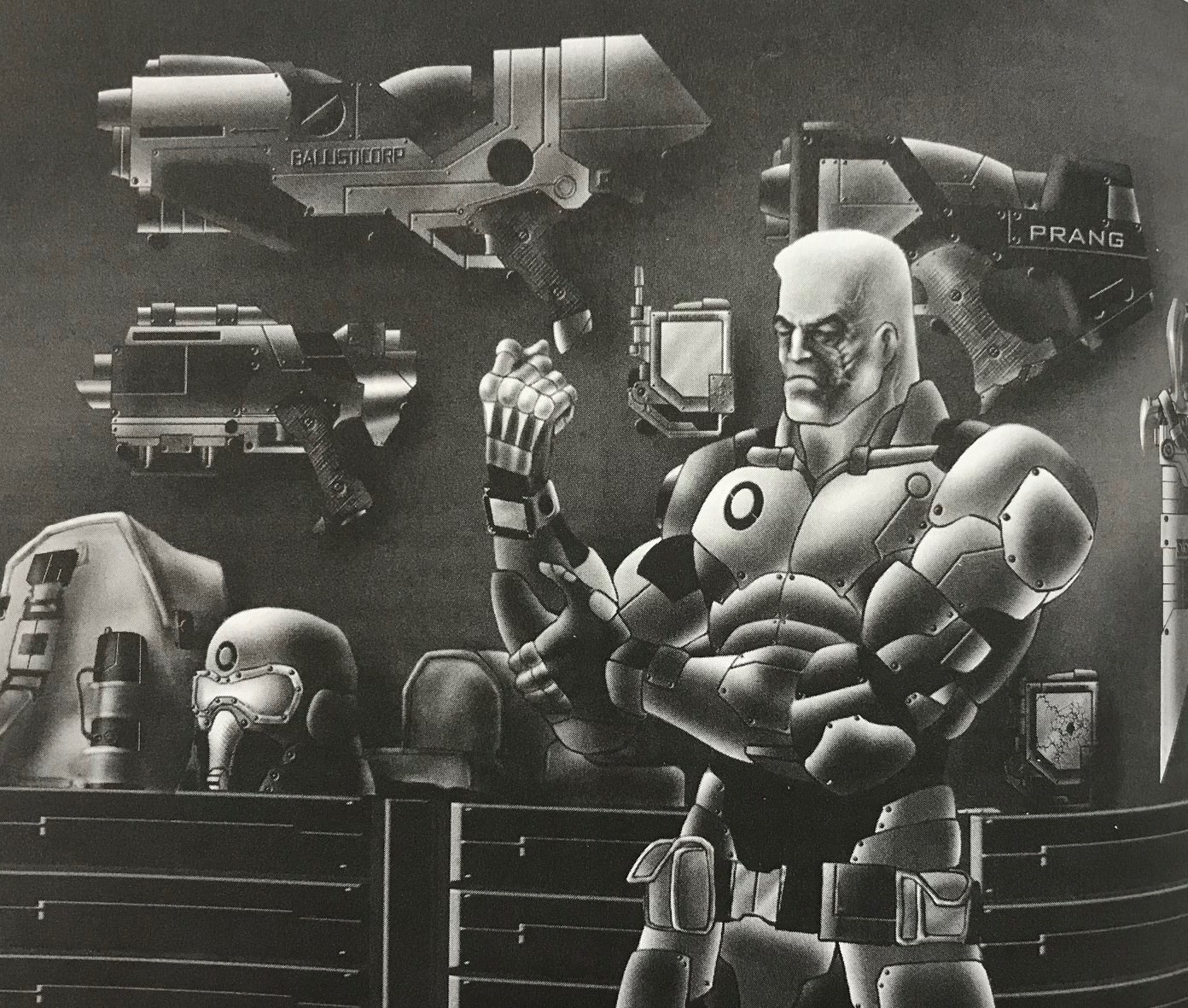
I like to imagine this man hunting these guns for his trophy room as they roam across the savannah in majestic herds
After that we get to the fun stuff; murders. Like anything else in the game, murders are a thing you can buy. A single assassination will run you 800 credits will an assassination of six people only runs you 2,000. Despite the game implying the Narrator can adjust these prices as appropriate the game says in no uncertain terms ”The price must be paid as follows”. There’s no odds of success here, though, so as written all you’re buying is an attempt and… that is it. There is not even a time frame for when this occurs either, so a particularly rude Narrator can just ignore all the money you spend on this stuff. Even sillier, in this section are rules for theft which state you simply pay 1/10 the items cost. If your Narrator allows this to succeed, there is no reason whatsoever to not just steal everything, and I mean everything, since a six-pack of murders is just as much an item as a briefcase.
On the note of briefcases, we’re introduced to a huge laundry list of items ranging from “a video camera which isn’t part of your cellphone”, “a walky talkie which isn’t your cellphone”, and my absolute favorite “a portable video-phone which is a distinct item entirely from your cellphone”. Also in here are some random upgrades to guns that are just poorly thought out such as being able to bolt as many barrels and scopes onto your gun as you can afford to holsters that make guns lighter even when the guns aren’t in them. A briefcase, for the record, has better armor values than a suit of power armor and a box for carrying grenades has armor almost that of a battle-tank.
One other oddity of this game is how money works. Everyone uses “Credbases” which are all-digital localized amounts of credits. This means when you go to the bank you are withdrawing digital credits from your account and transferring them to your credbase, so if you get robbed your money is unrecoverable and gone. It is extremely difficult to spoof your credbase ID but very easy to simply hack a credbase and steal all the money off of it or use the stolen credbase to impersonate someone else to avoid legal repercussions making the point of spoofing your ID completely pointless despite that being the much bigger crime. Obsidian, it seems, runs on Bitcoins.
After that it’s time to talk about prostitution and there is no mechanics whatsoever about why you would hire a prostitute but the game does have extremely thorough explanations of the prostitutes billing system and the various legal fees and stamps they need to collect. The important thing wedged into this section is this: every prostitute in the game has mid to high-tier military-grade combat enhancers and a personal firearm on them at all times making them absolute combat monsters.*
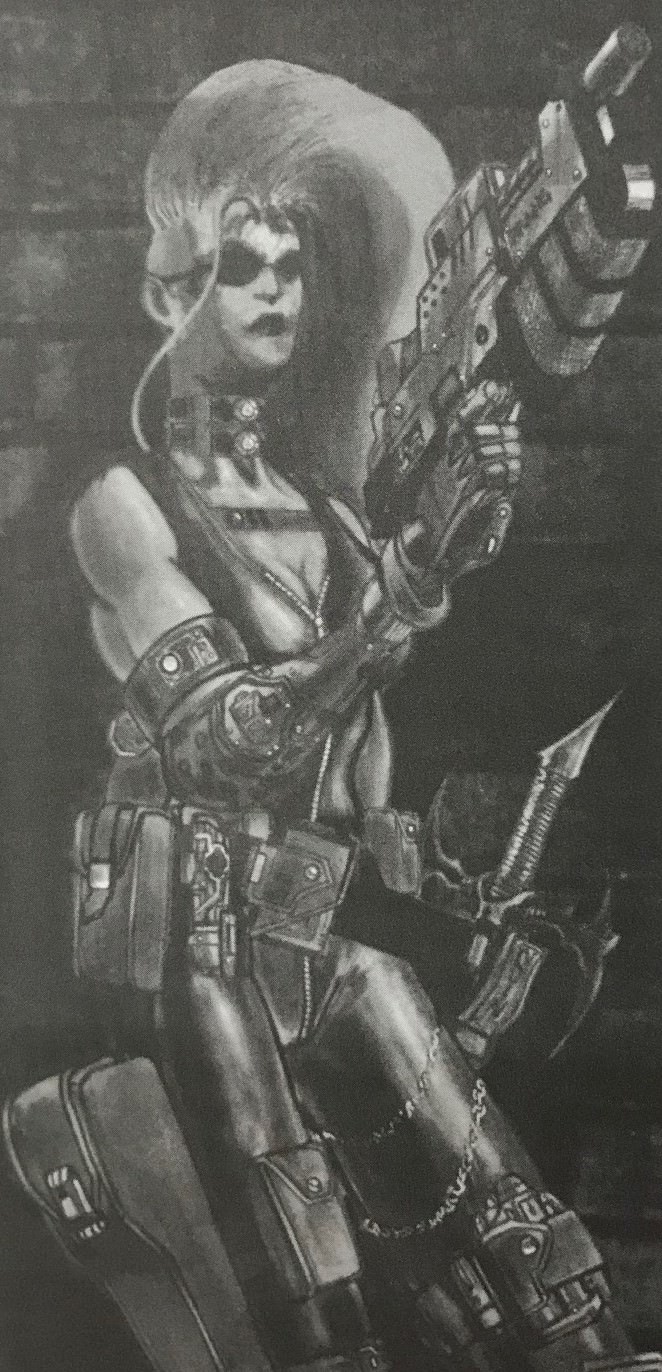
The two neck collars do nothing to hide her Giraffe ancestry
Armor follows up that section first with several paragraphs dedicated to the complete trap option “Soft Armor” which protect you from basically nothing in this game before segueing into “Hard Armors” which and “Mechanical Armors”. Hard Armor protects you just as good as Mechanical Armor but has no other benefits and has lots of fiddly rules and edge cases that will bite you and slow down play, while Mechanical Armors are what your party should be rocking at all times and their only major draw back, once you sort out the trap options, is being expensive. As you may recall, nothing in this game is that expensive so not only can starting characters easily have access to the best Mechanical Armors, even if they forego it at character creation after a session or two they’ll have the money.
The list of 25 guns is a similar exercise in trap options. All the guns have different abilities and weights and damage but no effort has been made to balance them against each other in the slightest. It does mean that you need to read every gun entry fully, but it also means the entire party will be using one gun, the Riot Control 13, as soon as they have the money which could be as soon as character creation. Special bonus trap points go the gun “Diagnostic Seven” which is more expensive, heavier, weaker, and no to hit bonus than any other gun in its tier because the fluff but not the rules state it is rarely modified to fire burst instead of single shot.
Next Time: If You Die in the Drug Trip, You Die In Real Life
*A starting character has a maximum five ranks in Dexterity. Prostitute by default have four to five ranks in dexterity, and depending on your Narrator, up to 8 ranks in it making them as deadly as Lazarus Manusmortem from earlier in this review.
If You Die in the Drug Trip, You Die In Real Life
Original SA post
Obsidian: The Age of Judgement is a roleplaying game by Apophis Consortium published first in 1999, and this review uses the 2nd Edition from 2001. Written by Micah Skaritka, Dav Harnish, and Frank Nolan. Obsidian is a post-apocalyptic anarchist corporatist literal hell on earth secret knowledge crunchy dice-pool game. It is purchasable online here if you’d like to support the authors of this work.
Part 14: If You Die in the Drug Trip, You Die In Real Life
With guns out of the way, time to look at bullets, and boy, are there are a lot of them to look at. There are six types of clips; one for each tier, one optional for tier 4 weapons, and flamethrower ammunition and all come with different prices and rounds in the clip. On top of that, there are 11 different types of special bullets we can load our clips with and absolutely no note that they aren’t capable of stacking effects. Missing rules also crop up here, with the rules for the flamethrower stating it deals bonus damage if an enemy is ignited, but there aren’t any rules for how an enemy becomes that. In a more amusing oversight, flamethrower ammo is also measured in rounds an as such can therefore use special bullets and thus Obsidian presents non-lethal fire.
With bullets done, it’s time to talk explosives. Obsidian dedicates two full pages just grendes with another half-page to detonators and is full of all sorts of florid descriptions of what each of these unique grenades do. It, ultimately, doesn’t really matter because basically every single one of these grenades will kill any human they hit no matter what you roll for damage. A character who rolled the maximum health possible at character generation and maxxed out health attribute and bought all the health upgrade cyberware has 56 HP versus a grenade which costs less than a walkie talkie dealing a minimum of 56 damage.
Enemy demons don’t stand a chance here either; the highest HP enemy has a maximum of around 80 health and 30 armor, but, high end grenades ignore all armor. It gets worse for the armies of hell, using a ranged weapon at point blank can never miss. So long as you roll a 2 or better on the damage roll, any character in the game can kill the most powerful minions of hell with no save as a suicide attack. Now imagine the player character assaulting the demon had the inhuman, and frankly immersion-breaking, ability to accurately throw a grenade 20 feet or more.
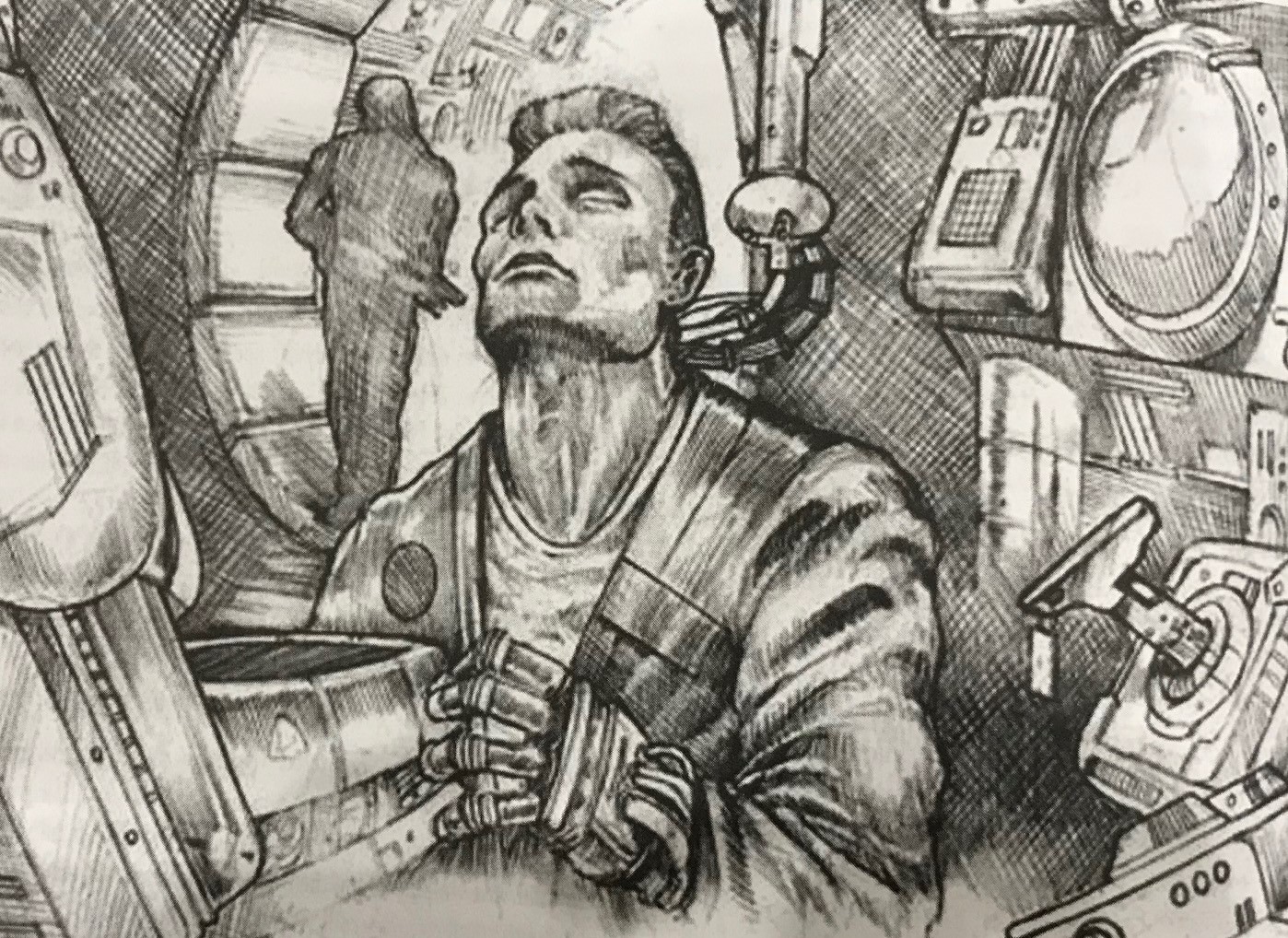
Uh, should, uh, should we come back later, Obsidian?
After the awesomeness of grenades you’d be forgiven for thinking detonators would be just as cool but instead they’re a hilariously bad idea for players to ever use in play. There are no specific “remote explosives” so to make a detonator you’re using your skills to slap a remote trigger onto a regular grenade. If you screw up even once, the grenade goes off in your face which as we just established is a one way ticket back to character creation.
Melee weapons then trundle in and they’re utter garbage. Get point blank to your foe who can now no longer miss you with their gun and with the mightiest melee weapon deal 1D10+Strength damage, assuming it isn’t absorbed by their body armor. For 150 credits cheaper than the sword you could have just bought a grenade.
Vehicles are up next and they’re the games only real money sink. The cheapest vehicle costs a little more than the absolute most expensive gun in the game, and for the cost of buying a single pick-up truck you could have kitted out an entire 4 person group in top-tier guns, body mods, and possibly armor. The richest people in the game have the monthly income to buy two stock sedans a month.
I say stock because there are 42 possible modifications to add to a vehicle not including weaponry and boy does that cost add up too. Not only are these things expensive, most of them are niche, underpowered, or both. An ordinance monitor can tell you if a gun has bullets in it, and only if the bullets are in the gun because an unloaded gun won’t trigger it, up to a distance of 50 feet. The disease monitor can tell you what disease are surrounding the vehicle, but confers no resistance against the diseases.
Blind spot indicators are a real thing you can buy in this game and they cost more than ordering an assassination
Cyberware is next, and as we established before most of this is junk. Each piece of cyberware reduces your humanity by a set amount, and dropping below certain breakpoints permanently reduces your characters abilities, “make you susceptible to following orders”, and also can just flat out kill. With only four points of humanity to spend before penalties kick in and extremely steep costs, high skill requirements, and in-legal approvals to collect few if any characters are going to dabble with any of the upgrades like “install a machine in your brain that can identify where you left your house keys” over “get +3 to your Dexterity stat”.
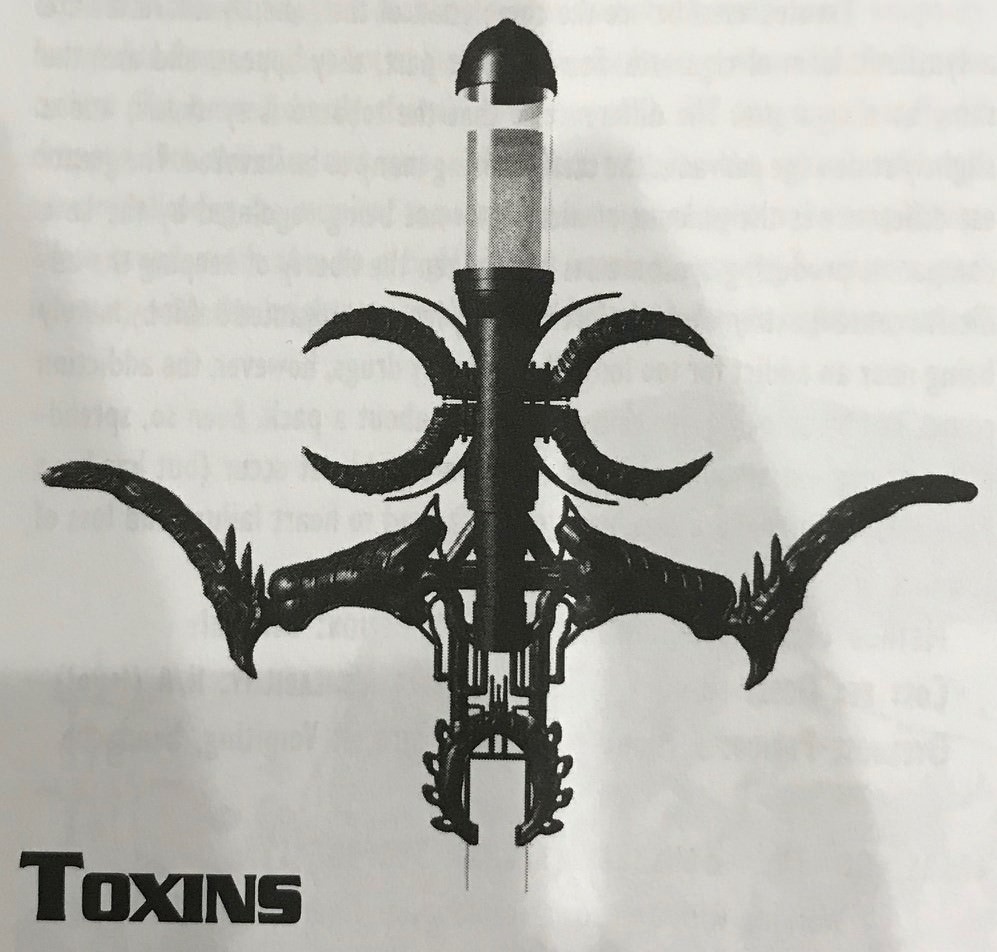
Doc, you sure that’s a normal needle
Security systems are then detailed but basically they all just boil down to a difficulty rating to bypass, a penalty for failing, and additional notes if there is some other way to bypass them beyond hacking. Pro-tip, don’t bother trying to hack them if you aren’t extremely skilled at it, the lowliest penalty has a pretty darn good shot at killing a starting character and the penalties only climb from there. I do mean climb; one of the higher difficulty securities deals 200 damage on a failed attempt to bypass it.
Finally we move onto the good stuff, drugs. All your favorite drugs are here from CrystalFix to N E U R O A C I D * to Ultra Methadone to Tears of the Banshee (Screamers). Few, if any of these drugs provide any concrete benefit to the player to take them or even why a random person on the street would ever want to take them. Worse, addiction is not a possibility, it is a guarantee with most characters being addicted after two uses of a drug and much, much more irritatingly you can never become un-addicted to a drug because the developers forgot to include those rules. The absolute stupidest thing is most drugs have absolutely dire OD effects like permanent stat loss, but due to the way addiction and the drugs work a player character will never, ever OD unless the person playing them chooses to do so for absolutely no reason.
The best drug, by the way, is N E U R O A C I D which gives you intense visions. If you fail a mental roll while on the drug, you succumb to whatever effects happen in the vision as if it were real. The implication is if you die in the drug hallucination you really die. The thing Obsidian overlooked, of course, is that its own description doesn’t imply all the trips are bad so what happens if my character trips out and imagines they are completely immune to all damage and fails the mental roll? What if they take more N E U R O A C I D in the dream? Does the original consciousness get messed up or does only the sub layer get affected?
Whoa.
Lastly it is time for toxins which are frankly a complete an utter waste of time. These things are pathetically weak compared to even basic guns and are nigh impossible to procure and have stringent methods of delivery and long delays to when they take effect. I mean, “Last Supper” sounds cool and all, but if I wanted to only deal 2d6 worth of damage to a foe I’d rather not waste time trying to trick them into drinking from a bubbling chalice or eating a sub-sandwich with devil horns.
Next Time: Build a Demon Workshop
*The spacing is the game’s, not mine
Build a Demon Workshop
Original SA post
Obsidian: The Age of Judgement is a roleplaying game by Apophis Consortium published first in 1999, and this review uses the 2nd Edition from 2001. Written by Micah Skaritka, Dav Harnish, and Frank Nolan. Obsidian is a post-apocalyptic anarchist corporatist literal hell on earth secret knowledge crunchy dice-pool game. It is purchasable online here if you’d like to support the authors of this work.
Part 15: Build a Demon Workshop
The extremely dull narrative that every chapter begins with continues here with our kultist protagonist going to a nightclub, watching people 90s rave-scene dance on each other, and then getting arrested by the cops. I’m barely reading these things anymore but does it remotely surprise you that our evil kultist who infiltrates society is named Barrabas? Yeah, me neither.
This chapter, called “Protagonists and Antagonists”, is where the actual information about how to stat up a monster, what weaponry the Law carries, and what rituals and rules people follow in society. Like the other chapters i its a grab bag of stuff but unlike other sections where there was little reason to be grouped together this one fits somewhat. If you want to know what kind of things the party is going to be fighting you can find it in this section alongside what a speeding ticket costs.
This section kicks off in earnest with a recap of the Darchomen, the super-human immortal mystics who run the show behind the scenes on humanities behalf. Despite the earlier books lore all of the sudden a bunch of them are dead and two of them, not just one, have betrayed the order so we are down to 35 total Darchomen. The book wants us to care that they can all talk to each other and pull the strings behind the Law, but as far as Shadowy Cabals go they’re pretty boring since they aren’t evil or corrupted in the slightest. They genuinely spend all day trying to do good, defeat the evil Darchomen, stop demons, and make sure society runs without them directly guiding it. They’re not even very interesting to fight because even with 5 ranks in every skill they’re otherwise just people. A group of fresh characters could kill one without breaking a sweat.
After that it is time to recap all nine circles of hell. Yes, this is the third time the book has provided us the backstory in paragraph form for each and every circle of hell and yes, this is the third time the stories conflict with each other. Did you know that the Circle of Avarice, formerly the Circle of Lust, has 8 ranks to its demonic hierarchy but the Box of Under has none? These are the sort of details you get in this section, because don’t forget, there aren’t any mechanisms or purpose for players to cross from Earth to these realms of hell that are being described.
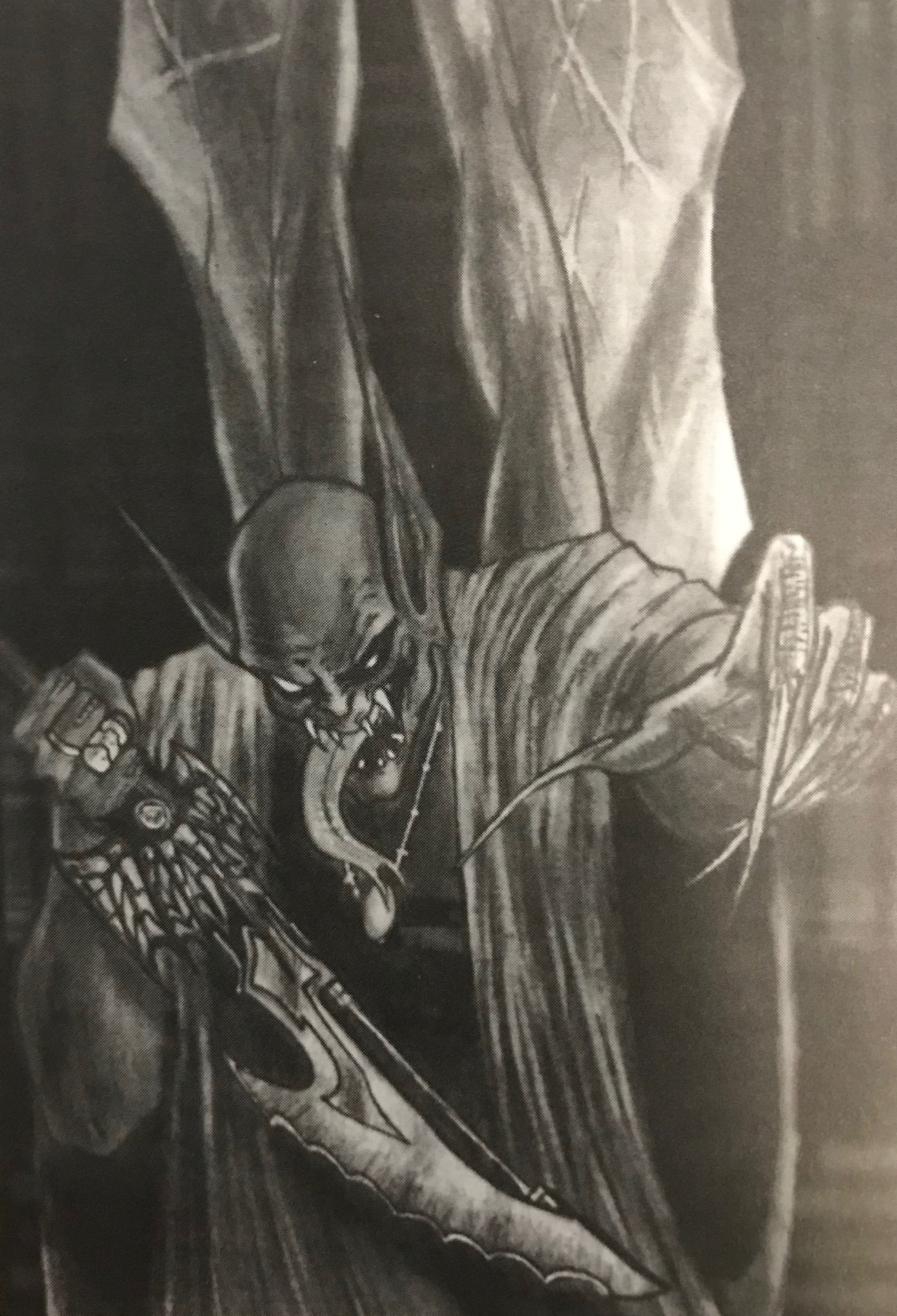
His wings are actually overcompensating for how small his knife is
With that recap of the history of places your players will never see out of the way, let us start summoning demons to do our will. Before you can have a demon and do unspeakable things*, you gotta pay a lot of fun taxes. First, you need to have a tome that describes the demon for you; no book, no summon. Next the tome you get has to have a occult score lower than your occult rank or you can’t summon it because it is too weird. Then you have to have enough spirit points to summon the demon, many of which will require more spirit points than you can keep on your person so go rope somebody else into your demon summoning. After that you need considerable time and a safe space to summon from. Then you need to lower the demon’s Aversion score by permanently spending Humanity points until you believe you can beat its new Aversion score using your Spirit score as a roll. If you beat its Aversion score, you can permanently spend one Spirit to make it loyal to you. If, on the other hand, you fail this roll, the demon drains your spirit till you die.
Did you succeed all that? Good, because every demon you summon has a terror rating and being its master doesn’t make you immune to that check, so it is very likely you summon something that instantly kills you.
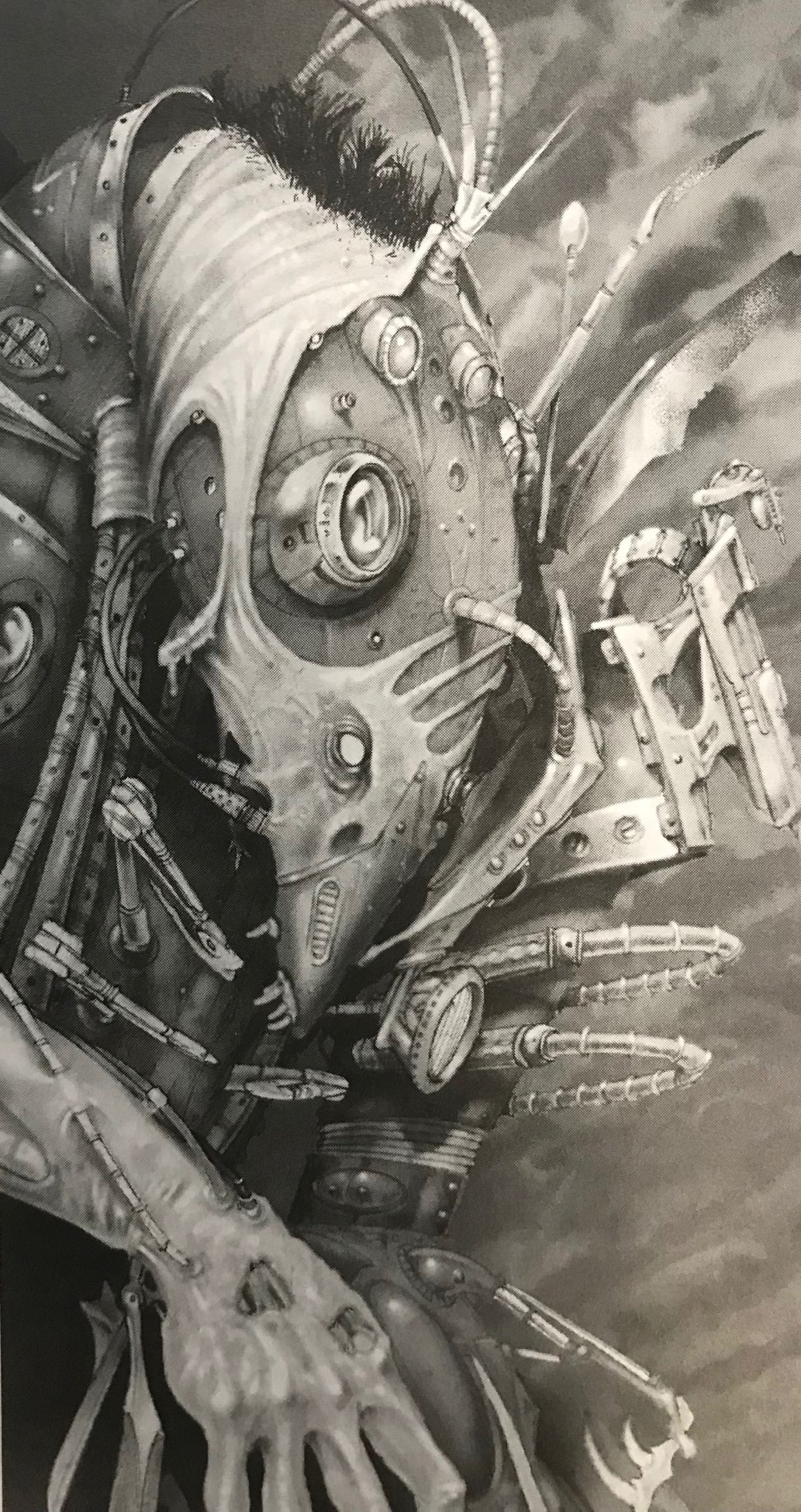
So what eye do I look at when I talk to you?
Ok, fine, we’ve jumped through enough hoops to be a trained seal and survived the Terror Rating, what do we get? Well, to be fair to Obsidian, you get to break the action economy entirely. Your demon is now utterly loyal barring you sending it away for no reason or letting it die, and acts just like any other character would in combat. How you’re supposed to share custody of a demon you had help summoning is an exercise left up to the reader and their divorce attorney.
The next ten pages of the book are then dedicated to how you can spend your demon’s creation points building them. There are tons of options and special rules demons follow for health, defense, and stats, but given it took me five seconds to combine “demon copies itself once per day with all stats intact” and “demons can buy an infinite number of ranks in “shoot people” for no additional cost per rank” this may not be a well balanced section. Do you want to make a demon who perfectly masquerades as a normal household appliance and so long as they touch the victim for two turns in a row warps them to a hell dimension where they are instantly destroyed permanently both body and soul? Of course you do, and don’t worry, you’ll still have points left over.
After that we get the games actual bestiary and, to be honest, most of these things are chumps you would never want to summon when you can build your own. They have terrible stat spreads, pathetic health, weak armor, and for the most part none of them would be able to handle a group of player characters much less a single one. A lot of them have extremely high endurance scores and other skills that, as written, do literally nothing for a demon and feels like the authors didn’t really pay attention to their own rules. The absolute highlight of this incongruity between the demon’s stats and how the game works is a demon with 0 dexterity that therefore can never take a turn in combat.
The descriptions of the demons are pretty boring, consisting of a grab bag of horror demon tropes like flayed skin, tentacles, and blood teeth. Each one is of course is the most horrible thing ever, but when they have defined scores for how scary they are that’s objectively not true. The scariest thing in this whole section is that the entry for Succubi noted that all of them are “ebony-skinned.”
Next Time: The Double-Secret Shadowy Cabal of Good
*Yes this entire section is useless if you play as humans who don’t want to cause the death of all mankind for no benefit to themselves.
The Double-Secret Shadowy Cabal of Good
Original SA post
Obsidian: The Age of Judgement is a roleplaying game by Apophis Consortium published first in 1999, and this review uses the 2nd Edition from 2001. Written by Micah Skaritka, Dav Harnish, and Frank Nolan. Obsidian is a post-apocalyptic anarchist corporatist literal hell on earth secret knowledge crunchy dice-pool game. It is purchasable online here if you’d like to support the authors of this work.
Part 16: The Double-Secret Shadowy Cabal of Good
Before we jump into the next part of the book, there is an enemy called the Technogarbage whose entire gimmick is it looks like any random broken or worn-down thing and waits to attack unsuspecting passersby. There are no rules for detecting these without using some sort of magical spell. It’s not a crime to fire your gun indiscriminately in city limits, so most play sessions will be increasingly paranoid players shooting any item you describe to them.
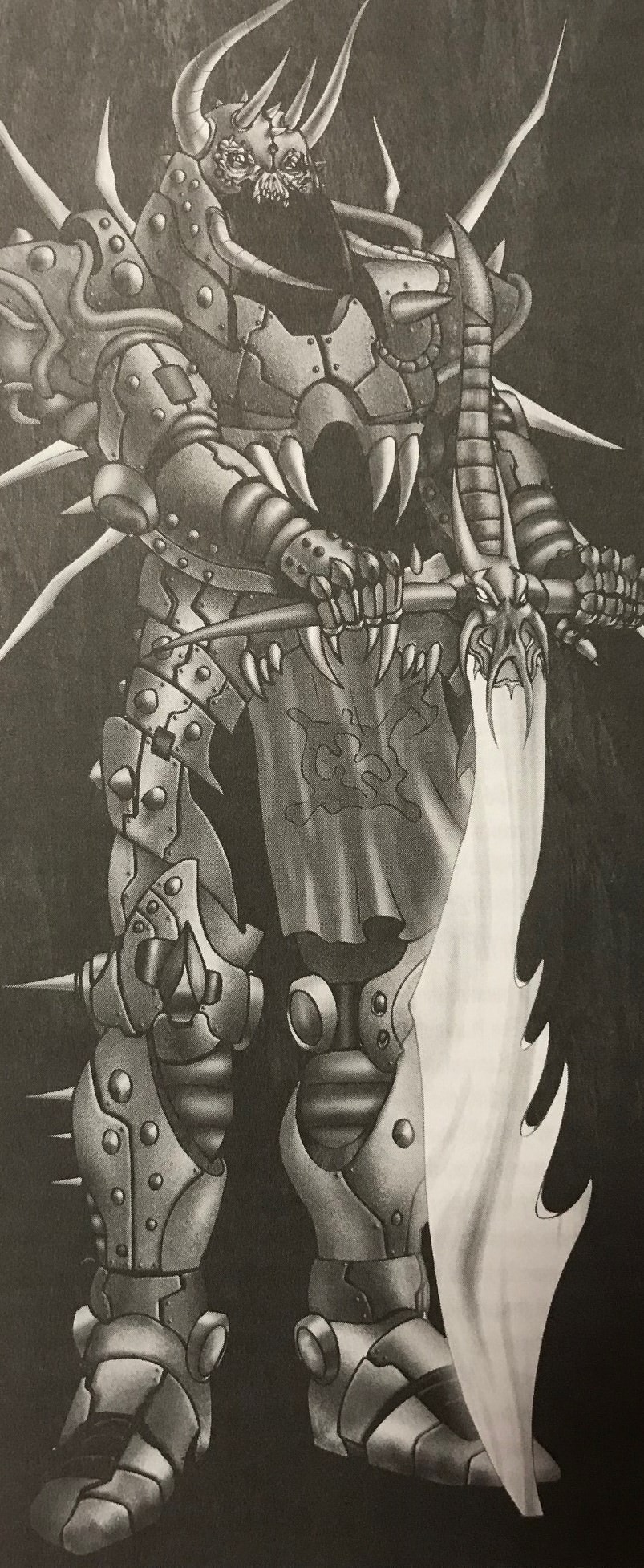
This guy has three upper jaws and no lower jaws. Seriously, count them
Anyway, with the rest of the game’s foes behind us, its time to introduce the
Their entire presence is through in the game notes 5-10 unstatted warriors who can undetectably travel through a parallel dimension never before mentioned. They don’t interact with anyone and only people who are in the Darchomen are aware they exist. Since the player isn’t aware of them and can’t detect them and they won’t talk with the player, the game has to point blank explain that mostly what they do is secretly kill anyone who they deem corrupt. While the game says these warriors can never be wrong, with everyone they kill infallibly being a Kultist or Demon, the game also notes that any human who uses a ritual for “their personal gain” is marked for death. What personal gain includes isn’t defined, so enjoy desperately arguing with your Narrator that using the ritual that makes food for you to eat or restores a limb you lost is not a personal gain.
Then, in what has become a recurring theme in these Christapocapunk games, an actual meta-plot approved goal for the game is buried in this section. Obsidian notes that somehow the Messengers of God can cause humans to evolve (never before discussed) to a new level (never described) to travel to their Circle (never explained how) in order to [reason not provided]. That isn’t a joke; the game says the following about the whole humans traveling to another dimension thing, quote, ”[...]but for what or how this is done is uncertain”
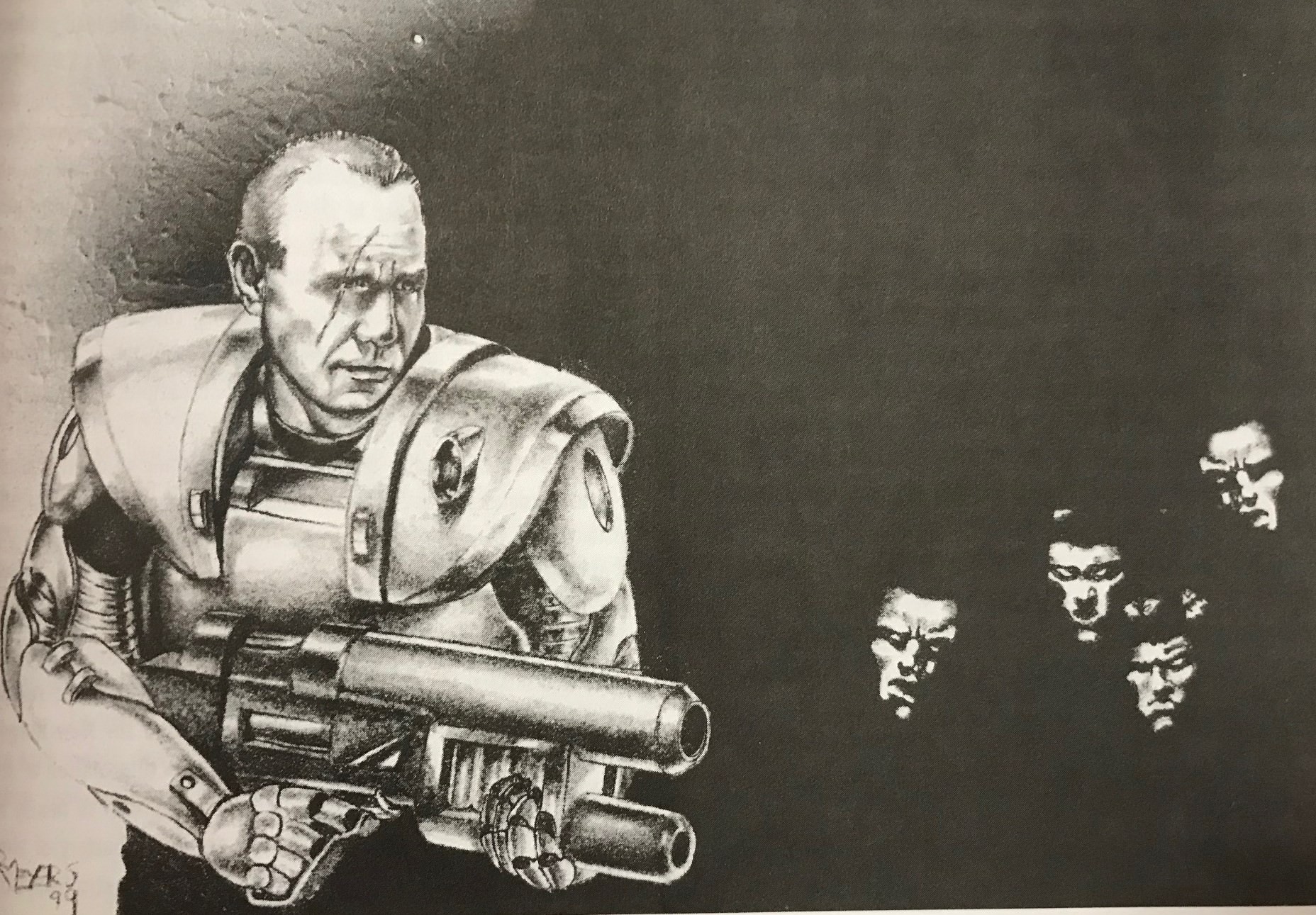
Little known fact the film Commando was initially pitched as a sequel to the music video for Bohemian Rhapsody
The next section in the book is a summary of the biggest corporations in the game world. Each of these can be summarized with “No, seriously, this is the biggest and most important one” to the point where if you do the math approximately 150% of the game world’s population are employed by these companies. Each business is basically a singular gimmick and maybe 3 of the 12 provided have anything resembling a gameplay hook, with one of the businesses being a hidden-agendaless mobile phone service provider that the game notes has never done anything illegal or wrong so have fun with that, players. Of course, being poorly conceived doesn’t mean there isn’t some real dumb stuff in here.
The first highlight is the company MediciTank which for an absolute pittance amount of money will, if the player paying the contract becomes incapacitated, dispatch a squad of heavily armed soldiers and tank to their location within five minutes with reinforcements called until the player character is retrieved. There are no rules here about the player character needing to be in any actual danger to trigger this absurd military response, so any player reading this section is assuredly going to find the nearest bad guys den and do some drugs until an unstoppable and unlimited killing force arrives to retrieve them.
The second is that in a setting where all-powerful angelic murder machines silently wander among humans destroying the sinners one of these companies is literally named SlaveFactory and the name is extremely non-ironic.
The third is just astounding. Guildus Interficiate* is our business built around assassinations in game, and Obsidian notes that it has 40,000 full-time employees. Hrm, thats a concrete number of employees, and the corporate rules were detailed enough we know what title and pay all of them have to have, so I wonder what would happen if we tried to figure out how many people per year they have to kill in order to make payroll?
Let’s Math!
There are two prices for an assassination in the game, and we’ll assume Guildus Interficiate as the premier service charges the more expensive number at 800 credits per kill. We’ll also assume that the Obsidian followed its corporation creation rules when making Guildus Interficiate so we’ll follow those when calculating how many employees there are at each of the ranks in the business. We can’t quite get to 40,000 even following the rules, but we can get to 39,995 which is honestly much closer than I expected when I started this exercise and frankly good enough.
Guildus Interficiate therefore consists of the following employees: 25,980 Acolyes, 6,495 Vanguards, 3,464 Circuits, 2,598 Neobellums, 1299 Bishops, and 1 Arch-Bishop. All of these people draw salary, except for the Arch-Bishop, and we know what positions pay as Obsidian said Guildus Interficiate is a Class 6 corporation and companies of a class all pay the same salary. This results in a total salary of 130,766,000 credits, and at 800 credits per assassination, Guildus Interficiate needs to kill 163,458 people to make payroll.
Per week
That’s right, the numbers for salary in this game are calculated on a weekly basis, meaning Guildus Interficiate needs to successfully claim the bounty on 8,499,790 people a year without even factoring in equipment, office space, or taxes. With a total population of only 60,000,000, Guildus Interficiate is assassinating approximately 14.2% of the entire human population annually just to make payroll, and they are noted as not being the only company in the assassination game just the biggest.
They have somehow been in business for 12 years.
Next Time: Wrong Airthswer
*Obsidians abuse of Latin continues, unabated
Wrong Airthswer
Original SA postminidracula posted:
Dr. Kroktagon.
If Dr. Kroktagon isnt an MMA themed super scientist crocodile this entire pun is wasted

Obsidian: The Age of Judgement is a roleplaying game by Apophis Consortium published first in 1999, and this review uses the 2nd Edition from 2001. Written by Micah Skaritka, Dav Harnish, and Frank Nolan. Obsidian is a post-apocalyptic anarchist corporatist literal hell on earth secret knowledge crunchy dice-pool game. It is purchasable online here if you’d like to support the authors of this work.
Part 17: Wrong Airthswer
With the settings major corporations out of the way it’s time to talk about the one players are most likely going to have run-ins with, The Law. The largest of the corporations*, The Law is the direct enforcement arm of the government, The Unity, and as such gets a lot of special rules. Almost half of these rules exist to prevent players from using any of the cool stuff The Law gets to do, so this section is lot of look-but-don’t-touch feature teasing. If you also guessed that Obsidian made The Law ridiculously evil, setting breaking, and overtuned combat monsters congratulations on your pattern recognition.
The first bundle of things The Law gets is a staggering pile of stats, cybernetics, and equipment. The stat block for a, quote, “Standard Officer (without armor)” is so over-equipped that it comes with armor. Not only do standard officers have magical armor that isn’t armor, they boast a stat-line better than players will be able to have with almost 20-30 sessions of maximum experience gain and custom gear and cybernetics that are actually good unlike the trash available to players. Of course, since combat in this game is entirely a matter of going first with a big gun, a player character solely built for combat will still wipe the floor with them, but a character built even mildly sub optimally will stand absolutely no chance against the cops.
The game then provides a rundown of all the specifics of this equipment, including the absolutely absurd cybernetic equipment that The Law gets. All of it is illegal for a player to posses, most won’t function even if they steal it, and most cause catastrophic humanity loss. To get around this for The Law, they get a special item players can’t have that removes all penalties for equipping cybernetic equipment. This sort of undermines a huge part of the setting and also isn’t clear why only The Law are allowed to have it since cybernetics aren’t illegal and by losing humanity from equipping them you slowly become a psychopathic murderer or catatonic murderer. Oh, if you do manage to kill an officer of the Law they explode in a 5d8 blast and all their equipment and cybernetics are destroyed.
We then get the rest of their equipment including the stultifyingly named “Holocaust Coat”, which is standard equipment for police investigators, and finally, 218 pages into this book, learn what the actual laws are that The Law enforce. These can basically be summed up as moving violations, destruction of property, theft, assault, murder, and 50 variations of not respecting the The Law.
There are unsurprisingly a lot of glaring issues with this list of laws. The punishment for theft, for instance, is ½ the value of the item but doesn’t say The Law takes it from you like it does for some other crimes so the implication is if you get caught stealing you just gotta give The Law their cut. Fraud isn’t a crime in any of its forms, and it is only illegal to forge or impersonate officers of The Law and their documents. It’s not a crime to brandish weapons, publish known lies, and its not clear if intellectual property or government secrets are even a thing so treason may not exist in this world but, hey, doing and selling drugs definitely aren’t crimes.
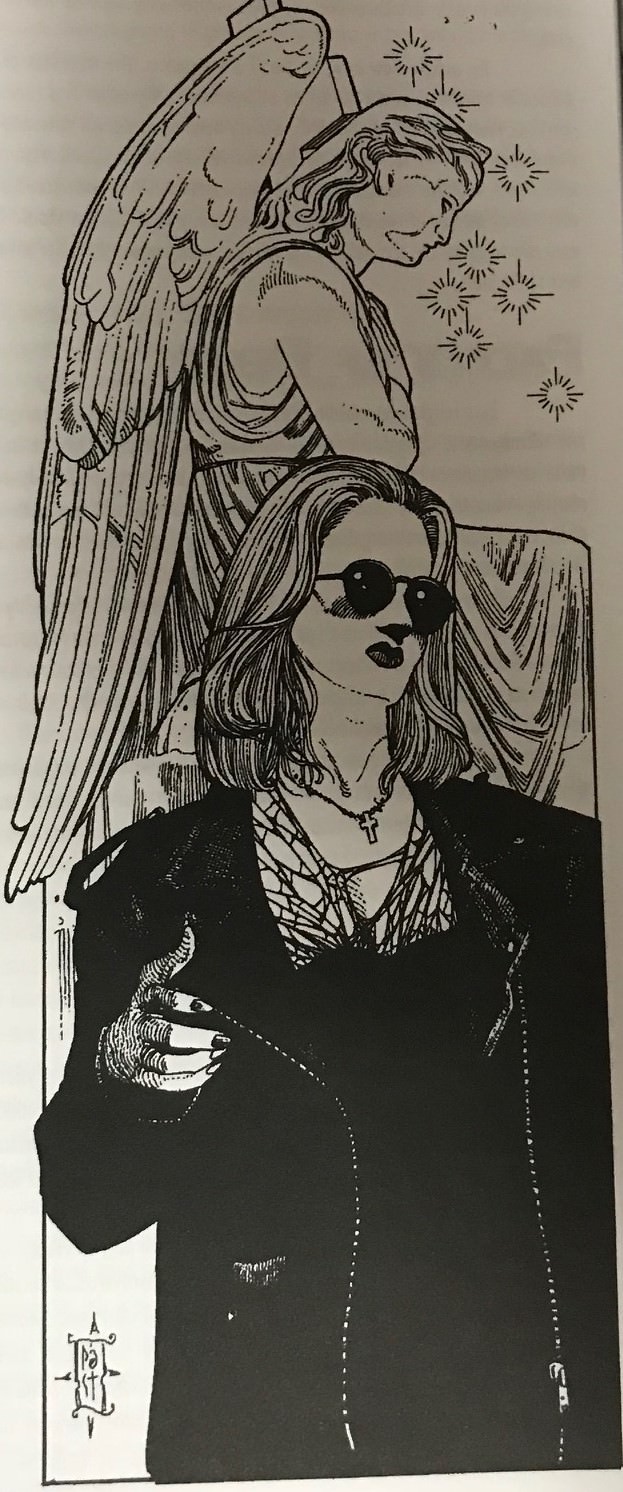
Does Vampire the Masquerade know you’re here?
Before we move on, we need to chat about implications in a game. You see, buried in the stat block for standard officers is a note that all of them are Mystics and have ritual points to distribute as the Narrator sees fit. In another section, it offhandedly remarks that The Law regularly and constantly uses the ritual school “Impulsus”. Impulsus lets you at a low level detect surface level thoughts and at high level, control other people as unwilling slaves.
It gets worse when you remember that a standard Law officer has high enough skills to not only read minds and control will at a distance, they have enough points left over to double-dip into the spell line that lets them permanently remove memories without a trace or cripple skills. In fact Obsidian notes that the reason the Darchomen, the secret power behind the public power behind The Law, are able to be a secret society is because they use The Law to obliterate the minds of any citizen who discovers the truth about them.
Oh also there are ritual spells that makes any item the caster touches reveal everything about where they are, what’s around them, etc. so you can plant bugs on anyone whose mind you erase to forget they’re carrying the item. Alternately, The Law also has access to the spell line where they can deal 2d8 damage, no save no resist, per object of yours they have in their possession with no time-limit or distance. With just two officers, The Law can mind control you into doing their bidding, plant a bug on you to find out where you go, then direct you gather all of your friends’ loose pocket change and bring it it back to them so they can remotely murder everyone you’ve ever known before erasing all the memories of this. If they bring in a third officer they can change your personality so thoroughly you’ll be happy to have done all this.
Remember, The Law and, more importantly, the people supplying them with these spells are supposed to be the good guys.
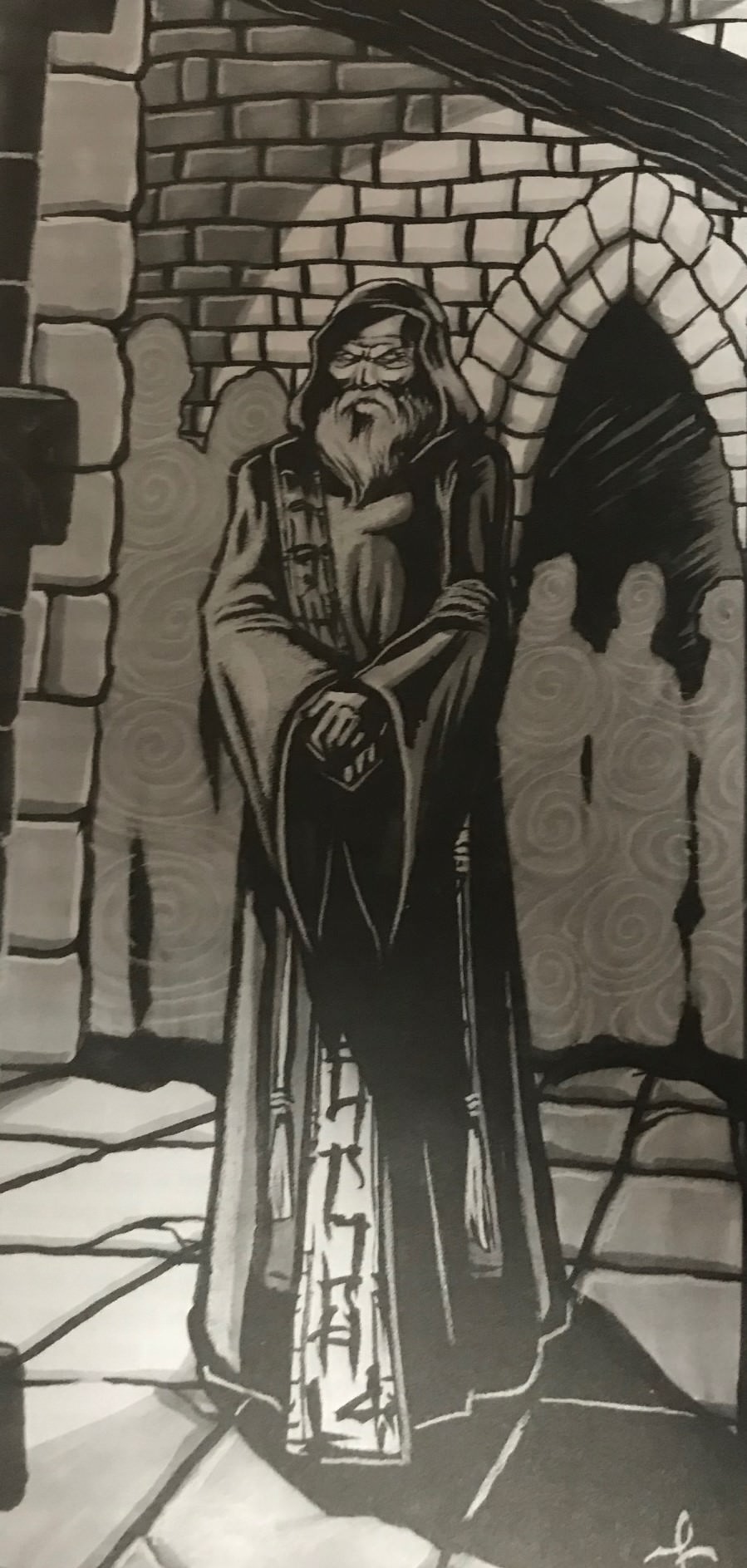
the wise man bowed his head solemnly and spoke: "theres actually zero difference between good & bad things. you imbecile. you f****** moron"
With The Law wrapped up, it’s time to talk about religion. Religions are very clunky mechanically, and in function are an optional fifth motivation for your character to earn experience by acting upon. Obsidian seems to think every player will jump right on these but all of them are game derailing and provide little benefit. Each religion except one caps out at providing 15-30 points of experience, require insane investments in both specific skills and narrative time, and many have additional requirements like “give up literally everything your character owns” or “never talk to a non-religion member again”. They also, of course, have completely conflicting goals and two of them end with player characters being rendered unplayable. Let’s dive in.
Religions
Gladius Oblivii
This religion teaches that the goal is to become one with oblivion, to the point where the final tier is called “Oblivion’s Concubine”. Somehow, this isn’t one of the religions that ends with you dying permanently, because while they stab you to death at one point they also resurrect you. To join you need to give up everything you own and the religion is extremely illegal.
Due to some extremely shoddy wording this religion can provide unlimited xp as when you hit maximum rank your reward is to get demoted to the bottom rank. As you already meet all the skill checks to advance ranks again all you need to do to hit max rank again is get murdered and resurrected, eat some human flesh provided for you, and recount how many people you killed. It’ll take a long time to hit max rank the first time, however, as it requires hundreds of xp and hundreds of spirits captured and spells cast.
The Heralds
This is the boring religion that’s about leading the faithful as a shepherd to their flock. Unsurprisingly you have to give up everything you own to join this group, and in addition to boosting a bunch of rather useless skills you need to gather a group of followers and train them to replace you as you go up the ranks.
You also must do a multi-year stint as a ghost who does nothing but carry messages from bishops to cardinals which is surely fantastic for party cohesion.
Testaments of Airthswer
This religion is the only “fun” one in that it is several very dumb but amusing things that also provides an actual tangible reward for characters who hit max rank by granting them everlasting life. This religion believes that all spirits will reincarnate into new bodies eventually, so the only crime is to destroy a spirit permanently, anything else is simply a minor speed-bump. This results in the Testaments of Airthswer seeing nothing wrong with shooting each other in the face over petty office politics or initiates getting questions about their holy texts wrong.
Outside of a bunch of immortals shooting each other in the face over not refilling the coffee pot, the other reason this is probably the best religion is because they’re the only one that explicitly comes into conflict with other groups in the setting. Since Kultists obliterate spirits to fuel their magic, the Testaments of Airthswer absolutely hate Kultists. Obsidian mentions that the Testaments of Airthswer will hold recruiting drives to lure in cultists, murder them all, and then hope they’ll be better people next go round.
The Order of Flesh Deviancy
Slap all the cybernetics into your body you possibly can, brethren! Ignore that this has mechanical penalties in-game which can kill you, because this religion offers no protection from that. For no reason at the second tier in the religion, and only at the second tier, you have to roll if you get free level ups to random knowledge skills and lose levels in random mind skills. Even more bizarre, the way you exit the second tier and enter the third means it is perfectly possible to never have to do any of the random rolling at all, and as such later when you learn the terrible secret of the cult not have actually done it and presumably BSOD the game because progressing after that point requires you to have fallen for it.
Remember how if a characters humanity drops too low your character is no longer playable? That’s the goal of this religion.
The Aliae Latent
This is the book-keeping religion, dedicated to gathering information to try to predict the future. It is also dedicated to not talking for an entire year at one rank, obeying all orders from direct superiors, and ignoring everything in your life that isn’t writing down your selected field of knowledge into a book. Members of this religion get no benefit or ability to predict the future.
This is probably the worst religion in terms of goals, as Obsidian explicitly notes their true goals, objectives, and progress are unknown and due to shoddy writing, there is no way to get to the highest rank in this religion to find out. They’re so inscrutable they don’t even care about Kultists or Mystics and don’t have any enemies they oppose on principle.
Temple of Profanis Concordance
If The Heralds were boring regular religion The Temple of Profanis Concordance is boring satanism. Build a flock, lure new members, oppose the mystics, recruit more members to serve you, and you get the drill.
Like the Aliae Latent, it is impossible to obtain the highest rank in this religion.
Congregation of Solifidian
The religion of preparing yourself to fight for The Messengers of God, the double secret cabal that runs humanity. The good news is this is the only religion to provide any concrete mechanical benefit. The bad news is the benefit is a flat bonus to your melee attack bonus so you’ll never, ever use it.
Actually, you’ll also probably never have a chance to use it either as after you’ve invested the several hundred xp to hit the maximum rank in the cult you disappear never to be seen again.
Next Time: Removing Your Appendix
*Except at the beginning of the book, where its total number of employees was given and was smaller than other corporations.
Removing Your Appendix
Original SA post
Obsidian: The Age of Judgement is a roleplaying game by Apophis Consortium published first in 1999, and this review uses the 2nd Edition from 2001. Written by Micah Skaritka, Dav Harnish, and Frank Nolan. Obsidian is a post-apocalyptic anarchist corporatist literal hell on earth secret knowledge crunchy dice-pool game. It is purchasable online here if you’d like to support the authors of this work.
Part 18: Removing Your Appendix
We start the Appendix with the last of the fluff narrative that has started every chapter in the book so far. It is three solid pages with an attempt to add urgency by breaking up the writing into what exact minute that those events were happening except there is nothing the time is counting down to and ultimately the time that everything happens at is completely irrelevant to the story. I’d spoil the ending but it is so nebulous and undefined that it reads less like a “To Be Continued” and more like a misprint where the rest of the story got left off the printing master-copy.
After that, Obsidian does the single most innovative and groundbreaking thing in the entire book: the section called “Appendix” includes multiple pages of non-optional core rules. Where a normal book would include these materials in the sections relevant to them and possibly mention that they exist, Obsidian takes bold new direction. Only a fool would want all the rules of spell casting to be near each other, instead of 148 pages apart and tucked away between a second list of items and the glossary.
Artifacts
Before we can get to the spell casting, we have to talk about artifacts. Unlike the advanced spell-casting, these were at least mentioned earlier even if they only appeared in a single character creation background and were implied to be purely fluff without any concrete mechanics. There are two kinds of these artifacts, Minor and Major.
Minor artifacts are relatively plentiful, with most having at least fifty or so copies and some running into the hundreds with more discovered all the time and players expected to eventually get some if not several. Major artifacts are all game-ending macguffins that promise to end the never before mentioned “Divinity Wars” and are expressly forbidden from the players to meaningfully possess. Quote: “Major Artifacts should never permanently come under the control of a Character”
So what do Minor Artifacts do? Not a whole lot really, with almost all of them being pretty crummy but you can at least stack as many of them as you want on a single character. One Minor Artifact, for instance, lets you destroy kult blades and suppress kult magic when you hold it, but once you destroy enough kult blades everyone has to make a terror rating check in its presence and with a Terror Rating of 30 minimum it is absolutely going to kill some players. Another lets you cast extremely bad and absurdly situational magical spells in exchange for losing one of your fingers forever, no regeneration. One of them references the Mayans which makes no sense because earlier the game established no character in the entire game setting would know who they were.
Of course, what would a section of flavorful, abundant items be without one that threatens to complete derail a game? One of the absolute most common minor artifacts is a sword with a unique property. When it deals any amount of damage to a good aligned kultists, instead it instantly no-save no-resurrection roll-another-character kills them. If you picked a good aligned kultist, or roughly half of all spellcasters in the book, you better hope your Narrator skipped the appendix section thinking they didn’t need to read it.
The Major Artifacts fare little better. Despite there being only five total Major Artifacts most have some combination of undefined powers, no rules on how to activate, or rules for what they would do if you managed to activate them. All that tiresome detail is instead replaced with spooky vague sentences like a ghost story stalling for time. The best one is the “War Drum of Sheol” that if played makes all demons loyal to you. The reason it’s the best is because it empirically doesn’t work because the backstory for how it got lost was the owner was killed by their own demons betraying them while they were playing it.
Arcane Rituals
After that it’s time for advance spellcasting. The game calls them “Arcane Rituals” and, in fairness, they actually are arcane. All of these rituals have mastery requirements of rituals learned earlier in the book, and are basically prestige magics. Most require two, but some require three separate rituals at different mastery ranks to unlock, making them a rather hefty investment. Even once you do have associated rituals learned, you’ll need to invest between 2-4 sessions of max XP just to learn them. If you didn’t read this section prior to building your character it’s very possible to end up with no “arcane rituals” at character creation and the only meaningful route to unlocking them requiring dozens of sessions XP.
It’d be really bad to have that happen, too, because a character with Arcane Rituals is flat out better than a regular caster. Arcane Rituals provide you an extra ritual that recharges at its own rate and your skill with it is governed by your highest ritual it consists of. This means an Arcane Ritual that requires a rank 7 ritual to cast are themselves therefore cast at a rank 7, and would have an entire extra ritual available to them in combat. With most of the rituals being lopsided in their requirements, i.e. requiring a rank 7 and a rank 1, system mastery is rewarded extensively here.
Further raising the value of these Arcane Rituals, a lot of them fill in gaps in a casters arsenal or push something they’re already good at into overdrive. Were you focused on avoiding damage and and making it hard for enemies to hit you? Congratulations you can now cast a damage causing sphere anywhere you can see that safely allows as many allied characters as you want to teleport through it.
This doesn’t mean they’re all worth building a character around, even if theyre all valuable. Some deal worse damage than the ritual they require to learn or do little else except give you a second slightly different cast of a ritual you already have. There is one absolutely awful one that is pure John Wick and he didn’t even work on the game. On a successful use of this power, you permanently lower one of the target’s skill of your choice by one rank. This can never, ever no matter what be recovered and the new number you lowered them to is their eternal maximum even if they have something that would boost it.
As we close out this section, it probably also won’t be much of a surprise to know that the rules regarding learning them don’t work right. Thanks missing rules and sloppy natural language. You’ll still need to invest some XP, but don’t worry about spending a year learning them, you only “may” need that much time!
With Artifacts and Arcane Rituals out of the way, the rest of the appendix is pretty standard. There is a glossary, an index, and a recap of the character creation and combat rules in highly truncated format. After that, all that remains are the character sheets ready and waiting to be photocopied, advertisements for a supplement that undermines the setting, and a novel whose selling point is it is at least 120 pages long.
And with that, thats Obsidian.